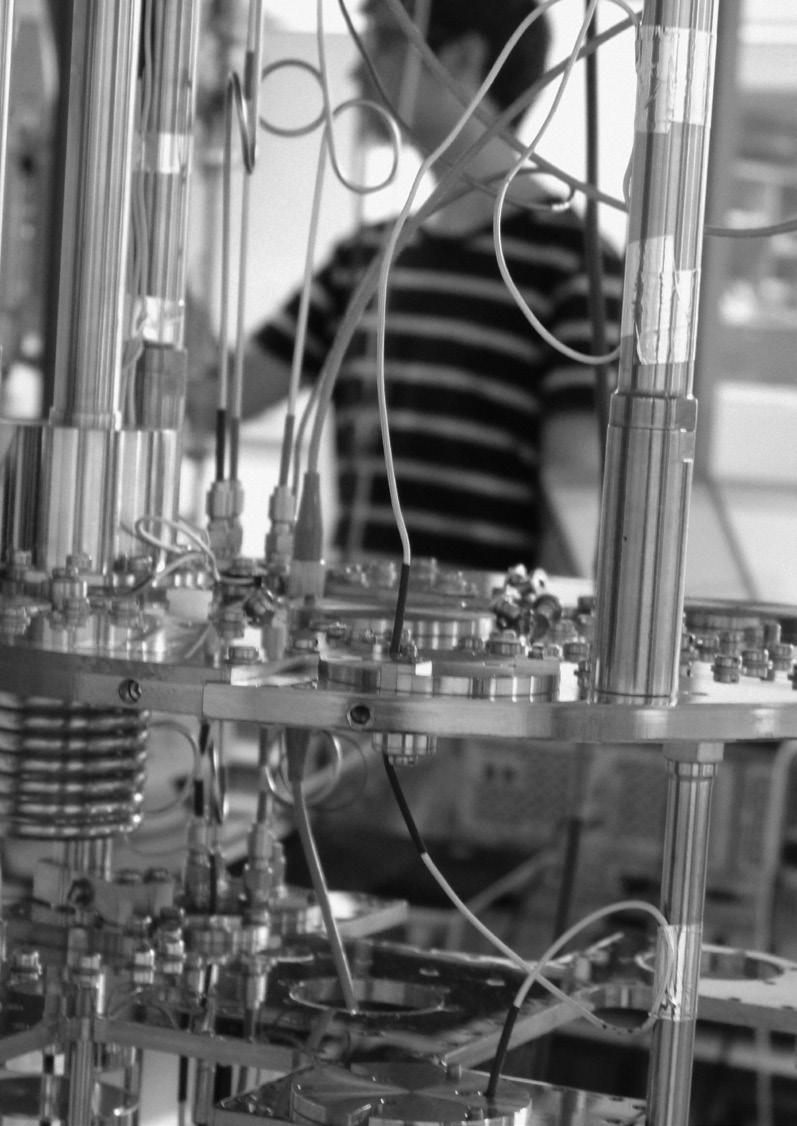

acknowledgements
The ARC Centre of Excellence for Dark Matter Particle Physics (Dark Matter Centre) acknowledges the support of the Australian Research Council.
We also acknowledge the financial and in-kind support provided by our collaborating organisations and partners.
COLLABORATING PARTNERS


INTERNATIONAL PARTNERS











The Dark Matter Centre acknowledges the Traditional Custodians of the lands and waters on which we work. We acknowledge and pay respects to the Elders and Traditional Owners of the land on which our Australian nodes stand. We pay our respects to their Elders, past, present, and emerging.
The Dark Matter Centre acknowledges AV Graphic Design for design services provided for the production of this Annual Report.
www.qdmlab.com
Cover photo: Dilution fridge image courtesy of the QDM Laboratory at UWA
advisory board chair message
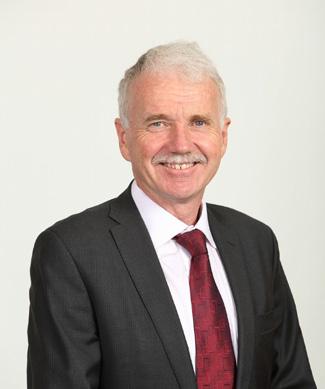
As it reached its mid-point in 2024, the ARC Centre of Excellence for Dark Matter Particle Physics continued its strong record of research, scientific career development, national and international collaboration, and outreach and education.
I was fortunate to be involved in the process of the Centre’s MidTerm Review and pleased with its performance against the ARC’s assessment criteria, meeting or exceeding expectations in almost all areas.
The Centre will move forward with renewed focus on the key areas identified in the review of increasing the number of female researchers within the team and ensuring the future impact of its research beyond the Centre’s closure.
The research section of this report provides a summary of Centre members’ efforts towards achieving our strategic aim of transforming our knowledge of the universe. I am pleased to note that the outstanding research conducted by Centre members has been recognised through prestigious awards, invitations to deliver plenary and keynote talks at leading conferences, and publications in highimpact journals.
In particular, the SABRE South experiment progressed significantly, the muon detector and data acquisition systems now continuously and smoothly taking data at the Stawell Underground Laboratory.
The publication of the SABRE South Technical Design Report will be of interest to the scientific community in Australia and internationally and I look forward to supporting the progress of this experiment as it begins taking data in 2025.
The Centre continued to build on successful its outreach and education activities such as the National Quantum & Dark Matter Road Trip, while implementing new initiatives including the Regional Partner Schools Program.
These activities reach students in Australia’s regional and remote parts of Australia with the aim of inspiring a future generation of scientists from traditionally under-represented areas, while also developing the communication skills of the Centre’s Early Career Researchers and students.
In 2024, we welcomed Sarah Pearce (Director of the SKA-Low Telescope) to the advisory board and I’m sure she will make a valuable contribution to the advisory board as it supports the Centre’s work.
I have enjoyed reading this report and congratulate everyone on their many achievements in the various activities of the Centre including research, outreach and translation. I look forward to what is to come in 2024.
Aidan Byrne
www.centredarkmatter.org
@ARC_DMPP
@CDMPP.org
ARC Centre of Excellence for Dark Matter Particle Physics
@arc_cdmpp
acronyms and abbreviations
Institutions:
ANSTO: Australian Nuclear Science and Technology Organisation
ANU: Australian National University
Caltech: California Institute of Technology
CNRS IN2P3: Centre National de la Recherche Scientifique -
National Institute of Nuclear and Particle Physics
DSTG: Defence Science and Technology Group
HZDR: Helmholtz-Zentrum Dresden-Rossendorf
INFN: Istituto Nazionale di Fisica Nucleare (Italian National Institute for Nuclear Physics)
LNGS: Laboratori Nazionali del Gran Sasso
MIT: Massachusetts Institute of Technology
SUT: Swinburne University of Technology
Stockholm: University of Stockholm
UoA: University of Adelaide
UAmst: University of Amsterdam
UFreib: University of Freiburg
UoM: University of Melbourne
UoS: University of Sydney
USheff: University of Sheffield
UWA: University of Western Australia
UWash: University of Washington
General:
AI: Associate Investigator
CDM: Centre for Dark Matter (abbrev for ARC Centre of Excellence for Dark Matter Particle Physics)
Centre: ARC Centre of Excellence for Dark Matter Particle Physics
CI: Chief Investigator
COO: Chief Operating Officer
ECR: Early Career Researcher
EDI: Equity, Diversity and Inclusion
KPIs: Key Performance Indicators
PI: Partner Investigator
Postdoc: Postdoctoral Researcher or Postdoctoral Research Associate
SABRE: Sodium Iodide with Active Background Rejection Experiment
SUPL: Stawell Underground Physics Laboratory


director’s message

2024 marked a significant milestone for the ARC Centre of Excellence for Dark Matter Particle Physics with the ARC’s coordination of our Centre’s Mid-Term Review. This comprehensive external assessment, led by an ARC Executive Director and two independent international experts, offered us a valuable opportunity to reflect on our achievements and to strategically plan for the remainder of the Centre’s term.
I am delighted that the review confirmed the Centre’s exceptional performance across nearly all ARC assessment criteria, with many areas exceeding expectations. Importantly, the ARC has confirmed continued funding for the remainder of the Centre’s term, providing us with the stability and resources needed to build on our successes.
Key highlights of 2024 include significant progress in strengthening and expanding our connections, fostering fresh insights and opening novel research opportunities that enrich the scope and impact of our dark matter particle physics program. Further details can be found in this report.
Our Centre continues to deliver world-leading research. This is achieved through the combined efforts of our talented researchers across multiple nodes and scientific themes, ensuring that we remain at the forefront of this rapidly evolving field. We have deepened our alignment and engagement with key international collaborators and strategic partners, maintaining active and fruitful interactions with leading organisations. Notably, the CNRS joined as a new Partner organisation this year.
SUPL has continued to serve as a critical hub for several flagship projects within the Centre. We have capitalised on opportunities offered by this unique infrastructure, which supports cutting-edge experiments and enables world-class research in low-background physics and dark matter detection. Significant progress has been made on SABRE South. In 2024, the SABRE South team successfully installed and commissioned the large muon veto system at SUPL, which has been actively taking data since then to characterise cosmic-ray muon backgrounds. This represents a major milestone, with data acquisition running smoothly and data transfer from SUPL to UoM computers for data analysis operating smoothly and reliably.
The Centre made significant advances in axion dark matter research in 2024. The Australian-based ORGAN experiment achieved worldleading sensitivity in a new axion parameter space, setting the most stringent limits to date. Meanwhile, the University of Swinburne group joined the ADMX collaboration, further strengthening the Centre’s efforts.
The Centre’s theory program achieved significant progress including refined models of dark matter particle interactions and their astrophysical signatures, such as studies exploring neutron stars as natural detectors of dark matter accumulation. Theoretical work also presented ideas connecting axion dark matter to neutrino mass generation, unifying different aspects of particle physics.
The nuclear metrology group made important progress developing an innovative method to measure Pb-210 contamination in NaI crystals. This advancement is critical for improving background characterisation and enhancing the sensitivity of direct detection dark matter searches.
We also celebrated success in securing competitive funding through three ARC Linkage Infrastructure, Equipment and Facilities (LIEF) grants, which have significantly enhanced our experimental capabilities, including substantial support for the CELLAR underground cryogenic facility at SUPL. Additionally, almost $380,000 was awarded to eleven projects spanning all Centre nodes through our Special Initiatives funding and DST Group support. These projects cover a broad spectrum of activities, including fundamental research, outreach, and community-building initiatives such as the XLZD-Oz workshop. This strategic investment has been instrumental in fostering innovative ideas and providing critical support to early career researchers throughout our network.
Gender equity and researcher recruitment remain central to our Centre’s mission. Throughout 2024, we have continued proactive efforts to increase the participation and leadership of female researchers across all levels, recognising the importance of diversity and inclusion in fostering a vibrant and innovative research environment.
Our outreach efforts in 2024 further strengthened, with increased engagement across remote, rural, and regional communities. New partner schools joined our programs, and our National Quantum & Dark Matter Road Trip was featured on 7 News, highlighting our commitment to broadening participation and inspiring the next generation of physicists.
In September, we held our annual ISAC meeting in Melbourne, welcoming Chair Dr Nigel Smith (TRIUMF) and Professor Tony Gherghetta (University of Minnesota). Their visit included productive meetings with the Centre’s Research and Executive Committees and a tour of SUPL. The ISAC members expressed strong approval of our mid-term review outcomes and emphasised the importance of sustained focus on SABRE’s delivery and the long-term sustainability of SUPL and our broader research community.
November saw the successful delivery of both our Early Career Researcher (ECR) and main annual workshops in Wollongong. These workshops fostered stimulating research discussions and invaluable networking, while also celebrating the vibrant culture within our Centre. Notably, members showcased diverse talents through musical, theatrical, and culinary expressions, enhancing our sense of community and collaboration.
As we enter the second phase of our journey, I am energized by the Centre’s achievements and the dedication of our members. We will continue to enhance our research excellence, foster inclusivity, and expand our impact both nationally and internationally.
As a final note, we remember with great sadness Professor Ian Shipsey, a cherished member of our International Scientific Advisory Committee, who passed away in October. Ian’s distinguished career and lasting contributions to experimental particle physics, quantum technologies, and public outreach inspired many and left a profound legacy within our community.
I encourage you to explore this report for a detailed account of the Centre’s progress and successes throughout 2024.
Elisabetta Barberio
Mid-Term Review highlights and actions
ARC Centres of Excellence undergo a rigourous and comprehensive external performance review that is conducted by the ARC in their fourth year of operation. The review panel evaluates the Centre’s performance against the ARC Centres of Excellence program objectives as well as specific Centre objectives and KPIs. Continuation of funding is dependent on the outcome of the review.
The Centre’s Mid-Term Review process commenced in April with written submissions to the ARC from the Centre, the University of Melbourne as the host organisation and other institutional stakeholders (node universities and partners). The second stage was a day of interviews by a panel chaired by ARC Executive Director and two expert international panellists. Following a tour of the University of Melbourne CDM facilities, the panel spoke with the Centre’s Executive Committee, Director, COO, Advisory Board Chair, SUPL Ltd Chair and a selection of PhD students and postdocs from across the Centre.
Even though there was a great deal of work involved, preparing for the Mid-Term Review was a valuable and rewarding experience for the Centre. It provided us with an opportunity to reflect holistically on what the Centre has achieved both in its research and broader objectives to date but also the growing research comminity that has been created. We thank all the Centre members, that gave up their time and contributed to the review, for their dedication and hard work.
Our Centre has performed exceptionally well against the ARC’s assessment criteria, with nearly all areas meeting or exceeding expectations. The panel’s report also confirmed funding for the remainder of the Centre’s term.
The review panel’s report highlighted several areas of which we are especially proud. One of the comments that stands out is a testament to our collective efforts in fostering a dynamic and inclusive research environment:
“The CDM has built a vibrant research environment and culture across its nodes and is providing excellent support and opportunities for its ECRs (graduate research students and postdocs), who all enthusiastically acknowledged the Centre’s importance and positive impact on their professional development and ongoing research work. The Centre’s outreach and public engagement activities are outstanding. It is clear that ECRs have a strong sense of belonging, and recognize a great value added to the Centre’s existence and role in their careers.”
The ARC and the review panel have expressed their desire for our Centre to succeed and emphasized the need for us to remain a strong voice with a clear direction in this field. They also noted the importance of our Centre’s international profile in the very competitive field of dark matter research.
There are only two key areas that identified the need for improvement: increasing the number of female researchers within our team, which is an ongoing challenge, and developing robust plans for our research beyond the Centre’s conclusion.
Moving forward, the panel identified a number of actions that must be implemented and a number of recommendations that warrant serious consideration. Their focus is on the crucial need to refine our strategic direction for the remaining years of the Centre. This will require close collaboration with the Research Committee, the International Scientific Advisory Committee, and the Centre’s executive team.
The Centre’s responsed to these actions and recommendations with new and refined activities and goals which will be realised in the remaining years of the Centre, and detailed in this and future annual reports. These include:
• Improved integration of collider research (LHC ATLAS) with other Centre activities to enhance the impact of the collider dark matter search efforts.
• Increased focus on areas where there are opportunities to lead the field, particularly where Australia has an advantage including quantum technology or astrophysics infrastructure. This includes adding new Associate Investigators and running combined workshops/meetings on novel detector technology and astrophysics. In 2024 we added ISAC and Advisory Board members with relevant expertise and talks and panels at the CDM Annual Workshop.
• Working with SUPL to strengthen international partnerships and collaborations including with the INFN and CNRS during their delegation visits to Australia and through the ISAC. In 2024, visiting speakers presented at the XLZD and Annual Workshops.
• Focus on funding opportunities and strategic partnerships that ensure the sustainability of the research beyond the end of the CentreNew process for decision making about future projects that maximises present assets and SUPL and ensures alignment of theoretical and experimental efforts with input from the ISAC.
• Increased focus on cross-institutional supervision of PhD students.
• Improved data collection relating to the diversity of new ECRs in the Centre in addition to gender to provide information on the ability of the Centre to attract international ECRs.
• Increased in-person workshops with both theorists and experimentalists. See XLZD workshop.
• Improved strategy for recruiting and retaining female researchers.
• Clearer pathways for training and managing disclosures and commercialisation pathways including via the creation of a new Research Translation Committee.
• Amendments to measuring impact of the Centre’s outreach and education activities incluidng amendments to relevant KPIs where needed.
strategy

The ARC Centre of Excellence for Dark Matter Particle Physics brings together experts from across Australia and internationally to unlock the secrets of dark matter, while also fostering the science and engineering leaders of the future. These objectives will be realised in the following ways in 2025:
1. Research Program – To transform our knowledge of the universe
• Undertake research to advance the Centre’s theoretical and experimental goals (for full details see Research Program sections and Research Activity Plan for 2025)
• Provide the legacy of a world-class underground physics facility that takes full advantage of Australia’s southern hemisphere location
• Finalise installation and commissioning of SABRE South in SUPL
• Extend the dark matter discovery potential of ORGAN and continue data taking, while expanding ADMX data analysis for axion dark matter searches
• Expand dark matter searches with the ATLAS experiment at the LHC and build the silicon inner tracker detctor for the HighLuminosity LHC upgrade
• Develop new theoretical models of dark matter and the frameworks underpinning novel strategies to test them through laboratory experiments and astrophysical observations
2. Outreach and Education – Inspire a new generation of scientists and engineers
• Continue to grow our education program with special emphasis on regional schools and expanding the school partners and outreach and education activities that promote diversity and inclusion
• Expand and strengthen international collaborations in Outreach through IPPOG and overseas connections
• Run National Quantum and Dark Matter Road Trip during National Science Week
• Continue collaboration with Science Gallery Melbourne and support Asia TOPA
• Engage with educators through professional development and teacher associations
• Work more closely with SUPL on aligned activities such as a SUPL livestream for national and international school students and teachers
3. Foster and develop the emerging scientific leaders of the future
• Run further rounds of Special Initiatives funding for students and ECRs
• Provide diverse training opportunities to Centre members
• Renew CoE Mentorloop platform membership and actively promote mentoring opportunities and training for students and ECRs
• Provide leadership opportunities for ECRs across the operations and research activities of the Centre
4. Develop new ideas, technologies and facilities for the next generation of dark matter experiments
• New theoretical ideas and vigorous R&D and prototyping for future dark matter experiments based in Australia and overseas including liquid Xenon detectors (XLZD/DARWIN), gas detectors for directional detection (CYGNUS-Oz), Axion detectors, superfluid and quantum technologies (see Research Program sections and Research Activity Plan for 2025)
• Commission and operate CELLAR platform to support ultralow-energy-threshold dark matter detectors and precision measurement experiments
• Develop new low background screening techniques for dark matter direct detection
5. Translate the new technologies to industry, defence and the public
• Provide training in innovative thinking to help translate discoveries into social and economic benefits including IdeaSquare
• Run the third round of funding for Centre members to apply for DST Group funding
6. and to do so in a cohesive national and international environment with a strong EDI program
• Strengthen national and international collaborations by continuing and expanding common projects and personnel exchanges with our partners
• Continue implementation of the Equity, Diversity and Inclusion action plan
→ Co-lead the InSTEM conference in Melbourne
→ Implement and train Contact Officers as part of the CDM Code of Conduct update
→ Run training for EDI committee and Centre members
28 August 2019
Centre awarded
14 August 2020
Centre commenced
22 September 2021
Centre launch

11 June 2024
ARC Mid-term review site visit
7 November 2024
ARC approval of Mid-term review and confirmation of funding for the remainder of the Centre.
March 2025
Current day
13 August 2027
Centre end date
governance
The Centre is hosted by the University of Melbourne, the largest research university in Australia. An overview of the management structure is provided in below and is designed to support a coordinated program of research and activities to deliver the Centre’s objectives.
Operation and Management
The Centre Director is Chief Investigator, Elisabetta Barberio, is responsible for the overall strategic direction and operation of the Centre, with advice from the relevant Centre committees.
The Director is supported by the Chief Operating Officer (COO), Anita Vecchies, who oversees the day-to-day operational matters of the Centre and also provides strategic advice to the Director. The COO oversees the Central Operations Team of professional staff who are responsible for the Centre’s financial management, human resources, outreach and education programs, event management, media and communications and preparation of annual reports and budget documents. Internal communications include fortnightly meetings and an enewsletter.
The Centre has six nodes, the University of Adelaide, the Australian National University, the University of Melbourne, Swinburne University of Technology, the University of Sydney and the University of Western Australia. Each node has a Node Manager, who is a member of the Centre’s Executive Committee.
The Central Operations Team works in collaboration with the node administrative team to ensure a coherent and coordinated approach to Centre-wide activities, financial management and reporting requirements.
Executive Committee
The Dark Matter Centre Executive Committee manages node interaction and cooperation and Centre resources. It also oversees the activities of the various portfolios with a particular interest in the sustantial gender equity, education, and outreach activities conducted by the Centre.
Led by the Centre Director, the Centre Executive Committee comprises Node Managers an the COO. One postdoctoral researcher from the Early Career Researcher Committee also attends the Executive Committee but does not have voting rights.
The Executive Committee is comprised of:
• Chair - Elisabetta Barberio (Director)
• Cedric Simenel (Deputy Director)
• Anthony Williams (Deputy Director)
• Celine Boehm (Node leader, UoS)
• Darren Croton (Node leader, SUT)
• Andrew Stuchbery (Node leader, ANU)
• Michael Tobar (Node leader, UWA)
• Raymond Volkas (Node leader, UoM)
• Martin White (Node leader, UoA)
• Anita Vecchies (COO)
• Giorgio Busoni (ECR representative UoA)
Research Committee
The role of the Research Committee is to oversee research at the Centre. It is responsible for the Centre’s scientific goals and performance indicators, and for building and maintaining the cross-node scientific research collaborations. The four Research Programs each have one Research Program Leader, with the exception of the Direct Detection Program which has two co-leaders due to the number and variety of experiments to be conducted. The Research Committee comprises the Centre Director, the Deputy Director and the Research Program Leaders.
The Research Program Leaders are drawn from a mixture of senior and midcareer researchers, as part of our ongoing succession planning strategy. During the course of the Centre it is foreseen that junior researchers exhibiting strong research leadership is mentored to gradually replace the more senior of the program leaders.
The Research Committee is comprised of:
• Chair - Elisabetta Barberio (Director)
• Cedric Simenel (Deputy Director)
• Anthony Williams (Deputy Director)
• Phillip Urquijo and Michael Tobar (Direct Detection Leaders)
• Steve Tims (Precision Metrology Leader)
• Nicole Bell (Theory Leader)
• Paul Jackson (LHC Leader)
• Robert James (ECR representative, postdoc - UoM)
• Victoria Bashu (ECR representative, PhD student - ANU)
Advisory Board
The Centre’s Advisory Board assists the Centre Director by contributing to the development of strategies and vision for the future and by serving as a vehicle for creating better linkages between academia, industry, and government.
The Advisory Board is comprised of:
• Chair – Aidan Byrne (University of Queensland Provost, Past CEO of the Australian Research Council)
• Sue Barrel (former Chief Scientist at the Bureau of Meteorology)
• Campbell Olsen (CEO of Arete Capital Partners; major shareholder of Stawell Gold Mine)
• Sarah Pearce (Director of the SKA-Low Telescope)
• Len Sciacca (Enterprise Professor, Defence Science & Technology, University of Melbourne)
• Robyn Williams (ABC science journalist and presenter)
• Justin Zobel (Pro Vice-Chancellor, Graduate & International Research, Chancellery (Research and Enterprise), the University of Melbourne)
International Scientific Advisory Committee (ISAC)
The role of the International Scientific Advisory Committee is to mentor the Director, the Executive Committee and the Research Management Committee on the scientific program and directions of the Centre. It provides advice to the Director on important emerging new directions in the field of the Centre and on the highest priorities for the allocation of Special Initiatives funds each year.
The International Scientific Advisory Committee is comprised of:
• Chair – Nigel Smith (Director, SNOLAB)
• Elena Aprile (Columbia University, spokesperson of the XENON Dark Matter Experiment)
• Tom Browder (University of Hawaii, USA Spokesperson of Belle II)
• Stephen Buckman (Australian National University)
• Aaron Chou (Leader of axion dark matter group at Fermilab, USA)
• Priscilla Cushman (University of Minnesota; Spokesperson of SuperCDMSSNOLAB)
• Giuliana Fiorillo (University of Naples)
• Tony Gherghetta (University of Minnesota)
• Karoline Schäffner (Research Group leader of the COSINUS Dark Matter Search, Max-Planck Institute for Physics)
Equity, Diversity and Inclusion (EDI) Committee
The role of the EDI Committee is to “PROCLAIM”:
P: Propose EDI targeted initiatives such as seminars and fellowships
R: Report on EDI activities of the Centre for the annual report
O: Organise EDI events such as training and dedicated workshops
C: Communicate through the website and presentations at Centre events
L: Listen and be a point of contact
A: Advocate EDI best practices via outreach and social media
I: Identify EDI challenges in the Centre and the Dark Matter scientific community
M: Monitor the evolution with respect to the KPI of the Centre
The Equity, Diversity and Inclusion Committee is comprised of:
• Chair – Martin White (UoA)
• Deputy Chair – Jade McKenzie (UoM)
• Michaela Froehlich (ANU)
• Theresa Früth (UoS)
• Renee Key (SUT)
• Navneet Krishnan (ANU)
• Haylea Purnell (UoA)
• Zuzana Slavkovska (ANU)
• Michael Tobar (UWA)
• Phillip Urquijo (UoM)
• Cindy Zhao (UWA)
Mentoring & Careers Committee
Established to coordinate mentoring and training opportunities for early and mid-career researchers in the Centre, the Mentroing & Careers Committee is comprised of:
• Chair – Darren Croton (SUT)
• Deputy Chair - Michaela Froehlich (ANU)
• Irene Bolognino (UoA)
• Maxim Goryachev (UWA)
• Chiara (Maria) Lisotti (UoS)
• Jayden Newstead (UoM)
Early Career Researcher Committee
Established in order to allow Early Career Researchers (ECRs) to provide input into the Centre, the ECR committee is elected by the Centre’s ECRs and is reviewed annually. The Committee members sit in on the Executive and Research Committees (as outlined above), help coordinate activities targeted to ECRs including the annual ECR workshop, provide regular updates to key committees/groups of the Centre and also represent their peers by seeking their input via surveys and other methods of communication. In 2024 the members were:
• Giorgio Busoni (UoA)
• Robert James (UoM)
• Victoria Bashu (ANU)
centre membership snapshot
These numbers include people were Centre members for all or part of 2024. Members are counted in in multiple categories if their role in the Centre changed during the year.
The following people were Centre members during 2024. Members may appear in multiple categories if their role in the Centre changed during the year.
Director
Elisabetta Barberio (UoM)
Chief Investigators
Elisabetta Barberio (UoM)
Nicole Bell (UoM)
Celine Boehm (UoS)
Darren Croton (SUT)
Matthew Dolan (UoM)
Alan Duffy (SUT)
Maxim Goryachev (UWA)
Gary Hill (UoA)
Paul Jackson (UoA)
Greg Lane (ANU)
Jeremy Mould (SUT)
Cedric Simenel (ANU)
Andrew Stuchbery (ANU)
Geoffrey Taylor (UoM)
Steve Tims (ANU)
Anthony Thomas (UoA)
Michael Tobar (UWA)
Phillip Urquijo (UoM)
Raymond Volkas (UoM)
Martin White (UoA)
Anthony Williams (UoA)
Academic Staff
Irene Bolognino (UoA)
Michaela Froehlich (ANU)
Theresa Früth (UoS)
Associate Investigators
Paul Altin (ANU)
Laura Baudis (University of Zurich)
Greg Boyle (James Cook University)
Geoffrey Brooks (SUT)
Jeremy Brown (SUT)
Ben Buchler (ANU)
Frank Calaprice (Princeton)
William Campbell (UWA)
Zhenwei Cao (SUT)
Peter Cox (UoM)
Sara Diglio (CNRS IN2P3)
Caterina Doglioni (CNRS France)
Nathan Garland (Griffith University)
Zengwei Ge (SICCAS)
Julia Gonski (SLAC National Accelerator Laboratory)
Eugene Ivanov (UWA)
Ayse Kizilersu (UoA)
Dominik Koll (ANU and HZDR)
Shanti Krishnan (SUT)
Grace Lawrence (UCL)
Justin Leontini (SUT)
Laura Manenti (UoS)
Ian McArthur (UWA)
Peter McNamara (University of Toronto)
Victoria Millar (UoM)
Kim Mintern-Lane (SUPL Ltd)
Francesco Nuti (UoM)
Ciaran O’Hare (UoS)
Chris Power (UWA)
Peter Quinn (UWA)
Pat Rajeev (SUT)
Marc Schumann (Ufreib)
Dipan Sengupta (UNSW)
Edward Taylor (SUT)
Andrea Thamm (UoM)
Christine Thong (SUT)
Claudia Tomei (INFN Roma)
Marurizio Toscano (UoM)
Jan Van Driel (UoM)
Christian Weiser (Ufreib)
Roland White (James Cook University)
Shihai Yue (SICCAS)
Cindy Zhao (UWA)
Yong Zhu (SICCAS)
Madeleine Zurowski (University of Toronto)
Partner Investigators
Gianfranco Bertone (UAmst)
Marcella Diemoz (INFN)
Sara Diglio (CNRS IN2P3)
Philip Hopkins (Caltech)
Michael Hotchkis (ANSTO)
Aldo Ianni (INFN)
Karl Jakobs (UFreib)
Damian Marinaro (DSTG)
Gray Rybka (UWash)
Luca Scotto Lavina (CNRS IN2P3)
Tracy Slatyer (MIT)
Neil Spooner (USheff)
Anton Wallner (HZDR)
Frank Wilczek (Stockholm)
Postdoctoral Researchers (Funded)
Adam Batten (SUT)
Lindsey Bignell (ANU)
Jeremy Bourhill (UWA)
Giorgio Busoni (ANU)
Graeme Flower (UWA)
Michaela Froehlich (ANU)
John Gargalionis (UoA)
Avirup Ghosh (UoM)
Robert James (UoM)
Kamiel Janssens (UoA)
Tarak Nath Maity (UoS)
Ben McAllister (SUT)
Peter McNamara (ANU)
William Melbourne (UoM)
Robert Mostoghiu Paun (SUT)
Jayden Newstead (UoM)
Harish Potti (UoA)
Aaron Quiskamp (UWA)
Federico Scutti (SUT)
Dipan Sengupta (UoA)
Ellen Sirks (UoS)
Zuzana Slavkovska (ANU)
Xuan-Gong Wang (UoA)
Yajing Xing (UoM)
Postdoctoral Researchers (Affiliated)
Eiasha Waheed (UoM)
Alexander Woodcock (UoA)
Students
PhD
Raghda Abdel Khaleq (ANU)
Camron Alley (UoA)
Marina Bazyk (UoM)
Amrita Banerjee (SUT)
Victoria Bashu (ANU)
Michael Bradley (SUT)
William Campbell (UWA)
Isabel Carr (UoM)
Sen Sam Chhun (UoM)
Robert Crew (UWA)
Dylan Dance (SUT)
Ferdos Dastgiri (ANU)
Aman Desai (UoA)
Mitchell Dixon (SUT)
Matthew Fewell (UoA)
Emily Filmer (UoA)
Gangyong Fu (UoM)
James Gallagher (UoA)
Kenn Goh (UoA)
Charles Grant (UoA)
Matthew Green (UoA)
Cameron Harris (UoA)
Elrina Hartman (UWA)
Maaz Hayat (UoM)
Fredrick Hiskens (UoM)
Liam Hockley (UoA)
Tyler Hughes (SUT)
Nicholas Hunt-Smith (UoA)
Vanshika Kansal (SUT)
Sharry Kapoor (UoS)
Renee Key (SUT)
Albert Kong (UoA)
Navneet Krishnan (ANU)
Judith Kull (UoA)
Kyle Leaver (UoA)
Nicholas Leerdam (UoA)
Jesper Leong (UoA)
Maria Chiara Lisotti (UoS)
Bill Loizos (UoA)
Emily McDonald (UoM)
Lachlan McKie (UoA)
Michael Mews (UoM)
Lachlan Milligan (UoM)
Shiryo Owa (UoA)
Hitarthi Pandya (UoA)
Subrahmanya Saichan (Sai) Pemmaraju (UoM)
Rafael Perez (UoM)
Thu Le Ha (Joni) Pham (UoM)
Lorenzo Principe (UoM)
Haylea Purnell (UoA)
Aaron Quiskamp (UWA)
Ananthakrishnan Ravindran (UoM)
Alex Ritter (UoM)
Tristan Ruggeri (UoA)
Kieran Rule (UoM)
Matthew Rumley (UoA)
Steven Samuels (UWA)
Iman Shaukat Ali (UoM)
Raj Aryan Singh (SUT)
Alexander (Alexei) Sopov (UoM)
Nathan Spinks (ANU)
Owen Stanley (UoM)
Edmund Ting (UoA)
Adam Ussing (SUT)
Thomas Venville (ANU)
Michael Virgato (UoM)
Scott Williams (UoM)
Joshua Wood (UoM)
Yiyi Zhong (ANU)
MPhil
Nathanael Botten (UoA)
Joshua Gill (UoA)
Duncan McClay (UoA)
Georgy Sanamyan (UoA)
Ewan Wallace (UoA)
Masters
Vishal Ayyagari (UoM)
Sen Sam Chhun (UoM)
Samarth Paraskum Gohel (UoM)
Eden Isaac (UoM)
Akshayan Manivannan (UoM)
Aphisit Nanphakdi (UoM)
Jamie Papworth-Dent (UoM)
Aspen Reardon (UoM)
Teehani Ralph (UWA)
Neal Salan (SUT)
Lucia Stockdale (UoM)
Willem Van der Craats (UoM)
Michael Verde (UoM)
Jinyi Wu (UoM)
Ho Man Yim (UoM)
Honours
Jake Felix (UoA)
Zac Greenfield (UoS)
Michael Hatzon (UWA)
Kael Kemp (UoA)
Finn Edward Pelling (UoA)
Riya Raizada (UoS)
Amelie Read (UoS)
Paige Taylor (SUT)
Emily Waterman (UWA)
Rickson Wielian (ANU)
Technical Staff
Scott Collins (SUT)
Padric McGee (UoA)
Adam Sarbutt (UoM)
Abirami Subramaniam (UoM)
Daniel Tempra (ANU)
Raffaele Timpano (SUT)
Tom Tunningley (ANU)
Craig Webster (SUT)
Professional Staff
Linda Barbour (UWA Administration)
Jackie Bondell (Senior Education and Outreach Coordinator)
Emily Campbell (UoA Administration)
Madeleine Hess (Administration Officer)
Aline Lorieri (Administration Officer)
Jade McKenzie (Database Administrator)
Fleur Morrison (Communications and Media Officer)
Mary Odlum (Finance Manager)
Simon Parsons (SUT Administration)
Petra Rickman (ANU Administration)
Kathryn Ryan (UoM Administration)
Silvana Santucci (UoA Administration)
Anita Vecchies (Chief Operating Officer)
Vacation students funded by the Centre
Bich Tien Le (SUT)
Subrahmanya Saicharan (Sai) Pemmaraju (ANU)
Joshua Perks (UoA)
Paige Taylor (SUT)
Cameron Taylor (UoM)
Aidan Yuen-Oye (UWA)


linkages and collaborations
In 2024, Centre members were able to restablish and build upon their national and international collaborations with many opportunities to interact in person. Centre members collaborated with numerous research institutions across Australia and internationally to further Centre research and to strengthen international strategic partnerships.
Research Organisations
Argonne National Lab, USA
Australian Nuclear Science and Technology Organisation (ANSTO), Australia
Berkley University, USA
California Institute of Technology (Caltech), USA
California State University, Fresno, USA
Cambridge University, UK
Centre national de la recherche scientifique (CNRS), France
CERN
Cruzeiro do Sul, Brazil
Defence Science and Technology Group (DSTG), Australia
Drexel University, Philadelphia, USA*
FEMTO-ST Institute, France
Germany Brazil USA
FermiLab National Accelerator Laboratory, USA
Grand Sasso Science Institute, Italy
Griffith University, Australia*
Helmholtz-Zentrum Dresden Rossendorf (HZDR), Germany
Illinois Institute of Technology, USA
IMT Atlantique, France
Institute of High Energy Physics (IHEP), China
Istituto Nazionale di Fisica Nucleare (INFN) Roma, Italy
James Cook University, Australia*
Japanese High-Energy Accelerator Research Organization (KEK), Japan
Kings College London, UK*
Kobe University, Japan
KTH Stockholm, Sweden
Laboratorio Nazionali del Gran Sasso, Italy
Langzhou University, China
Lawrence Livermore National Laboratory, USA
Los Alamos National Laboratory (LANL), USA
Massachusetts Institute of Technology (MIT), USA
NASA Jet Propulsion Laboratory (JPL), USA*
Oxford University, UK
Pacific Northwest National Lab (PNNL), USA
Princeton University, USA
Queen Mary University of London, UK
SLAC National Accelerator Laboratory, USA*
Sorbonne University, France
Stockholm University, Sweden
Thomas Jefferson Lab (JLab), USA
TRIUMF, Canada
UCAS, China
UNESP, Brazil
Universita degli Studi di Milano, Italy
University College London, UK
University of Amsterdam, Netherlands
University of California Irvine, USA
University of California, Los Angeles (UCLA), USA
University of California, Merced, USA
University of California, San Diego, USA
University of Florida, USA
University of Freiburg, Germany
University of Geneva, Switzerland
University of Göttingen, Germany
University of Hawaii, Manoa, USA
University of Manchester, UK*
University of New Mexico, USA
University of Ottawa, Canada
University of Queensland, Australia
University of Sheffield, UK
University of South Florida – St Petersburg, USA
University of Toronto, Canada
University of Tsukuba, Japan
University of Washington, USA
University of Zaragoza, Spain
University of Zurich, Germany
China
Japan
Australia
UNSW, Australia
Utah State University, Logan, USA*
Washington University in St. Louis, USA
Yale University, USA
New innovative research projects with DSTG
The Centre’s partner organisation, Defence Science Technology Group (DSTG) provides funding to the Centre to support research that is of specific interest to Defence.
CDM held the second open call for applications in May with specific priorities and projects of interest identified by DSTG. The following three projects were approved for funding by DSTG and the CDM Executive Committee. All three projects involve honours or PhD students working directly with DSTG.
Lead applicant: Lindsey Bignell (ANU)
Co-applicants: Gary Hill, Greg Lane, Lachlan McKie, Jayden Newstead, Peter McNamara, Kyle Leaver and Ferdos Dastgiri
Project title: Directional Neutron Detection using a Micropatterned Gas Time Projection Chamber (second year of funding)
Lead applicant: Jeremy Brown (SUT)
Student: Conrad Livingstone
Project title: Computationally Efficient Approaches to Simulating Radiation Scattering in an Urban Environment
Lead applicant: Jeremy Brown (SUT)
Student: Ella Lengerer-Barrett
Project title: Using Directional Detector Data to Infer Spatial Distribution of Radioactivity
Centre research projects receive LIEF grants
Research projects led by Centre members Elisabetta Barberio, Paul Jackson and Lindsey Bignell were awarded ARC Linkage, Infrastructure, Equipment and Facilities grant funding in 2024. The collaborative grants comprising national and international partners and support the construction of SABRE South, the CYGNET project and facilitate the search for dark matter at the LHC.
Swinburne
node joins Axion Dark Matter eXperiment
Swinburne’s recent invitation to join the Axion Dark Matter eXperiment (ADMX) marks a significant milestone for the Centre. ADMX is widely recognised as a leading collaboration in axion dark matter research, and this partnership is a testament to the strength of our growing program. Swinburne’s core contribution will revolve around simulations and sensitivity calculations for the current Gen2 ADMX cavities, as well as the design of next-generation resonators. This work not only advances ADMX’s overall scientific mission but also enriches the Centre’s own expertise and research portfolio.
In addition to simulation and design, Swinburne researchers may play a role in data analysis, machine learning applications, hardware testing, and possibly even hosting sidecar experiments in the future. The partnership promises to forge stronger ties between ORGAN and ADMX, facilitating collaboration, knowledge sharing, and enhanced opportunities for CDM students and ECRs. Ultimately, with both Swinburne and UWA now nodes of ADMX, the Centre cements its position within the global network of axion dark matter researchers, benefiting from direct engagement with cutting-edge science while also contributing fresh perspectives and capabilities.
The Centre also engaged with industry in 2024 to develop technologies and equipment to further our scientific work.
Industry linkages and collaborations
CAEN Group, Italy
mDetect, Australia
RMD A Dynasil Company, USA
Shanghai Institute of Ceramics, Chinese Academy of Science (SICCAS), China
Stawell Gold Mines, Australia (through SUPL Ltd)
Swagelok, USA
WT Partnership, Australia



research program overview
Since we have no information on their particle nature or their mass, the Centre’s program covers a wide mass range. CDM research is organised in four integrated Research Program areas:
Program 1: Direct Detection
(6 nodes, 47 researchers, 31 students)
The Centre’s program covers a wide range of putative dark matter particle masses with Australian based experiments using above-ground precision quantum techniques at UWA and deep underground experiments in SUPL. The ORGAN experiment (UWA) is already producing data and the SABRE experiment (SUPL) is in the construction and installation phase. The Centre is producing new detection technologies to extend our dark matter searches via our robust R&D program.
Program 2: Precision Metrology
(2 nodes, 9 researchers, 2 students)
Selecting ultra-pure materials for the underground experiments requires the development of excellent ultra-low background radioactivity measurements. The Centre is exploiting ANU and ANSTO Accelerator Mass Spectrometry (AMS) to develop ultrasensitive radioactivity measurement techniques for lead 210. UWA will develop ultra-precise measurements frequencies needed for sub eV dark matter searches.
Program 3:
Large Hadron Collider Searches
(2 nodes, 8 researchers, 15 students)
Dark matter searches with Run3 data at the ATLAS experiment at the Large Hadron Collider at CERN (Switzerland) are expanding our experimental reach to dark matter masses and interactions in regions where the direct detection experiments have less sensitivity.
Program 4:
Dark Matter Theory
(5 nodes, 19 researchers, 17 students)
The Centre’s theoretical program unites and underpins the experimental programs. If dark matter is discovered, this program will develop the theoretical framework to describe dark matter particles and their interactions, incorporating dark matter into a new fundamental theory of nature. It informs and helps interpret the Centre’s experimental results, drives future searches and fosters strong particle-astrophysics links.
direct detection research program
WIMP Direct Detection SABRE South
Nodes involved: ANU, SUT, UoA, UoM, UoS
Chief investigators: E. Barberio, G. Hill, G. Lane, J. Mould, A. Stuchbery, G. Taylor, P. Urquijo, A Williams
Academic Staff: I. Bolognino, T. Fruth, M. Froehlich
Postdocs: L. Bignell, R. James, P. McNamara, W. Melbourne, F. Scutti, Z. Slavkovska, Y. Xing
Students: S. Chhun, F. Dastgiri, G-Y. Fu, S. Gohel, K. Leaver, A. Manivannan, M. Mews, L. McKie, L. Milligan, S. S. Pemmaraju, K. Rule, N. Spinks, O. Stanley, M. Tan Ha, J. Wu, Y-Y. Zhong
Associate Investigators: G. Brooks, J. Brown, C. O’Hare, M. Zurowski
Professional and technical staff: P. McGee J. McKenzie, A. Sarbutt, D. Tempra, T. Tunningley
Introduction
The SABRE experiments are a unique pairing of similarly designed detectors with sodium iodide crystal targets that are to be operated in laboratories in the northern and southern hemispheres, where seasonal background will be opposite in phase. The SABRE South experiment is designed to have additional active background rejection from a liquid scintillator veto and will be located in the Stawell Underground Physics Laboratory (SUPL). The SABRE North experiment in LNGS will use the same target and crystal detector concept, without the liquid scintillator.
SABRE South is designed to be the most sensitive Nal(Tl) detector built to date and is expected to overtake its nearest competitors within two years after commencing operation. Combined with the dual northern and southern hemisphere perspectives, the SABRE experiments should be able to confirm or refute the DAMA/LIBRA excess by around 2027/2028.

SABRE South has begun installation with the muon and data acquisition systems already in SUPL and will be completed in 2025. The largest component of the whole experiment is the 100-tonne steel shielding cube. Thornton Engineering has been selected to construct the shielding, with fabrication scheduled for 2025. This is a major milestone that sets the schedule for the assembly and commissioning of the experiment in 2025. Many other off-site activities have been underway in the past year, described in more detail below.
The SABRE South Technical Design Report (TDR) provides comprehensive details of all aspects of the experiment, including design, assembly procedures, operational planning, computing, software, and projected physics sensitivities. The sensitivity estimates are based on a dedicated publication on the simulation and background modelling for SABRE South. The TDR has been submitted for publication in the Journal of Instrumentation (JINST).
Among the new NaI(Tl) experiments, SABRE stands out because of its strong investment in radiopure target material. It is currently the only experiment collaborating with both global suppliers capable of producing high-purity crystals comparable to DAMA. There are two NaI (Tl)-based experiments taking data, COSINE and ANAIS. Given that DAMA’s observed signal is 0.01 events/kg/day, SABRE’s superior crystal purity—measured at 0.7 events/kg/day compared to DAMA’s 0.8 events/kg/day —results in background levels 4–5 times lower than ANAIS (3.8 events/kg/day) and COSINE (2.7 events/kg/day).
COSINE plans to upgrade its detector to match the purity of SABRE and DAMA NaI(Tl) crystals.
In addition, SABRE South will achieve world-leading sensitivity to bosonic super-WIMPs with masses in the range of 200 MeV to 1 GeV, surpassing existing limits set by COSINE-100 and GERDA. It will also provide highly competitive sensitivity to proton-philic spin-dependent interactions via the Migdal effect, with projected improvements of up to a factor of two over COSINE at a 1 keV threshold and up to 200 times better at a 0.5 keV threshold for masses above 50 MeV.
The liquid scintillator detector is sensitive to neutrinos from supernovae with masses around 10 solar masses, capable of detecting bursts from distances of up to 15 kpc (c.f. it is 8 kpc to the Galactic Centre), see Fig. 1. This sensitivity enables SABRE South to contribute to the global Supernova Early Warning System (SNEWS), a first for Australia.
The SABRE South Collaboration is strongly supported by working groups, led by early- to mid-career researchers from each participating institution. These working groups meet regularly and have representation across the relevant nodes of the Centre. SABRE
South was well represented at many international conferences in 2024, particularly by early- to mid-career researchers in the collaboration.
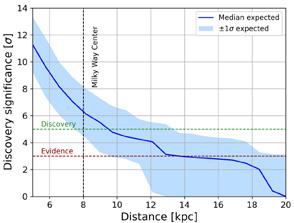
Expected discovery significance for galactic supernova neutrino detection with the SABRE South liquid scintillator detector. We assume a typical core-collapse supernova of 27 solar masses at different distances throughout the galaxy, and we take a 3-fold coincidence threshold for the veto system.
Nal(Tl) Detector
Seven Nal (Tl) crystals will be grown using Nal astrograde powder obtained from Merck, known for its minimal potassium content. These crystals will be housed in oxygen-free copper enclosures measuring 670mm in length. With dimensions of approximately 150-200 mm in length and 110 mm in diameter, each crystal will weigh about 7 kg, resulting in a total crystal mass of approximately 50 kg. To detect dark matter, each crystal will be equipped with two highly sensitive 76mm Hamamatsu R11065 photomultiplier tubes (PMTs) designed for ultra-low noise detection.
Crystal production and Characterisation
Crystal production is the most critical item for the success of SABRE South. The crystals are the dark matter target and the leading source of background is from crystal impurities. Two producers have been engaged to use crystal growth procedures developed by SABRE: RMD and SICCAS. Several prototype crystals have been produced with RMD using astrograde powder and a BridgmanStockbarger growth procedure, with world-best radioactive contamination levels. Several high purity crystals from RMD have been analysed at LNGS for characterisation and development of the crystal detector assembly process. SABRE South members were directly involved in the setup of these tests at LNGS. The data acquisition and analysis used the SABRE South developed DAQ and software frameworks. The light yield, resolution, and 210Pb levels were measured.

125mm x 220 mm (~10 kg) NaI crystal grown by SICCAS for SABRE South. This demonstrated the capacity of SICCAS to grow large NaI(Tl) crystals for SABRE South. After trimming the ends and polishing the crystal will reach the ideal size of 7kg for the SABRE South experiment.

An ultrapure NaI(Tl) crystal grown by SICCAS for SABRE South. This qualification testing crystal is made from approximately 1 kg of ultrapure astrograde powder. It is being studied for any contaminants that may have entered the crystal during the growth phase. Once purity is measured and confirmed SICCAS will be ready to produce large ultrapure crystals for SABRE South.
Despite the good results, it was identified by SABRE North colleagues that further improvements to the contamination levels can be achieved from the use of zone refining in the production process. R&D on this is ongoing.
The second production line involves Centre Als from SICCAS who have used a modified Bridgman method with a double-walled platinum crucible technique. An MoU between UoM and SICCAS was put in place, which has supported the work on achieving the growth of 7 kg high-purity crystals a major milestone for SABRE South. SICCAS grew a large NaI crystal for SABRE South using the seedless Bridgman method. The crystal, with an initial size of approximately ø125 × 220 mm (~10 kg), was cut into a ø110 × 200 mm (6.9 kg) crystal to enable assembly tests at SUPL and in Melbourne. Additionally, two smaller Astrograde NaI crystals, each 38–40 mm in diameter and 100 mm in length (after cutting), will be shipped once suitable underground storage is available.
For the qualification of SICCAS crystals, the 40K content will be measured using ICP-MS at Boulby Laboratory (UK) as part of the full production process. In addition, in-situ alpha measurements at SUPL will be used to assess 210Pb levels, informing the choice of surface treatment for the crystals (i.e., whether chemical etching or mechanical polishing is required).
Enclosure, glove box and insertion system engineering
Within the copper enclosure, the crystals are mounted directly to the PMTs using high purity copper and PTFE (teflon) parts. The design of the enclosure is complete, and prototypes of the copper end-cap plates have been tested to ensure good seals for handling high-purity nitrogen and to ensure no leakage from the liquid scintillator.
The nitrogen-flushed glovebox for assembly of these detectors has been purchased and it is being commissioned at UoM. It was chosen to have good capability in maintaining minimal humidity, radon, and dust ingress. The crystal insertion system is ready for integration with the fluid/gas handling system.
PMT Characterisation
The isolation of dark matter signatures is challenging due to the low-energy signatures involved. At room temperature this can be swamped by PMT induced background. An excellent understanding of low energy background, and single photon performance is therefore crucial. The tests for the crystal PMTs have focused on the single photo-electron response, quantum efficiencies, gain and stability over time, as well as dark rate and its temperature dependence. Machine learners have been developed to mitigate PMT noise with promising outcomes, and a publication on the topic is being prepared for submission.
The leading background contributions to SABRE are twofold: (i) PMT and electronics induced noise, and (ii) radioactive decay and neutrons from spallation. In both cases, machine learning algorithms were developed and trained on data from the PMT test bench, and in the future, it will utilise new algorithms developed to simulate detector and electronics effects. The latter is key to reach the low thresholds needed to understand the DAMA/LIBRA signature.
Veto detectors, calibration systems and shielding
Liquid scintillator veto
The liquid scintillator vessel is made of stainless steel and lined with Lumirror reflector film. It is approximately 3.3 m tall with a 2.6 m diameter and designed to hold 12 kl of liquid scintillator. The main top-flange has seven smaller flanges for the insertion of the crystal enclosures. The upper torispherical section has 12 flanges for cabling, gas flow, and calibration systems. The liquid scintillator is a mixture of linear alkyl benzene (LAB) and fluorophores PPO and Bis-MSB. The vessel is instrumented nominally with 18 204mm Hamamatsu R5912 PMTs with oil-proof electronics bases to detect veto signals with very low energy thresholds. In late 2023, early 2024 a further 16 PMTs were donated by IHEP from the decommissioned Daya Bay experiment. Work was undertaken to characterise these PMTs to select the ones to be used in the SABRE South vessel. The full characterisation tests of all donated PMTs have been performed in the Melbourne test bench. This work studied efficiencies, single photo-electron responses, noise as a function of temperature and gain, and afterpulse background.
With the vessel already built, the current effort is focused on LAB transport, PMT and Lumirror mounting, cleaning, and fluid handling. In 2021, 17 kl of LAB was procured from Nanjing via the IHEP JUNO group. It was developed to meet the tighter purity requirements of JUNO, with excellent photon attenuation and radioactive contamination properties. The storage tank has been hosted at a facility in Ballarat. The LAB is expected to be transported to SUPL in a smaller transport vessel in 2025. The fluorophores have also been procured ready for mixing. Significant efforts continued in 2024 to develop Lumirror templates and PMT assembly procedures, which present a challenge due to the confined spaces.
Fluid handling systems
Another major effort was the fabrication of the systems that manage the flow and monitoring of the high purity nitrogen used in the veto and crystal detectors, and the handling of the liquid scintillator. The ANU group lead the assembly of this system which was completed in 2024.
Calibration systems
SABRE South has three calibration systems: (i) a radioactive sourcebased system to be deployed via tubes inserted into the LS for the crystal and veto systems designed in 2022, (ii) a pulsed optical system to test the LS system being finalized, and (iii) a radioactive source based system for the muon detectors built in 2022/2023 and deployed to SUPL in early 2024. The calibration systems are designed to correct for performance changes over time, which is crucial for a well-understood annual modulation measurement.
Muon detector
On top of the vessel is the EJ200 plastic scintillator muon detector, made up of eight 3.0 m x 0.4 m x 5 cm assemblies. The muon detector is designed to stably measure muon rates over long periods and to provide an additional veto in tandem with the LAB detector.
This is the first major system installed in SUPL since its opening. The system and the data acquisition system (DAQ) actively collected data at SUPL since February 2024, as part of the commissioning of the experiment. The transport of this equipment to SUPL provided us with invaluable experience in the logistics of transporting large, heavy and delicate equipment through SGM. The system is taking data to perform angle-dependent flux and flux modulation measurements until its integration with the full SABRE South detector in 2025. The muon detector was used to conduct independent measurements of cosmic muons at SUPL. The current collected data enable an imminent publication documenting the time-averaged muon flux measured at SUPL. Due to the expected modulating nature of this type of background, this measurement constitutes one of the fundamental milestones in the experiment’s commissioning, determining the level of a background possibly mimicking the dark matter signal. With an additional year of data taking, the accumulated statistical power will allow us to measure the muon-flux time-dependence and serve as a first reference to compare in the following signal modulation analyses.

Large muon detectors and DAQ installed in SUPL
Shielding
The vessel is surrounded by a shielding system made of a 100 mm layer of polyethylene sandwiched between two 80 mm layers of steel. The steel is sourced from manufacturing processes that use minimal amounts of recycled steel content. The sandwich system is designed to shield gamma rays with steel and neutrons with polyethylene. The efficiency of the shielding has been fully simulated, to ensure background in the crystal detectors is less than 10\% of the total expected. The total mass of steel is around 110 tonnes. The design was constrained by transport weight limits to SUPL, requiring each module to be pre-assembled in segments not exceeding 4 tonnes to accommodate truck cartage restrictions.
Data Acquisition, Monitoring and Control systems
DAQ infrastructure
The data acquisition (DAQ) system is primarily composed of a CAEN VME crate with CAEN 500 MS/sand 3.2 GS/s digitisers with on board firmware for digital pulse processing and zero suppression. A trigger logic unit is used to control data rates by triggering on coincidences within and between subdetector systems. The system is read out via optical links to DAQ server units. The PMT high-voltage (HV) system is a CAEN mainframe controlled by EPICS (Experimental Physics and Industrial Control System) with three 24 channel HV boards. The hardware of the system is complete. An EPICS based system has been stably deployed for the muon run at SUPL, DAQ run control at LNGS, HV control and monitoring, PMT testbench studies, and for detector calibration runs. Versions of the software have been developed for calibration and control of each of the detector subsystems. It has been integrated with slow control and environmental monitoring systems.
Over the past year, we have achieved several important milestones. The muon detector has been operated and calibrated successfully using a 16-channel readout system. In addition, all six compute and storage servers have been installed on-site, along with the VME crate and the HV mainframe, providing the essential infrastructure for the full detector system. On the computing side, we are developing the data-taking workflow, incorporating data compression, and establishing real-time monitoring to support stable and efficient operations. In parallel, we are setting up the V2730 digitiser, which provides 32 channels for the veto system, using SciCompiler.
Through these SUPL activities, we have also gained valuable experience. In particular, we learned important lessons related to DAQ system operation, network configuration, dust management, fuse failures in the HV system, and calibration processes. Based on this experience, we have identified the need to purchase a spare HV unit to ensure continued operations while the existing unit is sent for repair.
Online computing infrastructure
The local SUPL computing infrastructure for SABRE South was procured using UoM funding and partially deployed in early 2024. This comprises three 24 core DELL Xeon Gold server units for direct data acquisition, a high-capacity storage and processing server with 56 Xeon Gold cores and 66 TB of storage. Two 16 core Xeon Gold server units were procured and are used for run control and monitoring data processing. The entire system is backed up by a smart UPS which also acts to smooth the power input to the HV systems.
Software and offline computing
There are three main projects in development for SABRE South. The GEANT4 based full simulation of the experiment was developed and published in 2023. Detector digitisation and resolution effects were introduced to fully mimic waveform data acquired by the readout system. This is being used to develop more advanced analysis algorithms in all subsystems.
The python-based data processing and analysis framework (Pyrate) that processes data from either the DAQ system or from the GEANT4 simulation went through further development. It supports a wide range of ongoing calibration and machine learning based pulse shape analysis studies. Recent developments include new event builders that use sophisticated algorithms to combine data from all the detector channels in SABRE South.
The final main project is on offline computing. The offline storage for SABRE South is provided by UoM. It is currently 30 TB of fast disk and 150 TB of long-term storage and will ramp up as required in the future. All collaborators have access to the SABRE South data and can process it on the UoM Spartan HPC system. The data link from SUPL to UoM was set up for continuous data transfer and remote control of detector systems and has been successful in supporting large data transfers of muon detector data.
r&d CYGNUS
Nodes involved: ANU, UoA, UoM, UoS
Chief Investigators: N. Bell, C. Boehm, G. Hill, P. Jackson, G. Lane, A. Stuchbery, A. Thomas, M. White, A. Williams
Postdocs: L. Bignell, I. Bolognino, P. McNamara, J. Newstead, Z. Slavkovska
Students: V. Bashu, F. Dastgiri, K. Leaver, C. Lisotti, L. McKie, I. Shaukat Ali
Associate Investigators: C. O’Hare, L. Manenti
Searching for Dark Matter in the Neutrino
Background Era
The advancement of directional detection technologies for dark matter searches is driven by an emerging challenge in the field: the so-called “neutrino fog.” As detectors become increasingly sensitive, they will begin to observe interactions from solar neutrinos—background events that cannot be shielded against and that mimic the signals expected from dark matter. Evidence of solar neutrino interactions have already been reported by the Xenon-nT and PandaX experiments, and they will become an increasingly important background in next-generation detectors. This presents a fundamental limitation to the effectiveness of conventional dark matter detection methods.
To address this, researchers are focusing on the development of detectors capable of measuring the direction of nuclear recoils. This directional information provides a critical discriminant: solar neutrino events align with the position of the Sun, whereas potential dark matter particles are expected to arrive predominantly from the direction of the constellation Cygnus, aligned with the solar system’s motion through the Milky Way. Directional detection is therefore essential not only to mitigate the neutrino background but also to confidently identify a true galactic dark matter signal. Furthermore, any dark matter discovery claimed by a non-directional experiment will ultimately require confirmation via a directional measurement.
The CYGNUS Consortium, an international collaboration, is leading efforts to build the next generation of directional detectors based on gas Time Projection Chamber (TPC) technology—the only approach currently capable of achieving the required angular sensitivity. Over the next decade, CYGNUS aims to construct a network of large-scale directional detectors at underground laboratories in member countries, including Australia, Italy, Japan, the United Kingdom, and the United States. The combined exposure of these facilities will provide the sensitivity needed to explore dark matter signatures beyond the neutrino background and address a range of other fundamental physics questions.
The Australian component of this international consortium is known as the CYGNUS-Oz collaboration, and features experimental and theory researchers from the Australian National University, University of Adelaide, University of Melbourne, and University of Sydney.
2024 Highlights and Progress
The year was marked by key scientific contributions, new funding successes, and the growth of a skilled research workforce, which continue to enhance Australia’s role within the international CYGNUS Consortium.
A major milestone this year was the successful awarding of a $447,000 LIEF grant from the Australian Research Council, secured to fund the construction of a prototype detector module for future large experiments called CYNET. This represents a crucial step toward realising a future large-scale directional dark matter experiment at the Stawell Underground Physics Laboratory. Its development will resolve key technical questions and serve as a proving ground for the technology that will underpin future steps on our roadmap. Beyond fundamental physics, CYGNET also offers potential translational benefits in defence and environmental measurement, through its neutron detection capabilities. The ANUled grant includes CIs from Adelaide, Melbourne, and Sydney, as well as PIs from CYGNUS collaborators in Japan, the UK, and US, as well as the Stawell Underground Physics Laboratory.
Funding support from the Defence Science and Technology Group (DSTG, with funding administered through the Centre) also continued into a second year, reflecting their strong interest in the development of directional neutron detection for defence applications. The funding included the visit of a CYGNUS PhD student to collaborate directly with DSTG researchers, focusing on improved modelling of Time Projection Chamber (TPC) capabilities in applied contexts. These efforts continue to translate our particle detection research to support areas of national priority.
Further, a CDM Special Initiatives grant was awarded to develop a radon emanation measurement and suppression system. The resulting instrument is currently under development and testing and features low-radioactivity filtration material co-developed with CYGNUS’s international partners. This capability will be critical for controlling background levels in future underground experiments, and is a beneficial capability for Australia’s rare-event physics program.
Experimental progress over the past year has led to a number of outcomes. PhD candidate Lachlan McKie (who successfully submitted his thesis in 2024) has reported a novel method for achieving negative ion drift in a TPC without relying on electronegative gas additives. This technique, based on Dissociative Electron Attachment (DEA), allows for the suppression of diffusion while preserving high detector gain—an important step for scaling up TPC-based directional detectors. The group has developed improved measurement protocols for operating with the intensified camera readout. This includes the development of corrections for optical distortions to enhance the accuracy of track reconstruction, including spherical aberration corrections which had not yet been accounted for in other optical TPCs. In a complementary line of work, PhD graduate Ferdos Dastgiri (who successfully submitted her thesis in 2024) developed a technique to study the effects of gas impurities on TPC performance using a residual gas analyser, providing a new tool for this important area.
A paper led by theory PhD student Chiara Lisotti at the University of Sydney examined the broader applications of directional detection beyond dark matter to include solar neutrinos. Published in the European Physical Journal C, the paper outlines solar neutrino physics where directional detection is competitive with existing approaches and demonstrates that appreciable solar neutrino event rates can be achieved in detectors as small as 10 cubic metres.
PhD student Iman Shaukat Ali (UoM) has led a study on DM that is boosted by energetic cosmic rays and/or produced in supernovae explosions, as a possible means to improve detection prospects for low-mass dark matter. A directional detector can provide a strong advantages for such dark matter, which inherits the directionality of its astrophysical sources.
2024 saw a number of excellent student outcomes. The program also supported an honours-equivalent thesis, Master’s and undergraduate research projects, and several paid internships.

Tony Williams visiting ANU and being shown a Time Projection Chamber by Lindsey Bignell that is coupled to a high precision camera as part of the R&D effort for CYGNUS-Oz.
Current and next generation liquid xenon TPCs
Nodes involved: UoM, UoS
Chief Investigators: E. Barberio, N. Bell, C. Boehm, P. Urquijo
Academic staff: T. Früth
Postdocs: R. James, J. Newstead, Y. Xing
Students: M. Bazyk, O. Stanley, L. Principe, A. Ravindran
Associate Investigators: L. Baudis, C. O’Hare, L. Manenti, M. Schumann
Partner Investigators: S. Diglio, L. Scotto Lavina
In 2024 the Centre continued working with the international effort to build a next-generation liquid xenon detector. The XLZD collaboration combines the leading experiments (LZ and XENONnT experiments) with the large-scale DARWIN R&D effort. The consortium is planning a 60-80 tonne detector. The detector will also serve as an observatory for other rare event physics, including solar, atmospheric and supernova neutrinos, alternative low- and high-mass dark matter models, and rare decays.
2024 saw the Centre’s XLZD efforts expand. Regular meetings were held between researchers at UoM, UoS and collaborators at Subatech and LPNHE Paris, coordinating work across the institutes and sharing online software tutorials. Theresa Fruth (UoS) coordinated work on the XLZD design book, submitted for publication to EPJC. UoM and Subatech continued development of simulation and statistical inference tools, now in use across the collaboration for high-level design requirements studies, in addition to student-led projects exploring sensitivity prospects for low-mass WIMPs via the Migdal effect. PhD student Owen Stanley in collaboration with Luca Scotto-Lavina set up a small scale test platform for electrode design at LPNHE Paris, including the construction and the start of commissioning of the system. Finally, the first XLZD-Oz workshop was held in Sydney, organised by ECRs from UoM and UoS and funded by a CDM Special Initiatives grant. This workshop included in-person and remote participation from both Australian and international collaborators, with talks and hands-on sessions covering a number of topics of relevance to current efforts.
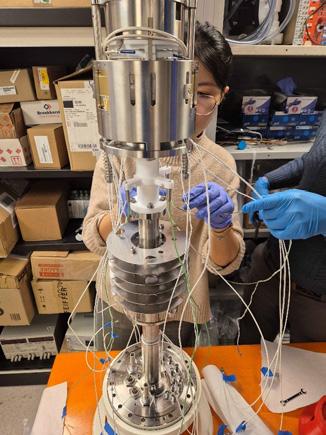

Yajing Xing with the time projection chamber of XeLab at LPNHE (Laboratory for nuclear and high energy physics), in Paris.
Projected 90% C.L. upper limits on the spin-independent WIMP-nucleon cross section for 200 and 1000tonne- year (t·y) exposures of the XLZD detector, along with current upper limits. The blue shaded regions illustrate the neutrino fog.
AXION and WISP Direct Detection
Nodes involved: UWA, SUT, ANU, UoS
Chief Investigators: M Tobar, M. Goryachev
Postdocs: B McAllister, J. Bourhill, G. Flower, A. Quiskamp
Students: A. Quiskamp, C. Thomson, W. Campbell, E. Hartman, S. Samuels, E. Paterson, R. Crew, R. Singh, M. Hatzon
Associate Investigators: E. Ivanov, P. Altin, C. O’Hare, W. Campbell, Z. C. Zhao, G. Brooks
Partner Investigators: G. Rybka
Research program overview
2024 has been a productive year within the centre for searching for axion and WISP dark matter. The Centre teams continued to progress on many fronts, with many highlights for 2024. This included the following:
• The publication of the ORGAN phase 1b results in, Phys. Rev. Lett. vol. 132, 03160, 2024 based on a novel haloscope cavity design, with details published in, Phys. Rev. D 109, 015013, 2024 This marks the completion of ORGAN Phase 1.
• The first experimental run of ORGAN-Q, a 6 GHz haloscope, which implemented quantum technologies as part of the measurement process, which is accepted for publication in 2025. All these new results with ORGAN formed the basis of Aaron Quiskamp’s PhD thesis, graduated in 2024.
• Development of first prototype detectors for ORGAN Low Frequency, the spin off experiment at Swinburne, and the expansion of the Swinburne Axion Group with new students, expanding the Centre nodes involved in the program
• Progress with the UPLOAD: ANYON experiment to search for ultralight axions using twisted superconducting resonators through the PhD project of Emma Patterson, making progress on building and understanding twisted resonators and the PhD project of Robert Crew for investigating making low-noise oscillators with high-Q superconducting cavities.
• Progress on the Axion-MonoPole-Detection (AMPD) experiment to search for axions and monopoles with Emily Waterman completing her honours thesis by building the first prototype in 2024.
• The continued successful development of the MAGE high frequency gravitational wave detector, which is also sensitive the scalar dark matter. William Campbell graduated with his PhD on this topic in 2024.
• Expanded interaction with ADMX – more Centre researchers began work with the collaboration.
ORGAN
ORGAN as a leading international effort in the search for axion dark matter, in 2024, our research group significantly advanced the detection capabilities of the Oscillating Resonant Group AxioN (ORGAN) experiment, as highlighted by three key publications.
In Phys. Rev. Lett. (vol. 132, 031601, 2024), we reported the results of Phase 1b of the ORGAN experiment, a microwave cavity haloscope searching for dark matter axions in the 107.42–111.93 μeV mass range. Our search excludes axions with two-photon coupling g aγγ ≥ 4×10⁻¹² GeV⁻¹ at a 95% confidence interval, setting the best upper bound to date and providing the sensitivity required to exclude the axionlike particle cogenesis model for dark matter within this range. This milestone was achieved using a novel tunable rectangular cavity design, addressing several practical challenges associated with high-mass axion searches. This was also the first axion search conducted with such a cavity type and currently represents the most sensitive axion haloscope experiment in the ~100 μeV mass region.
Our comprehensive theoretical analysis published in Phys. Rev. D (vol. 109, 015013, 2024) examined resonant cavity design, a critical factor influencing haloscope sensitivity. We compared a simple yet effective rectangular resonant cavity with a tunable wall to the conventional cylindrical tuning rod cavities typically employed. Our findings indicated that rectangular cavities support modes comparable to those of cylindrical tuning rod cavities and offer significant advantages in terms of axion sensitivity and practical implementation, particularly at higher frequencies increasingly relevant to the global axion dark matter community.

ORGAN Phase 1b results published in Phys. Rev. Lett.
Additionally, the latest result from the ORGAN Experiment (arXiv:2407.18586) was presented, marking a major technological advancement. Operating at millikelvin temperatures and utilizing a flux-driven Josephson parametric amplifier (JPA) to significantly reduce noise, this iteration also incorporated various other enhancements. Covering the GHz mass (frequency) range, this near-quantum limited phase employed a conducting rod resonator within a 7-T solenoidal magnet, placing the most sensitive exclusion limits on axion-photon coupling to date in this frequency range at a 95% confidence level.
The AC Haloscope, UPconversion Loop Oscillator
Axion Detector (UPLOAD)
During 2024 the UWA group continued to develop low noise oscillators based on high-Q resonators, with the goal of using them to upconvert dark matter signals close to the frequency of a low noise oscillator. This includes: 1) Further understanding of twisted ANYON-resonators necessary to search for axions, arXiv:2504.03795
2) The investigation of 3D printed superconducting resonators IEEE Trans. on Comp., Pack. and Manufact. Tech., 14(11) pp. 21402143, 2024. 3) A collaboration with Jefferson Labs to research the use of high-quality superconductors. 4) The continued research of generating low noise microwave signals.
Axion Dark Matter eXperiment (ADMX)
Generation 1 and 2
Backed by substantial and sustained funding, the ADMX collaboration continues to lead the global search for the QCD dark matter axion and has already scanned from 2.10-6-5.10-6 eV, and is currently continuing to scan up to 8.3.10-6 eV. The ADMX experiment continues to run with high duty cycle, and the collaboration continues to expand.
The ADMX collaboration now includes four US Department of Energy (DOE) national labs and ten universities, including UWA (since 2019). Swinburne was invited to join the Axion Dark Matter eXperiment (ADMX) in 2024, which marks a significant milestone for the Centre.
The University of Sheffield (UK) is the only other non-US partner. In addition to simulation and design, Swinburne researchers may play a role in data analysis, machine learning applications, hardware testing, and possibly even hosting sidecar experiments in the future. The partnership promises to forge stronger ties between ORGAN and ADMX, facilitating collaboration, knowledge sharing, and enhanced opportunities for CDM students and ECRs. Ultimately, with both Swinburne and UWA now nodes of ADMX, the Centre cements its position within the global network of axion dark matter researchers, benefiting from direct engagement with cutting-edge science while also contributing fresh perspectives and capabilities.
In 2024, the collaboration published a highly sensitive search for nonvirialized axions sensitive to Doppler effects in the Milky Way Halo (arXiv reference forthcoming). Covering the mass range of 2.81–3.31 μeV (680–800 MHz), we set stringent exclusion limits on cold flow relic axions with a velocity dispersion on the order of 10-7c, at a 95% confidence level. This marked the most sensitive exploration of nonvirialized axion dark matter to date, addressing uncertainties in dark matter velocity distribution models.
ORGAN Low-Frequency (and ties to ADMX)
A key goal for the Swinburne node is the development of ORGANLow, specifically aimed at probing the low-mass axion regime in the 100-500 MHz range. The project is moving forward, thanks in part to the successful DECRA funding awarded to Dr Ben McAllister. This support provides both the resources and momentum to proceed with the design and initial implementation of the experiment, ensuring that the Centre’s axion research continues to grow and diversify, and contribute to the Centre’s broader goals. The Swinburne axion group welcomed two new PhD students, Raj Aryan Singh and Dylan Dance, both of whom are focused on research directly related to ORGAN. 2024 also saw two Engineering Honours students working on ORGAN Low – Paige Taylor and Ned Sullivan. Their involvement has helped to broaden our team’s expertise and expand our technical capabilities. Meanwhile, the detector is currently in the research and development phase: a prototype was constructed and tested in 2024, and subsequent insights from that testing are now guiding a re-design process. We anticipate having a full-size cavity completed by the end of 2025, with the goal of initiating data collection in late 2025 or early 2026.
A related experiment is also proposed by the ADMX collaboration (Phys. Rev. D, vol. 109, 042004, 2024) to either run in the new Darkwave lab at Fermilab, or in the current dilution fridge and magnet at the University of Washington. Centre researchers, Hartman and McAllister played a leading role in this proposal.
Acoustic Detectors: Search for Scalar Dark Matter
The UWA group has been developing acoustic technology, which is sensitive to a variety tests of fundamental physics, including scalar dark matter and high frequency gravitational waves (HFGWs). This includes Bulk Acoustic Wave (BAW) resonators predominately manufactured from quartz. Recent work includes studying the implementation of other promising materials such a lithium niobate BAW APL Photonics, vol. 9, 111304, 2024. The goal is to integrate multiple (BAW) detectors into a coordinated network operating from 100 kHz to 100 MHz. This proposed network will include the Multi-mode Acoustic Gravitational wave Experiment (MAGE) at UWA, Detectors are also proposed at the Università degli Studi di Milano-Bicocca in Milan, led by Prof. Tommaso Tabarelli de Fatis, and at Swinburne in Melbourne, and the Stawell Underground Physics Laboratory (SUPL) in Victoria led by postdoctoral researcher Ben McAllister. By establishing a geographically distributed detector array, the network will significantly enhance sensitivity to HFGWs and oscillations in fundamental constants potentially induced by ultralight scalar dark matter, thereby providing new insights into the fundamental nature of gravitational waves and dark matter physics. The UWA labs hosted, Leonardo Mariani, a Masters student from Milan during 2024, who successfully completed in April 2025, facilitating the Milan group to develop their detector.
The BAW technology is at the heart of all low-noise quartz oscillator technology. Postdoctoral researchers William Campbell (UWA) and McAllister (SUT) undertook the first experiment in SUPL using Quartz Oscillators (provided by Quantic Wenzel), to measure the oscillator frequency stability and determine the impact of cosmic rays. Extending this research into a cryogenic environment once the underground fridge is operational, will potentially reveal new insights into oscillator stability in cosmic ray shielded conditions, and would be an important inclusion for a future network of BAW detectors.
Quantum Technologies and Metrology
Quantum techniques provided exceptional sensitivity and precision beyond classical capabilities, making them indispensable for axion and WISP dark matter detection and fundamental physics research. Key milestones in this area include the measurement of the gravitational Aharonov-Bohm effect (Phys. Rev. D, vol. 109, 064073, 2024), which we demonstrated as a scalar potential effect and extended the concept of gravitational redshift into a gravitational Aharonov–Bohm effect (Appl. Phys. Lett. 125, 094002, 2024). Furthermore, we demonstrated conductivity freeze-out in isotopically pure Si-28 at milli-Kelvin temperatures (Phys. Rev. Applied, vol. 21, 064002, 2024), optimized microwave-cavity modes via background antiresonance tuning (Phys. Rev. Applied, vol. 22, 014081, 2024), and performed precision multi-mode microwave spectroscopy on paramagnetic and rare-earth ion spin defects in single-crystal calcium tungstate, an important crystal for dark matter detection (Appl. Phys. Lett., vol. 125, no. 16, 164001, 2024). Additionally, we demonstrated phonon-tomicrowave photon upconversion in lithium niobate bulk acoustic wave resonators coupled to microwave cavities, which is potentially sensitive to variations in fundamental constants and hence scalar dark matter.
precision metrology research program
Nodes involved: ANU, UWA
Chief Investigators: M. Goryachev, S. Tims, M. Tobar
Postdocs: M. Froehlich, Z. Slavkovska
Students: F. Dastgiri, A. Quiskamp
Associate Investigators: E. Ivanov, D. Koll
Partner Investigators: A. Wallner, M. Hotchkis
Improving the detection sensitivity for those radionuclides identified from the intrinsic background as most likely to impact dark matter detection capability remains the focus of the precision metrology program at the ANU node.
Development of low phase noise oscillators for use as detectors continues at the UWA node. Details are provided in the AXION direct detection section above.
Nuclear metrology
Characterisation of dark mater detector materials
Repair of the gas stripper used to remove molecular interference, crucial for AMS measurements of high mass isotopes, was unable to be completed until mid-April. The installation of the electrostatic analyser has also been delayed until mid-2026 as a result of other operational issues with the 14UD accelerator. Notwithstanding this, AMS activities during the year have seen important milestones achieved in the optimization of suitable procedures for the chemical separation and purification of 210Pb from NaI detector material, and of AMS ion source parameters that will allow 210Pb/ (total Pb) determination at the requisite levels in the detector crystals and laboratory materials. A chemical extraction and purification method that optimizes 210Pb detection efficiency, and that does not introduce significant interference during the AMS measurement, has now been finalized and measurements of the raw materials, from which detector crystals will be made, are in preparation.
Efforts to improve the sensitivity of the AMS time-of-flight system at ANU have remained largely on hold owing to stability issues with the accelerator and limits on beam time access. However, the ongoing assessment of the new automated system for measuring plutonium and uranium isotopes with the fast isotope switching system continues to show reliable and improved sensitivity for these isotopes.
ICP-MS development
During 2024 we developed a procedure that allows ICP-MS measurements of thallium dopant levels in NaI detector crystal material. This will allow assessment of the uniformity of the thallium concentration in the detector crystals. In addition, we have initiated an ICP-MS program to characterise the dust that covers the walls in SUPL to understand the possible contamination of dust that may enter SUPL from the tunnels outside the laboratory. Initial measurements of potassium, rubidium, thorium, and uranium concentrations have been completed, with further analyses planned.
AMS capability improvements
The challenge of developing a capability to measure 40K with the required sensitivity has led to a new initiative with our HZDR collaborators. This involves the use of a Secondary Ion Mass Spectrometer (SIMS) to provide the input beam into an AMS system. A combined SIMS/AMS system would remove some of the major limitations associated with ICP-MS 40K measurements. Initial tests to extract potassium ions from solid NaI crystal material, and from NaI solutions, with the HZDR SIMS facility show promise. The SIMS facility at HZDR already has the capacity to inject directly into an AMS system.
Development of techniques for measuring the fission product isotopes 90Sr and 99Tc has commenced in parallel with other activities. Trials of various beam injection species, new detection methods, chemical extraction and purification processes and some assessments of potential interference that could appear in the detector now underway. These isotopes have been selected as a low-level detection will have spin-off applications in radioactive waste management, reactor technologies and for medical isotope releases to the environment. We have already identified optimal species for injection for both isotopes and made progress in the chemical extraction and purification steps.

Centre members Stephen Tims, Michaela Froehlich and Zuzana Slavkovská with the ANU AMS time-of flight end station used for the measurements of actinide species that could compromise the performance of the SABRE South detector.
LHC research program
Nodes involved: UoA, UoM
Chief Investigators: E. Barberio, P. Jackson, G. Taylor, M. White
Postdocs: H. Potti
Students: C. Alley, I. Carr, A. Desai, M. Fewell, E. Filmer, J. Gallagher, C. Grant, M. Green, A. Kong, J. Kull, H. Pandya, H. Purnell, A. Reardon, T. Ruggeri, E. Ting
Partner Investigator: K. Jakobs
Associate Investigators: C. Doglioni, J. Gonski
Technical Staff: A. Subramaniam
Collider Searches for Dark Matter: Large Hadron Collider - ATLAS experiment
The Centre provides an opportunity to search for Dark Matter direct production at one of the most notable and unique facilities in the world, namely the experimental environment provided by the world’s highest energy particle collider – the Large Hadron Collider (LHC) at CERN in Geneva, Switzerland. At this laboratory, members of the Centre work on the ATLAS experiment, one of two multipurpose detectors well equipped to search for evidence of dark matter production in proton-proton collisions across a wide range of potential masses and interactions.
During 2024, the ATLAS experiment was recording data at a world-leading collision energy of 13.6 Tera Electron Volts (TeV) and collected the largest dataset to date in a calendar year. Centre researchers were present at CERN performing shifts in the control room and data quality and software monitoring shifts to ensure the integrity of the data collected. The overall aim of the LHC dark matter program is to find direct evidence of Standard Model particles produced in conjunction with a signature of MET, which it is postulated would be carried away by the dark matter candidates.
Dark matter searches with ATLAS data are underpinned by performance work and require a thorough understanding of the objects particles that leave signals in our detectors. Centre researchers are working to strengthen our understanding of hadronic jets by deploying advanced machine learning techniques and algorithms based on particle flow to extract greater precision. Efforts on calibration and tagging of hadronic jets is also a prominent activity within the Centre. Work on flavour tagging and new techniques in jet calibration has led to publications in 2024. Centre researchers (Green and Gallagher) were session leaders at the annual Hadronic Calibration Workshop held in Ottawa, Canada in August-September 2024.
Centre researchers have led analyses searching for evidence of hadronic jets that have been tagged as originating from charm quarks. This signature has resulted in increased sensitivity to models of Supersymmetry or other beyond Standard Model theories that propose pair production of new particles that subsequently decay to massive particles that interact weakly with our detectors and leave a significant signal by their absence. This analysis work is completed, and the results are now published. In models where the Higgs boson decays to Dark Matter, we infer its presence by studying signals of invisible decays of the Higgs boson. Centre researchers have combined various production and decay mechanisms to increase the sensitivity to invisible decays of the Higgs boson and published these results.
Beyond performance and physics analysis, Centre researchers contribute to the long-term health, success and productivity of the detector by upgrading it. The next big transition in fundamental physics will come with the upgrade to the High-Luminosity LHC era, with a shutdown lasting from mid-2026 to 2030. The shutdown will provide the opportunity for a near complete refurbishment of the ATLAS detector. Centre researchers are focused on the construction, testing and deployment of modules for the inner tracker upgrade (ITk), with specific focus on module production testing and characterisation for the end-caps of the silicon strip tracker. Having passed review milestones at each of the sites, module production will occur in Melbourne with modules then sent to Adelaide to perform a thermal cycling and rigorous testing procedure prior to them being shipped to CERN for final assembly, integration and ultimately deployment into the experiment throughout the long shutdown period. This effort is providing exceptional training to early-career researchers in the Centre.
The choice of research theme activities, particularly the deep connection to furthering uses of hadronic signatures, enable Centre researchers to have the greatest collective impact on the publications that we produce from ATLAS (listed in the publications section of this report).
theory research program
Nodes involved: ANU, SUT, UoA, UoM, UoS
Chief Investigators: N. Bell, C. Boehm, D. Croton, M. Dolan, A. Duffy, C. Simenel, A. Thomas, R. Volkas, M. White, A. Williams
Postdocs: G. Busoni, T. Maity, R. Mostoghiu Paun, J. Newstead, E. Sirks, X-G. Wang
Students: R. Abdel Khaleq, J. Gill, K. Goh, F. Hiskens, N. Hunt-Smith, M. Hayat, N. Krishnan, C. Lisotti, B. Loizos, D. McClay, A. Ritter, G. Sanamyan, I. Shaukat Ali, A. Ussing M. Virgato, E. Wallace, J. Wood
Associate Investigators: P. Cox, C. O’Hare, D. Sengupta
The aim of the theory program is to understand the nature of dark matter. This is accomplished by exploring ideas for what the dark matter can be and developing new or better ways to test those ideas. This is a multidisciplinary activity that utilizes the complementary skill set in the theory team, which spans particle, nuclear and astrophysics expertise. Ideas-generation is a key element of our research. This is true both of our work at the pure theory end of the spectrum and our work at the theory-experiment boundary. The former includes the development of theoretical models which incorporate dark matter and its interactions, while the latter includes the proposal of novel experimental approaches to detect dark matter, detailed simulations to compare the sensitivity of different approaches, and the development or refinement of the science case for major experimental programs.
In 2024, Centre theorists continued to pursue a diverse range of research projects, expanding collaborations across the Centre and strengthening theory-experiment links through involvement in the DARWIN, CYGNUS and LHC programs. In the year ahead, we look forward to an in-person Theory Program workshop, to be held in Adelaide in February 2025, followed by further in-person activities throughout the year, together with regular cross-node theory seminars and journal clubs. Some highlights of theory research published in 2024 are described below; further projects are ongoing.
Impact of nuclear shell model interactions on nuclear responses to WIMP elastic scattering
The dark matter-nucleon interactions that are probed in dark matter direct detection experiments could be spin and/or orbital angular momentum (in)dependent. Evaluation of nuclear recoil rates through these interactions requires accounting for nuclear structure, e.g., through nuclear shell model calculations. Using nonrelativistic effective field theory, ANU PhD candidate Raghda Abdel Khaleq, together with Giorgio Busoni, Cedric Simenel and Andrew Stuchbery evaluated nuclear response functions induced by these interactions for most atomic nuclei relevant to current direct detection experiments. In particular, the sensitivity to shell model interactions was estimated. Although the standard spin independent response is shown to be barely sensitive to the structure of the nuclei, large variations from the shell model interaction were observed for the other channels. It was concluded that significant uncertainties may arise from the nuclear components of dark matter-nucleus scattering amplitudes due to nuclear structure theory and modelling [Phys. Rev. D 109, 075036 (2024)]. These uncertainties should be accounted for in analyses of direct detection experiments.
Cosmic-ray
boosted dark matter confronted by constraints on new light mediators
Light dark matter particles would be more readily detectable if they could be produced with, or boosted to, higher energies. Nicole Bell, Jayden Newstead and Iman Shaukat Ali have considered scenarios in which galactic dark matter is boosted to relativistic energies by interactions with galactic cosmic rays. This is an appealing paradigm as it does not require any additional assumptions beyond dark matter coupling to nucleons or electrons. Moreover, this energetic dark matter can be seen in large scale neutrino detectors – a significant advantage. However, detectable signals are obtained only with relatively large cross sections which, in turn, can only be realized with large couplings, light mediators or composite dark matter. This work considered a general set of light mediators that couple dark matter to hadrons, and evaluated constraints from the Borexino, XENON1T, LZ and Super-K experiments. The results indicate that cosmic-ray upscattering constraints should always be interpreted in the context of specific models [Phys. Rev. D 109 063034 (2024)].
Searching for dark matter using inelastic scattering in neutrino detectors
Centre postdoc Jayden Newstead and PhD student Iman Shaukat Ali, together with international collaborators, proposed a new approach to search for light dark matter (DM) ( in the keV-GeV mass range), via inelastic nucleus scattering in large-volume neutrino detectors. Examples of such detectors include current/ past experiments like Borexino and Super-K, as well as future experiments Hyper-K, DUNE and JUNO.
The approach uses inelastic nuclear scattering of cosmic-ray boosted DM,enabling a low-background search for DM in these experiments. Large neutrino detectors, with higher thresholds than dark matter detectors, can be used since the nuclear deexcitation lines are O(10) MeV. Using a hadrophilic dark-gauge-boson-portal model as a benchmark, this method can provide world-leading sensitivity over a large region of light DM parameter space [Phys. Rev. Lett. 133, 161801 (2024)].
Neutrino fog for sub-GeV dark matter
The search for sub-GeV dark matter in direct detection experiments has required innovative techniques and has significantly advanced in recent years. For large regions of sub-GeV dark matter masses, searches based on its scattering with electrons or via the Migdal effect provide the best probes. Similar to conventional elastic dark matter-nucleus scattering, these searches also encounter an ultimate background in the form of neutrinos. The so-called neutrino fog refers to the range of dark matter parameter space where neutrino-induced backgrounds could obscure a conclusive discovery of a dark matter signal.
Tarak Nath Maity, Ciaran O’Hare, and collaborators mapped the neutrino fog for a range of electron recoil experiments using silicon, germanium, xenon, and argon targets. They demonstrated that some key theoretical benchmarks motivating these experiments fall within the neutrino fog [Phys. Rev. D 109, 083016 (2024)].

Current and projected constraints on cosmic-ray boosted dark matter coupled to nucleons using elastic (dashed) and inelastic (solid) scattering channels.
Explaining the cosmological dark matter coincidence in asymmetric dark QCD
PhD student Ritter and CI Volkas continue their analysis of the origin of the mass scale needed for asymmetric dark matter. In this paradigm, dark matter and dark antimatter are distinguished, just as ordinary matter is different from ordinary antimatter. By exploiting this similarity, it is hoped to explain why the ordinary and dark matter mass densities today are observed to be quite similar. A complete explanation requires the dark matter mass to be related to the proton mass. Ritter and Volkas proposed new ways that this can be the case when the dark matter is a “dark baryon” formed as a bound state of dark quarks that interact under a dark-sector analogue of ordinary strong interactions. After a general survey of such scenarios, Ritter and Volkas constructed a specific model that forms the basis for a complete theory of this type [Phys. Rev. D 110, 1, 015032 (2024)].
Dark photons vs Z’ bosons: Constraints on the U(1)B-L model from a global QCD analysis
A recent global QCD analysis of electron-nucleon deep inelastic scattering and related high energy data reported a reduction in χ2 with the inclusion of a dark photon, providing the first indirect hint for its existence. It is worthwhile to investigate whether the improvement in χ2 still holds when alternative U(1)' bosons are considered.
In recent work by the JAM global QCD analysis, involving XuanGong Wang, Nicholas Hunt-Smith, Anthony Thomas and colleagues at Jefferson Laboratory, the U(1)B-L boson, Z', was included in the global QCD analysis. No improvement in the χ2 was found relative to that without the Z', implying that the B-L model is not favoured by the data. Exclusion limits on the coupling of the Z', gz, were extracted at 95% CL in the mass range MZ'=2 to 160 GeV, which are stronger than the constraints from LEP, neutrino-quark and neutrino-nucleus scattering [Phys. Rev. D 111, 015019 (2024)]. We emphasise that, unlike direct searches such as LHCb, this approach is not subject to model dependent uncertainties related to potential coupling to the dark sector.
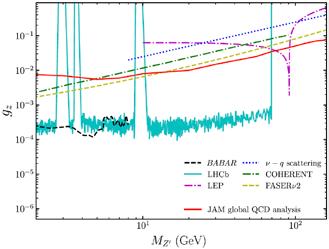
The 95% CL exclusion limits for the coupling of the boson. Is there a new scalar or pseudoscalar particle with a mass of 95 GeV?
Giorgio Busoni, Navneet Krishnan and collaborators investigated the implications of recent experimental hints in Large Hadron Collider data which suggest the presence of a 95 GeV resonance. This was examined in extensions of the Standard Model which feature an additional Higgs doublet and either a scalar (2HDM+s) or pseudoscalar singlet (2HDM+a). By analysing these scenarios in the context of theoretical constraints, collider searches, and flavour physics bounds, they examined the viability of various natural flavour-conserving models, including the well-known Type-I, -II, -X, and -Y configurations of the Yukawa couplings. The study concluded that no single model can fully accommodate all experimental anomalies, and the 2σ confidence level favoured regions of parameter space were identified [Phys. Rev. D 110, 115028 (2024)].
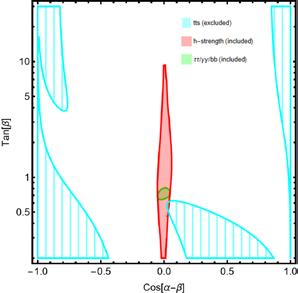
Fit of the Type-II 2HDM+s to the diphoton (LHC), ditau (LHC), and bb (LEP) anomalies, with the scalar singlet as the 95 GeV resonance candidate. The green region fits all three anomalies at 2σ.
Constraints on the dark sector from electroweak precision observables
Electroweak precision observables (EWPO) are expected to provide strong constraints on the properties of the dark photon. It is interesting to investigate how the CDF determination of mW affects the previous EWPO exclusion limits. Also, it is important to constrain the dark photon as a portal connecting to the dark matter sector.
Bill Loizos, Xuan-Gong Wang, Anthony Thomas, Martin White and Anthony Williams revisited the EWPO constraints on the dark photon parameters. Firstly, the impact of the latest CDF mW was examined. The upper bounds of the mixing parameter ε become tightened in the region m��n<mZ and relaxed for m��n>mZ. Secondly, in the case that the dark photon also couples to fermionic dark matter particles χ with coupling gχ, the Z boson will decay invisibly to χχ in addition to the neutrino final states. Exclusion limits directly on gχ were derived, which are rather stringent when the dark photon mass gets close to the Z boson mass [J. Phys. G 51, 075002 (2024)].

Exclusion constraints on dark parameters in the gχ-ε plane at 95% CL for dark photon masses below (left panel) and above (right panel) mZ, using the PDG value of mW
Accelerating Markov Chain Monte Carlo sampling with diffusion models
Nicholas Hunt-Smith, Anthony Thomas and Martin White at the University of Adelaide in collaboration with W. Melnitchouk, F. Ringer and N. Sato at Thomas Jefferson National Accelerator Facility published research on “Accelerating Markov Chain Monte Carlo sampling with diffusion models” [Computer Physics Communications 296 (2024) 109059]. The motivation was that global fits of physics models require efficient methods for exploring high-dimensional and/or multimodal posterior functions. They introduced a novel method for accelerating Markov Chain Monte Carlo (MCMC) sampling by pairing a Metropolis-Hastings algorithm with a diffusion model that can draw global samples with the aim of approximating the posterior. Having briefly reviewed diffusion models in the context of image synthesis, they provided a streamlined diffusion model tailored towards low-dimensional data arrays. They then presented an adapted Metropolis-Hastings algorithm which combines local proposals with global proposals taken from a diffusion model that is regularly trained on the samples produced during the MCMC run. This novel approach leads to a significant reduction in the number of likelihood evaluations required to obtain an accurate representation of the Bayesian posterior across several analytic functions, as well as for a physical example based on a global analysis of parton distribution functions. The method developed in this work can be extended to other MCMC techniques. Finally, the method was compared to similar approaches based on normalizing flows. A code implementation can be found at: github.com/nickhunt-smith/mcmc-diffusion
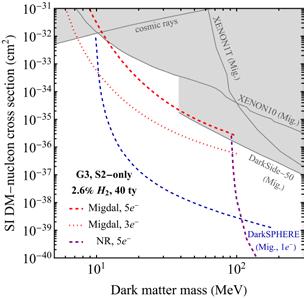
Detecting low-mass dark matter in Hydrogendoped liquid Xenon detectors
The detection of light dark matter is the subject of many ongoing research projects in the Centre. Most direct detection experiments lose sensitivity if the dark matter mass is less than a few GeV, since the nuclear recoil energy deposited by the elastic scattering of dark matter on the target lies below the energy threshold for detection.
Nicole Bell, Peter Cox,
Matthew
Dolan,
Jayden Newstead and Alex Ritter have considered the doping of liquid Xenon detectors with a lighter element such as hydrogen. This provides a target nucleus with better kinematic matching to light dark matter and, consequently, nuclear recoil energies above the detection threshold. Their results indicate that combining Hydrogen-doping with the Midgal effect improves the reach to low dark matter masses, particularly for spin-dependent proton scattering [Phys. Rev. D. 109, L091902 (2024)].
This work was communicated to a lay audience in a Pursuit article entitled: Dark matter might be ‘light’
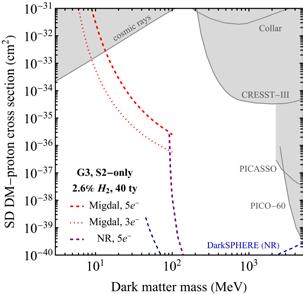
Projected 90% C.L. upper limits on spin-independent nucleon (left) and spin-dependent proton (right) scattering in hydrogen-doped liquid xenon at a future G3 detector (red and purple curves). The grey regions are excluded by previous experiments.
Optomechanical dark matter instrument for direct detection
Peter Cox, Matthew Dolan and Maxim Goryachev, with colleagues from the University of Queensland, proposed a new method for the direct detection of dark matter. It relies on dark matter scattering off quantum excitations called phonons in a target of superfluid helium. The low-energy phonons which are produced can then be transduced into higher-energy optical photons, which can be detected. After a detailed consideration of the technical challenges, the authors proposed an experiment called ODIN: the Optomechanical Dark Matter INstrument. ODIN would have unique sensitivity to low mass dark matter interacting with nucleons [Phys. Rev. D 110 (2024) 043005].
CYGνS: detecting solar neutrinos with directional gas time projection chambers
CYGNUS is a proposed network of large gaseous time projection chambers aiming to make direction-sensitive measurements of dark matter interactions so as to circumvent the neutrino fog limit faced by conventional experiments. Because of the enhanced ability to distinguish backgrounds, directional information makes CYGNUS also a potentially interesting experiment for doing neutrino physics. Centre researchers working on CYGNUS-Oz (theorists Chiara Lisotti and Ciaran O’Hare, in collaboration with experimentalists Lindsey Bignell, Victoria Bashu, Ferdos Dastgiri, Greg Lane, Lachlan McKie, Peter McNamara) studied the extent to which CYGNUS can perform event-by-event reconstruction of the solar neutrino flux, and set requirements on the experiment’s performance that will form benchmark goals for upcoming experiments [Eur.Phys.J.C 84 (2024) 10, 1021].
Thermalization and annihilation of dark matter in neutron stars
Nicole Bell, Giorgio Busoni, Michael Virgato and Sandra Robles studied the capture, thermalisation and annihilation of dark matter in neutron stars, which can lead to neutron star heating. In order for kinetic heating to be achieved, the captured dark matter must undergo sufficient scattering to deposit its kinetic energy in the star. It was found that this energy deposit typically occurs quickly. In order for appreciable annihilation heating to also be achieved, the dark matter must reach a state of capture-annihilation equilibrium in the star. It was found that this can be fulfilled for all types of dark matter-baryon interactions. This includes cases where the scattering or annihilation cross sections are momentum or velocity suppressed in the non-relativistic limit. By developing the first ever analysis of partially-thermalised dark matter in stars, this work reached the important conclusion that capture-annihilation equilibrium, and hence maximal annihilation heating, can be achieved without complete thermalization of the captured dark matter. It was thus concluded that efficient neutrino star heating can be achieved on timescales that are short compared to the age of a typical neutron star [JCAP 04, 006 (2024)].
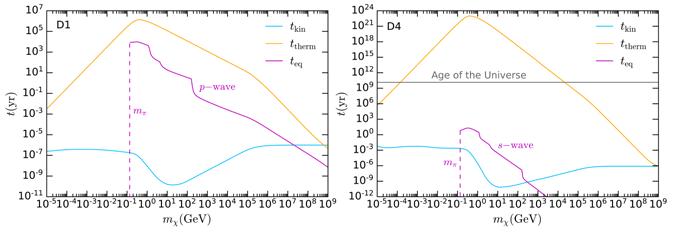
Timescales for kinetic heating (blue), thermalization (orange) and capture-annihilation equilibrium (magenta), for scalar (D1, left) and pseudoscalar (D4, right) DM-nucleon interactions. The scalar interaction (D1) has an unsuppressed scattering cross section and a p-wave suppressed annihilation cross section, while the pseudoscalar interaction (D4) has a strongly momentum suppressed scattering cross section and an unsuppressed (s-wave) annihilation cross section.
Heavy dark matter in white dwarfs
Nicole Bell, Giorgio Busoni, Sandra Robles and Michael Virgato developed an improved treatment for the scattering of heavy dark matter from the ion constituents of a white dwarf. In the heavy dark matter regime, multiple collisions are required for the dark matter to become gravitationally captured. This new treatment incorporated all relevant physical effects including the dark matter trajectories, nuclear form factors, and radial profiles for the white dwarf escape velocity and target number densities. The resulting capture rates differ by orders of magnitude from previous estimates, which have typically used approximations developed for dark matter scattering in the Earth.
The time for the dark matter to thermalize in the centre of the white dwarf was also computed, including in-medium effects such as phonon emission and absorption from the ionic lattice in the case where the star has a crystallized core. This resulted in shorter thermalization timescales than previously estimated, especially if the white dwarf core has crystallized [JCAP 07, 051 (2024)].
Constraining dark photons with self-consistent simulations of globular cluster stars
A key extension of the Standard Model is the dark photon: a new particle similar to the photon in electromagnetism, but with a possible connection to dark matter. If dark photons exist and are light enough, they can have dramatic impacts on stellar evolution, such that stellar properties can be used to derive stringent bounds dark photons. Matthew Dolan, Fred Hiskens and Ray Volkas have undertaken the first dynamical stellar evolution simulations including the existence of dark photons. By comparing their simulations with data from globular clusters, they derived worldleading constraints on dark photon properties [JCAP 05(2024) 099)].
Merging galaxy clusters as giant dark matter particle colliders
Dark matter is the main component of galaxy clusters, which are continuously pulled together by gravity. Ellen Sirks and collaborators show that galaxy cluster mergers can be exploited as enormous, natural dark matter colliders. They analyse hydrodynamical simulations of a universe containing selfinteracting dark matter (SIDM) in which all particles interact via gravity, and dark matter particles can also scatter off each other via a massive mediator. During cluster collisions, SIDM spreads out and lags behind cluster member galaxies. Statistically, they find that the mean of dark matter’s spatial offset in many collisions can be robustly modelled and is independent of viewing angle and halo mass even in collisions between unequal-mass systems [MNRAS 530(3), 3160–3170 (2024)].
Cosmology of axion dark matter
Ciaran O’Hare wrote extensive review on axions as a dark matter candidate, covering thermal and non-thermal cosmological production scenarios, as well as indirect searches for their existence using astronomical and cosmological data [PoS COSMICWISPers (2024) 040].

Diagram depicting the different implications of pre-inflationary and postinflationary breaking on the Pecci-Quinn symmetry for axion cosmology.
Axion Minicluster Streams in the Solar Neighborhood
If axions are dark matter then it has been predicted that they should form ultra-small scale substructures called miniclusters that potentially threaten prospects for discovery on Earth, due to the intrinsically clumpy nature of dark matter on sub-galactic scales. Centre researcher Ciaran O’Hare and team perform numerical simulations of these structures as they infall into the Milky Way halo and get disrupted through stellar interactions. They discovered that the axion distribution on solar-system scales is refilled by a large factor, rescuing prospects for direct detection on Earth, while providing a new signature due to the tidal debris that could be seen in upcoming axion experiments.
Using dust to constrain dark matter models
Using cosmological simulations, Adam Ussing, Robert Mostoghiu, Darren Croton, Celine Boehm, Alan Duffy and collaborators created a Milky Way-like galaxy using cold and warm dark matter cosmogonies. The simulations were tuned to produce similar satellite galaxy populations by modulating the efficiency of converting gas into stars that die in a supernova, with higher efficiency in the cold dark matter simulation and lower in the warm dark matter simulation. This change in supernova efficiency induced a difference in the dust properties of the Milky Way analogue, creating more dust overall within the cold dark matter halo. They also calculated the concentration of dust throughout the halo using the Gini coefficient, finding that the cold dark matter dust distribution was more highly concentrated than in the warm dark matter halo [MNRAS, 534, 2622 (2024)].


Left: orbits of axions miniclusters ending at the Solar position today. Centre: axions stripped from their host minicluster are elongated into tidal streams. Right: Zoom in on mpc scales relevant for experiments, where the network of tidal streams sums to give the local axion density.
Dust surface densities for the Milky Way analogue galaxies. The cold dark matter simulation is shown on the left and the warm dark matter simulation in the middle. The rightmost plot shows the difference between the two: blue indicates regions with more dust in cold dark matter, and red indicates more dust in warm dark matter.
Absorption of fermionic dark matter via the scalar portal
The absorption of fermionic dark matter has recently been studied as a signature for the direct detection of dark matter. However, there has been a lack of concrete theoretical models which yield the proposed signal. Peter Cox, Matthew Dolan and Joshua Wood set out to remedy that by constructing the first UV completion of a particular effective operator which yields the signal. They derived constraints on the model and demonstrated that it was possible for the model to yield the correct amount of cosmological dark matter. However, within this minimal model, the direct detection signal was suppressed in the region of parameter space which gave the correct relic abundance [Phys. Rev. D 109 (2024) 095013].
Classification of three-family flavoured DFSZ axion models that have no domain wall problem
Peter Cox, Matthew Dolan, Maaz Hayat, Andrea Thamm and Raymond Volkas developed a new classification of certain types of axions models. The axion, an important dark matter candidate, can be embedded in a variety of ways into complete extensions of the standard model of particle physics. One general structure for this is termed DFSZ, after the initials of its proposers. However, the standard version of such a theory produces a cosmological challenge known as the “domain wall problem”. The theory features stable wall-like objects that carry large energy densities and can be produced during cosmological evolution. These domain walls may come to dominate the energy budget of the universe in a way that is ruled out by observations. The standard way to deal with this problem is to “inflate away” the domain walls, meaning that the postulated epoch of exponential cosmological expansion known as inflation – needed to cure other ills in cosmology – occurs after the domain walls form. This makes the axion dark matter aspect of the theory less predictive, because its mass density then depends on an unknowable, randomly produced parameter called the “misalignment angle”. A more robust and predictive cosmology ensues if the stable domain walls simply do not exist, which means the standard DFSZ model must be modified. In this paper authored by Cox et al, all such modifications are systematically constructed and catalogued for the first time. The resulting theories have interesting phenomenological implications for the interactions between axions and quarks, and also predict Higgs boson physics that deviates from the standard model and can be searched for at particle colliders [JHEP 02, 011 (2024)].
Scalar dark matter explanation of the excess in the Belle II B+ → K+ + invisible measurement
The Belle II Collaboration has measured the rate for the decay of B+ mesons to K+ mesons plus invisible (i.e. undetectable) particles to be 2.7 standard deviations higher than the standard model prediction. According to the standard model, the invisible final state particles are neutrinos. However, they could also feature dark matter. In this paper, CI Volkas working with collaborators in China, UNSW and Monash University constructed a successful model that explains the Belle II excess by having some of the invisible states be scalar boson dark matter. The parameter space of the model was constrained by searches for dark matter using the Migdal effect [JHEP 07, 168 (2024)].
Extending Global Fits of 4D Composite Higgs Models with Partially Composite Leptons
Kenn Goh, Martin White, Anthony Williams and collaborators Ethan Carragher (Oxford University) and Wei Su (Zhongshan University) performed the first convergent Bayesian global fits of 4D Composite Higgs Models with partially-composite third generation quarks and leptons based on the minimal SO(5) → SO(4) symmetry breaking pattern. They considered two models with the τ lepton and its associated neutrino in different representations of SO(5). Each model was fitted with a wide array of experimental constraints allowing us to analyse the Bayesian evidence and currently-observed fine-tuning of each model. Notably both models were found to be capable of satisfying all constraints simultaneously at the 3σ level at scales of < 5 TeV. From a Bayesian viewpoint of naturalness the model with leptons in the 14 and 10 representations is preferred over those in the 5 representation due to its lower fine-tuning. Finally, they considered the experimental signatures for the preferred parameters in these models, including lepton partner decay signatures and gluon-fusion produced Higgs signal strengths, and discussed their potential phenomenology at future high-luminosity LHC runs [JHEP 08 (2024) 185].
Revisiting Cosmological Constraints on Supersymmetric SuperWIMPs
Martin White, Anthony G. Williams, Meera Deshpande (previous student) and UNSW colleagues Jan Hamann, Dipan Sengupta, and Yvonne Y. Y. Wong studied supersymmetric (SUSY) SuperWIMPs. These are extremely weakly interacting massive particles that inherit their relic abundance from late decays of frozen-out parent particles. Within SUSY models, gravitinos and axinos represent two of the most well motivated superWIMPs. This research revisited constraints on these scenarios from a variety of cosmological observations that probe their production mechanisms as well as the superWIMP kinematic properties in the early Universe. In particular, this research considered Big Bang Nucleosynthesis and the Cosmic Microwave Background (spectral distortion and anisotropies) observables, which limit the fractional energy injection from the late decays, as well as warm and mixed dark matter constraints derived from the Lyman-α forest and other small-scale structure observables. Complementary constraints from collider experiments were discussed. It was concluded that cosmological considerations rule out a significant part of the gravitino and the axino superWIMP parameter space [Eur. Phys. J. C 84, 667 (2024)].
Symmetries, Spin-2 Scattering Amplitudes, and Equivalence theorems in Warped FiveDimensional Gravitational Theories
Five-dimensional Kaluza-Klein (KK) models are relevant to particle physics because they provide a framework for unifying fundamental forces, including gravity, and predicting new physics beyond the Standard Model. Joshua Gill, Dipan Sengupta and colleagues from UC San Diego and Michigan State University showed how the residual five-dimensional diffeomorphism symmetries of compactified gravitational theories with a warped extra dimension imply Equivalence theorems which ensure that the scattering amplitudes of helicity-0 and helicity-1 spin-2 KaluzaKlein states equal (to leading order in scattering energy) those of the corresponding Goldstone bosons present in the ‘t-HooftFeynman gauge. They derived a set of Ward identities that lead to a transparent power-counting of the scattering amplitudes involving spin-2 Kaluza-Klein states. They explicitly calculated these amplitudes in terms of the Goldstone bosons in the RandallSundrum model, checked the correspondence to previous unitarygauge computations, and demonstrated the efficacy of ‘t-HooftFeynman gauge for accurately computing amplitudes for scattering of the spin-2 states, both among themselves and with matter. They described how these results apply to more general warped geometries, including models with a stabilized extra dimension [Phys. Rev. D 109, 075016].
Scattering Amplitudes of Massive Spin-2 KaluzaKlein States with Matter
Joshua Gill, Dipan Sengupta and colleagues from UC San Diego and Michigan State University performed a comprehensive analysis of the scattering of matter and gravitational Kaluza-Klein (KK) modes in five-dimensional gravity theories. They considered matter localized on a brane as well as in the bulk of the extra dimension for scalars, fermions and vectors respectively, and considered an arbitrary warped background. While naive power-counting suggests that there are amplitudes which grow as fast as O(s3) [where s is the center-of-mass scattering energy-squared], they demonstrated that cancellations between the various contributions result in a total amplitude which grows no faster than O(s). Extending previous work on the self-interactions of the gravitational KK modes, they showed that these cancellations occur due to sum-rule relations between the couplings and the masses of the modes that can be proven from the properties of the mode equations describing the gravity and matter wavefunctions [Phys. Rev. D 109, 015033].

research activity plan for 2025
WIMP Direct Detection:
SABRE South:
• Fabrication of the shielding and its installation in SUPL
• Commissioning of the NaI(Tl) crystal handling glove box in a clean tent space at SUPL, and assembly of the high purity crystal detector modules in the vessel
• Continuous operation of the muon detectors for the analysis of flux and angular distribution of muons reaching SUPL
• Start the operation of the SABRE South detector
• Publications on photosensor characterisation, cosmic ray background, studies of induced annual modulation, and sensitivity studies for various types of dark matter candidates
r&d Cygnus:
• Development of the CYGNET prototype using LE25 funding
• Exploration of radon emanation measurement and radon suppression techniques
• Continuation of directional neutron detection program
• Follow-up on recent results, including dissociative electron attachment and boosted dark matter
Current and next generation liquid xenon TPCs:
• Contributions to simulations and detector monitoring sensors
• XLZD design and sensitivity studies
• Transport and commissioning of the Xemis-1 prototype LXe system from Subatech Nantes, for studies of LXephotosensor systems
AXION and WISP Direct Detection:
• R&D on quantum technologies and cavity resonators for ORGAN Phase 2, ORGAN Q, ORGAN Low Frequency and other dark matter experiments
• Investigation of cryogenic implementation of low-noise oscillator designs using high-Q superconducting resonators for UPLOAD and UPLOAD-ANYON
• Continued investigation of low mass axion detection experiments to increase the range of axion masses covered, with the ADMX and ORGAN collaboration
• Continuation of ADMX sensitivity calculations, data analysis and simulations and modelling for future high and low mass extensions
• Continuation of improvements to existing Scalar DM detection experiments and searches for new physics
Precision Metrology (nuclear):
• Continued development of an AMS capacity to measure 210Pb at ANSTO accelerator
• Evaluation of the integrated fast isotope switching /time-of-flight detection systems
• Investigate potential for SIMS/AMS capability for 40K and other relevant naturally occurring radionucleotides in collaboration with HZDR
• Develop AMS capacity to measure fission product fragments
LHC:
• Initiating new search for dark matter produced in association with top quarks
• Completion of searches for final states with jets, flavour-tagged jets and missing transverse momentum
• Extension of analyses techniques for further novel searches for dark matter including using displaced vertices
• Improvement of hadronic jet measurements and algorithms to use global particle flow to better understand hadronic measurements
• Production and QC of the silicon detectors for the ATLAS inner tracker upgrade for High Luminosity LHC
• QC of the silicon detectors for the ATLAS inner tracker upgrade for High Luminosity LHC
Theory:
• Develop new techniques to probe low-mass dark matter
• Determine the impact of dark matter on neutron stars and other astrophysical systems
• Understand and quantify the impact of nuclear structure on dark matter direct detection rates
• Develop schemes to explain the dark matter mass scale in asymmetric dark matter models
• Perform global fits to dark matter direct detection data, and determine the reach of future experiments
• Determine constraints on and potential new signatures of wellmotivated dark matter models.
SUPL update
2024 marked the end of Dr Sue Barrell AO FSTE’s term as Independent Director and Chair of the SUPL Board. Over the past three years, Sue has been the driving force behind SUPL’s growth and increased visibility on the national and international stage. Sue’s impact has been greatly appreciated, and she has also been a valued supporter of the Centre’s research, particularly SABRE South. Sue continues as an Advisory Board member of the Centre.
Members of the Centre’s International Scientific Advisory Committee, Nigel Smith and Tony Gherghetta visited SUPL in 2024 as part of their visit for the Centre’s ISAC meeting.
Professor Smith said, “I am challenge orientated and setting up underground laboratories has very specific challenges, especially when they are based in mines that have a very different purpose and are geared towards production.”
He said he enjoyed supporting the development of the SABRE South experiment at SUPL.
“The number of people involved in building deep underground labs is quite small so I hope that I can help avoid some of the mistakes that have been made elsewhere, and make sure the Centre benefits from my experience.”
SABRE South in SUPL
As detailed above in the SABRE South report, the first major systems of the experiment were installed in SUPL in 2024. This includes the muon detectors and data acquisition systems. The logistical exercise to get this large and delicate equipment from the University of Melbourne to Stawell and transported down into the laboratory provided us with valuable experience. Data taking has been ongoing in 2024 and there will be papers forthcoming in 2025.
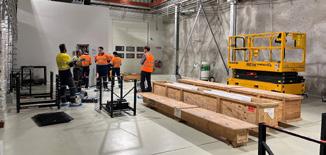
CELLAR Update
The Cryogenic Experimental Laboratory for Low-background Australian Research (CELLAR) saw notable progress in 2024. The tendering and ordering process for the dilution refrigerators was finalised and they then entered the production phase. The above-ground dilution fridges is expected to be installed in the first half of 2025, with the underground fridge to be installed later in 2025. These new facilities will broaden the experimental capabilities of SUPL and open avenues for additional lowtemperature physics research in a cosmic ray shielded environment.
During 2024, Ben McAllister was invited to present at the RISQ workshop at Fermilab, sparking early-stage collaboration talks with the QUIET underground dilution fridge facility. Researchers from both industry and academia have also expressed interest in CELLAR and its potential applications. The first CELLAR-adjacent experimental work took place in November 2024, when postdocs William Campbell and Ben McAllister brought Quartz Oscillators (provided by Quantic Wenzel) into SUPL to measure their frequency stability and determine the impact of cosmic rays. They aim to extend this research into a cryogenic environment once the underground fridge is operational, potentially revealing new insights into oscillator stability in cosmic ray shielded conditions.
SUPL outreach and communication activities
SUPL was included in 102 Things to do With a Hole in the Ground, the second edition of the book published by The Eden Project in 2024, which promotes the idea that beneficial uses can be derived from repurposed mines and infrastructure.
SUPL also received a Victorian Government Enabling Tourism Grant to explore the feasibility of establishing a state-of-the-art Science Outreach Centre in Stawell. The centre would be styled as the Dark Matter Experience Centre and aims to attract new visitors to the region and provide information about the cutting-edge research happening in Stawell.
SUPL Facility and Laboratory Manager Kim Mintern-Lane said “This places Stawell on track to become an innovative and inspirational centre for scientific research and educational outreach, bringing together a world-class underground research facility and a stateof-the-art Science, Technology, Engineering, Arts and Mathematics (STEAM) outreach centre,”.
The feasibility study will be undertaken in 2025 and will include input from the Centre as well as many other stakeholders.
The Centre actively continued to support the internationalisation of SUPL through visits, talks at international conferences (including ICRI mentioned later in this report) and works closely with SUPL on the promotion of media stories and outreach activities.
Boxes of muon telescopes in SUPL ready for installation.
translation
Fundamental science by its very nature rates low in technology readiness levels when it comes to commercial transformation of research, and depending on the type of science knowledge, different innovation and development activities are needed to develop product applications.
After returning from parental leave with fresh eyes, Christine Thong suggested we pivot our approach from investment readiness workshops and idea testing scholarships (that had very low uptake), starting with consulting CDM members to understand our specific challenges, needs and opportunities related to research translation.
To do this, Christine Thong, supported by Maxim Goryachev and Anita Vecchies, facilitated a research translation discussion and feedback session at the Centre’s Annual Workshop.
Centre members discussed and provided feedback on three guiding questions detailed below.
1. Why is it important to translate/commercialise research?
• It creates a positive impact on society and encourages government funding
• It can fund ongoing research outside of limited grants
• It provides opportunities for students’ future careers
• It helps the public realize why science is still important
• It can lead to recognition with peers
2. Are you interested in translating research?
• Some ARE interested in translating research, some are NOT
• Some are interested in founding a start-up
• Some are open to commercial projects
• Some are interested in engaging the wider community in science
• Others are interested in creating art
3. How might CDM translate more research? And what are current barriers?
• Time is a major challenge, especially for Early Career Researchers
• There is a need for training and industry experts
• Students need translation knowledge and expertise
• Researchers are often unsure of the translation process and market needs
• There is potential in utilizing public interest topics
The responses to these questions, together with recommendations from the Centre’s Mid-Term Review, will inform the Centre’s activities going forward. This will include:
• Developing a process for managing disclosures and commercialisation pathways. This will be built into the Centre’s training sessions through activities such as guest speakers at our fortnightly meetings and talks or training sessions from industry at our annual Centre workshop.
• Forming a new Research Translation Committee to promote/ champion translation & innovation activities in the Centre, define activities to help shift culture towards increased translation and run activities with a translation focus.
• Supporting students & ECR’s to upskill in innovation techniques and mindset by immersing in global best practices via a 2-week experience at CERN’s innovation lab IdeaSquare.
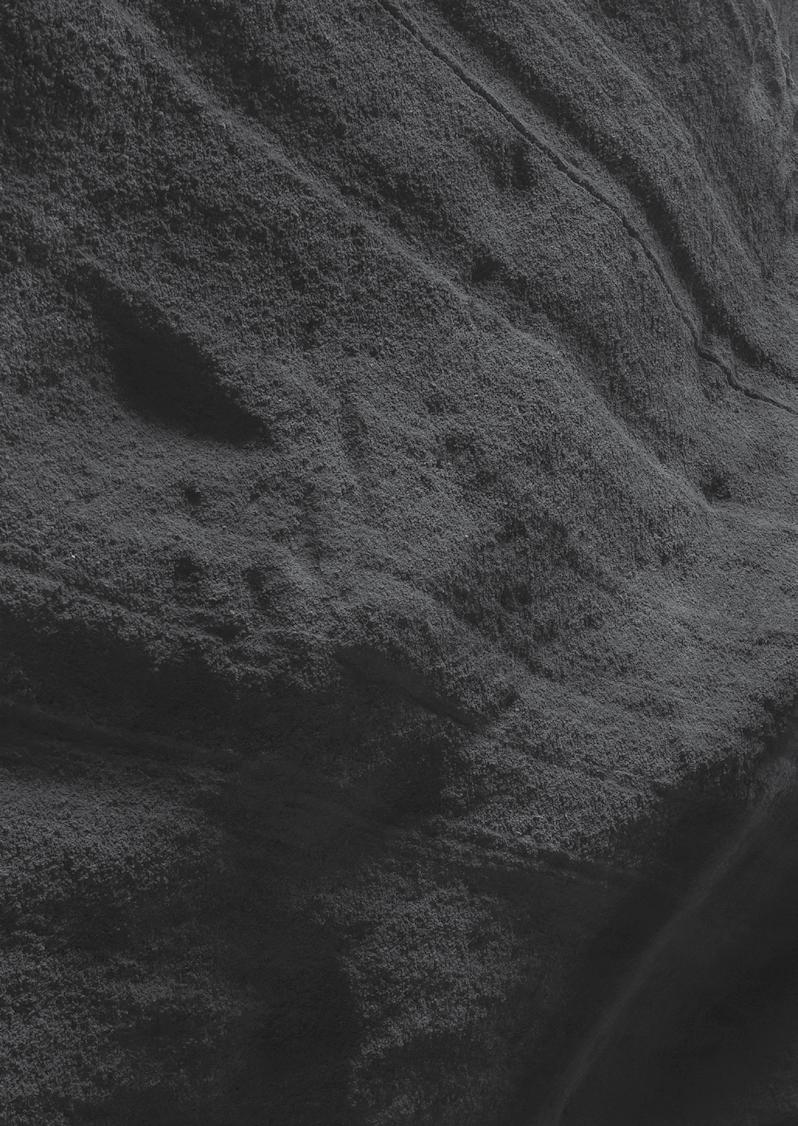
case study
Search for dark matter leads to breakthrough in pharmaceutical technology
Research to uncover the nature of dark matter led University of Western Australia scientists to solve a problem of an entirely different kind.
Jeremy Bourhill and Emma Paterson were developing a twisted light resonator to detect ultralight dark matter when they recognised its potential use in the pharmaceutical industry to make the manufacture of drugs safer and more affordable.
“Originally, these devices were designed for dark matter detection,” says Emma of the twisted light resonator. “The unique twisted light inside the cavity resonators makes them highly sensitive to detecting hypothetical dark matter particles like axions.
“However, while researching this twisted light, I realised that it could also interact with molecules. More importantly, we discovered that we could engineer this twisted light in a large, open volume—allowing us to manipulate molecules in bulk.
“This realisation led to the unexpected discovery that the device could be used to separate chiral molecules efficiently.”
A chiral molecule has a mirror image, or a left-handed and righthanded version. The same ingredients make up the molecule but they are arranged differently. In drugs, these versions have very different effects on the human body.
Thalidomide is perhaps the most famous example of a chiral molecule: the right-handed version suppressed cancer, but the lefthanded version caused birth defects. The resonator could replace the current technology used by pharmaceutical companies to manufacture drugs that is slow, expensive and limited in capacity.
“Our device could significantly improve drug manufacturing by making the process more scalable, reducing waste and lowering production costs. In the long term, this could accelerate drug discovery and improve access to critical medications,” Emma says.
“This was a classic case of fundamental research leading to unexpected innovation. We weren’t initially searching for a way to separate chiral molecules - our focus was on dark matter detection. But the moment we realised that twisted light could interact with and manipulate molecules in a controlled way, it was a real ‘Eureka’ moment.
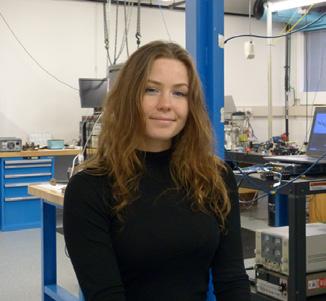
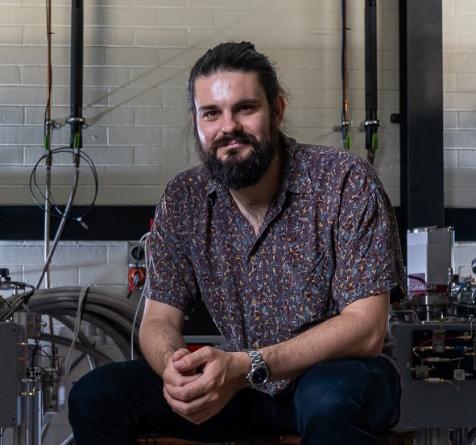
“It was surprising and exciting to see how a device built for dark matter detection could have such a significant impact in pharmacology.”
CDM Special Initiatives funding
In early 2024, the first main funding round of Special Initiatives was run. All Centre members could apply for funding for projects in the Centre that are aligned with the Centre’s strategic priorities, help the Centre ‘achieve more than the sum of its parts’ and promote collaboration across the node. Special Initiatives funding can support all aspects of Centre activities including research, mentoring, outreach, equity, diversity & inclusion, and translation.
More than $330,000 was awarded across the eight projects representing all the nodes of the Centre. A list of the projects and some highlights of the progress achieved in 2024 is outlined below.
DREAMR: Detecting Radon Emanation and Mitigating Radon to Support Low Background
Detector Development and Underground Operations
Lindsey Bignell (ANU) and team from ANU, UoA, UoM and UoS
This project proposes to create a radon measurement system capable of performing low-background emanation measurements and studying high-performance radon filtration materials. Most components required to build the DREAMR apparatus have been ordered and received —the MFC, gas-independent gauge, and turbo pump are operational and have been tested. The Rad8 radon counter (and associated software/electronics) has been ordered but has not yet been received. The Swagelok hardware has also been ordered and received, and the final design of the emanation chamber is awaiting delivery of the Rad8. Early measurements of the outgassing of detector components (which limit the radon emanation measurements) have been carried out using the turbo pump and a residual gas analyser.
MonA LiSA: Monitored Apparatus for Liquid Scintillator Algorithms
Irene Bolognino (UoA) and team from ANU, SUT, UoA, UoM and USyd
Muon Detectives: Empowering Educators & Engaging Students in Dark Matter Science
Jackie Bondell (Central) and team from ANU, SUT and UoM
This project will develop educational and outreach programming and training to support the use of muon detectors in CDM partner school classrooms and as a node-based outreach tool. Muon detectors (EduMODs) have been purchased and are roll out to nodes has commenced for local outreach and as class sets for use in CDM partner schools.
New curriculum-aligned lessons are being developed for piloting in our partner schools in conjunction with secondary teachers and the Melbourne Graduate Schools of Education (MGSE). Similarly, new outreach activities are being developed for using the detectors for engagement in conjunction with the appointment of ECR Outreach Ambassadors from each node. The CDM Outreach Ambassadors and teachers from our partner schools will train together in a joint professional development workshop, delivered by the team proposing this project. In conjunction with the MGSE, we will evaluate the educational impact of this pilot in CDM partner schools, strengthening the connection between schools and CDM.
2024 XLZD-Oz workshop
Robert James (UoM) and team from UoM and USyd
See details of this workshop, which was held in late 2024, in the Events section.
CELLAR Enhancement and Usability Upgrade
Ben McAllister (SUT) and team from UWA
Unlocking new capabilities for SABRE
Peter McNamara (ANU) and team from ANU, UoA and UoM
Dark Matter Plotter
Ciaran O’Hare (USyd)
The Axion-MonoPole-Detection (AMPD) Experiment
Mike Tobar (UWA) and team from UWA and ANU
Recent theories in axion electrodynamics suggest the existence of two additional axion coupling constants: the axion-electric monopole coupling constant and the axion-magnetic monopole coupling constant, which opens up new possibilities for direct axion detection experiments. The work presents the preliminary trial of the Axion Monopole Detection (AMPD) experiment, which aims to use the axion-magnetic monopole coupling to detect an axion signal.
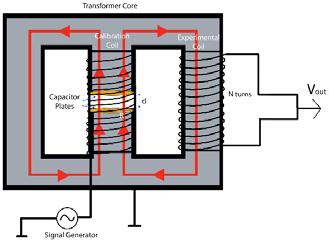
A voltage was applied to a pair of capacitor plates connected to a magnetic circuit, and a spectrum analyser was used to determine whether an axion generated magnetic flux was produced. Though no axion signal was observed, this experiment allows for a limit of up to 7×10−5 on the axion-magnetic monopole coupling constant to be placed, and provides a basis for future axion detection research. In the near future we expect to be able to improve on these results to the order of 1011 using low noise impedance amplifiers at the output.
Student Emily Waterman used the device during her honours project and completed her thesis titled ‘Setting a limit on the axion-magnetic monopole coupling constant using a high-voltage capacitor’.

Diagram of proposed experimental setup (left). The red lines indicate the movement of the magnetic flux. And the setup with both readout coils placed on the core (right). Credit – Emily Waterman
Projects that were awarded CDM Special Initiatives
ECR funding in 2023 made good progress in 2024. A summary of the progress of two of the projects is presented below.
Establishing a computing subgroup
Jayden Newstead (UoM) and Matthew Green (UoA)
The goal is to bring together Centre members from all research themes, nodes and levels to meet and discuss advancements in computing, share their skills and experience, and foster internode collaboration. The computing subgroup kicked off in 2024 and enlisted local organisers from each node. The inaugural event was a three-day hybrid workshop aimed at upskilling the computing skills of ECRs across the Centre comprised a series of lectures and workshops on different computing topics. There were 50 registrations across all nodes and research themes. The registrants were mostly PhD students but also included Masters and undergraduates. There were also three additional mini-workshops held throughout the year and there are future plans for an inperson hack-a-thon. All workshop material are available to Centre members on GitHub.
New Low Mass Axion Detection Program – ORGAN Low Frequency
Ben McAllister (SUT), Aaron Quiskamp (UWA) and Elrina Hartman (UWA)
This funding supported the purchase of a prototype axion detector for the ORGAN Low Frequency experiment, along with along with various microwave equipment needed both for the characterisation of the prototype experiment, and the characterisation and operation of the eventual full scale ORGAN Low Frequency experiment. Improvements were made to the detector design based on the prototype. The procurement and operation of the fullscale axion detector will occur in 2025. This project extended the collaboration between the Centre’s UWA and Swinburne nodes and was presented at the Patras Workshop on Axions, WIMPs and WISPs and in a public lecture presented during the National Quantum & Dark Matter Road Trip.


equity, diversity and inclusion
The Equity, Diversity, and Inclusion (EDI) portfolio exists to improve gender balance in STEM, support families and carers within the Centre, inspire a new, more diverse generation of STEM researchers, and build a culture of respect and inclusion. The EDI committee includes willing representatives from each node. It remained very active throughout 2024, meeting frequently to plan Centre events, refine policies, and further the Centre’s commitment to fostering an inclusive environment.
Following the successful introduction of cultural snippets at the 2023 workshop, many presentations at Centre meetings and the Centre’s newsletter throughout 2024 incorporated a cultural snippet from a Centre member. This initiative encouraged members to share aspects of their cultural background, such as a favorite food, a hometown tradition, or a meaningful song, helping to build stronger connections among colleagues.
A significant policy update in 2024 was the amendment of the Centre’s Code of Conduct to clarify and improve the various ways members can report breaches of the Code of Conduct. This update introduced the option to seek assistance from a designated Centre Contact Officer. The update was approved by the Centre’s Executive Committee and will roll out in 2025 with trained Contact Officers at each node. These impartial advisors will be equipped to aid in initiating conversations with involved parties, assist in gathering feedback and offering guidance on addressing concerns. They will also have a thorough understanding of the Centre’s Code of Conduct and the HR processes at their respective institutions, ensuring they can provide information on available options for the reporting and management of potential breaches
Additionally, the EDI page on the Centre website was updated to provide more detailed information about the Centre’s commitments and additional resources to support equity and inclusion efforts.
In addition to exisiting initiatives such as a quiet space and social script, the Centre’s Annual Workshop in 2024 incorporated a range of new initiatives aimed at fostering cultural appreciation and community spirit. It opened with a traditional smoking ceremony led by the local Elders, accompanied by the sounds of the didgeridoo. This powerful experience helped ground attendees on the land which they were gathered in North Wollongong. Later in the workshop, a weaving session was run by Speaking in Colour.
Participants learned that in First Nations history, weaving was considered a life skill rather than a gender-specific craft and weaves differed from region to region and person to person. Each member wove their own bracelet to take home as well as the beginnings of a basket, which contributed to a framed artwork that is now displayed at the Melbourne node of the Centre.
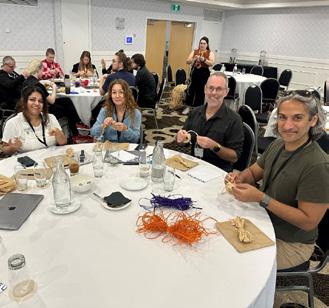

The workshop dinner concluded on a high note with a talent show, which was the highlight for many. Members showcased their hidden talents and hobbies, including a dance by Sharry, blindfolded chess from Kyle, a sea shanty lesson from Navneet, singing by Victoria, a jazz performance from Willem and Jamie, rapid Rubik’s cube solving by Albert, a particle physics-themed stand-up comedy act by Maaz, and a cake replicating the SABRE South Experiment vessel made by Kamiel. The evening ended with Professor Ray Volkas on piano, rounding off a workshop filled with celebration, learning, and community building.
Another key initiative for 2024 is the Centre’s involvement in coleading the organisation of inSTEM 2025. inSTEM is a conference for Centre of Excellence members, dedicated to advancing equitable practices for marginalised and underrepresented people in STEM, while also welcoming those committed to becoming better allies. This two-day networking and career development conference provides a safe, inclusive space to connect, share experiences, and learn from experts on advancing careers in STEM while fostering inclusivity.
Through these initiatives, the EDI committee has continued to drive meaningful change, ensuring that the Centre remains a welcoming and inclusive environment for all members. Plans are already in place to build upon these efforts in 2025 and beyond.

Irene Bolognino shines a spotlight on the challenges of motherhood in academia
The reality for women who combine science careers with motherhood is no walk in the park, according to physicist and mother Dr Irene Bolognino. The University of Adelaide dark matter lecturer believes that a work environment that considers the need of a new mother is therefore crucial.
Irene gave birth to her son in 2023 and returned to work after 24 weeks of maternity leave. She was not only the first mother to work as an academic in the particle physics department of her university, but also the first female academic.
She describes the transition as ‘tough’, especially after sleepless nights and illness in the family. However, she hopes that by speaking openly about her experience, she can help create a more welcoming environment for women returning to academia after maternity leave.
“Coming back to work was a real challenge, because a job in academia is very dynamic, but it is feasible in a supportive environment,” she said.
“I want to talk about the experience, and I think that’s a good starting point to improve things.”
“If we look at the numbers of female academics in STEM disciplines, it is clear that achieving gender parity is still a long way off. In fact, the number of women decreases dramatically as seniority increases, which also indicates a difficulty in balancing an academic career and family.”
At an event for the Dark Matter Centre, where she is a member of the mentoring committee, Irene was asked by several female students about her experience.
“They were worried that they wouldn’t be able to have a family in the future if they pursue to work in academia. They asked me what my secret was, as if there was some trick (beyond being organised, of course) by which, I manage to have a family without compromising my career.”
“This concept may also derive from stereotypes inculcated in women over the years to convince women that they can have it all - both a career and a family - and that this is entirely up to them. Thus, those who cannot achieve both (even if they want to), think it is their fault. The point is that there are several factors that play a key role in making it possible to combine a career and family, the work environment, among them” she said.
In fact, Irene says it should not be the role of mothers to create an equitable workplace on their own, and that organisations, colleagues, and new parents need to work together.
She considers herself fortunate to have gained significant support from her colleagues, both from the University of Adelaide and the Dark Matter Centre, which helped make her transition back into the office easier.
She wants women to know the workplace culture, including the support of colleagues, is a crucial factor in their ability to combine motherhood with work.
“The environment that I returned to played a primary role in my experience. When I came back, I was exclusively breastfeeding my baby so that meant I had to pump during the day, which is physically and mentally demanding. It made a big difference that everyone was very supportive throughout my pregnancy and return to work.”
“I have always been provided with a private space in the office when expressing breastmilk, consecutive meetings have been avoided so that I had the time to express between, and I am able to attend online meetings if they are not part of standard working hours and I have to pick up my son from childcare,” she said.
“Unfortunately, I did not encounter collaborative attitudes in all situations; for example, I was unable to attend an important conference overseas because it was in-person only, with no possibility of making any exceptions for online participants. I had a high-risk pregnancy and couldn’t travel for medical reasons, and that was disappointing, because we know how important giving talks at conferences is for academic careers.”
“However, since becoming a mother, despite the tiredness and motherhood duties, I have organised and attended conferences both nationally and overseas and I’m very committed to my work.”
“It is not true that mothers are no less committed or productive than fathers or childless peers. This is an assumption that it is wrong and damaging.”
Irene says awareness, understanding and communication can help mothers and their colleagues navigate some of the challenges and obstacles.
“I think it’s important that colleagues are aware that new challenges exist, and small changes can make a big difference to new mothers. These changes can help to reduce the gender gap in some environments, including academia.”
“Thankfully, there is an increasing emphasis on hiring staff from under-represented categories, but people are sometimes unprepared to meet the specific needs that these people have.”
“Diversity can bring a lot of value to an organisation because each individual has a lot to offer.”
“It requires effort, but by creating an environment that supports the mental health of mothers – or any diverse workers – those individuals are able to give their best.”
She believes visibility can make be influential, showing younger women that it is possible to pursue an academic career while also having a family.
“I don’t want to be another person telling women they can do it all, but we need to talk so that everyone understands the challenges and needs and can do what they can to create a supportive and equitable workplace for everyone.”

“Thankfully, there is an increasing emphasis on hiring staff from under-represented categories, but people are sometimes unprepared to meet the specific needs that these people have.”
media and communications
The Centre’s media and communications activities aim to celebrate and promote the diversity of our research and researchers, develop and provide a platform for members, inspire a diverse future generation of scientists and build a cohesive community of researchers.
In 2024, the Centre’s work and its members were actively promoted and featured across different platforms including radio, television, podcasts, social media, online and print media.
Promoting women in science
One of the ways in which we inspired the scientists of the future was through our activities promoting women in science. We aimed to make women in science visible to the wider community, providing them with an opportunity to discuss their research and explain why they chose careers in science.
This involved promoting both women at a senior level and those at the beginning of their science careers.
On International Day of Women and Girls in Science, our social media campaign quoted women in the Centre on their passion for their work and appeared across Instagram, Facebook, Twitter and LinkedIn.
On International Women’s Day, we promoted Elisabetta Barberio’s professional journey and an article was published across Australian Associated Press’s more than 80 publications across Australia, including The Canberra Times. Victoria Bashu also spoke with 2CC radio’s Canberra Talking program about her experience as a woman in science.
We also embraced opportunities to promote women in science throughout the year, with Zuzana Slavkovska speaking to ABC Canberra about her experience in response to a study about the performance of girls in maths and science in Australia.
By taking part in these media and social media campaigns, the Centre showed leadership in the promotion of women in science, while also providing media experience to researchers and opportunities to discuss and build excitement around our dark matter research.
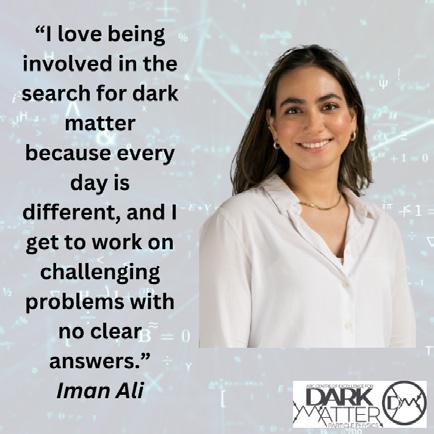
Inspiring remote, rural and regional communities and building links with schools
The Centre promoted science to rural, remote and regional communities with a range of media and social media activities in 2025.
The promotion of the Partner Schools Program’s expansion into New South Wales attracted positive media stories, including a television segment on Channel 7 Riverina and 2GB radio’s national rural news program. The story was also covered by a range of ABC radio programs, including ABC Canberra.
During the National Quantum & Dark Matter Road Trip, we engaged directly with local communities via Facebook to promote our events and school visits.
We also promoted dark matter science in these communities through the media, and, in particular, highlighted our work engaging Indigenous students through the road trip.
A story about our visit to remote communities in the Northern Territory appeared in the Herald Sun, The NT News, the Daily Telegraph and other newspapers across Australia.
Another article about the road trip by the Australia Associated Press reached about 80 publications and led to an article in Education HQ that reaches Australia’s teachers and school administrators.
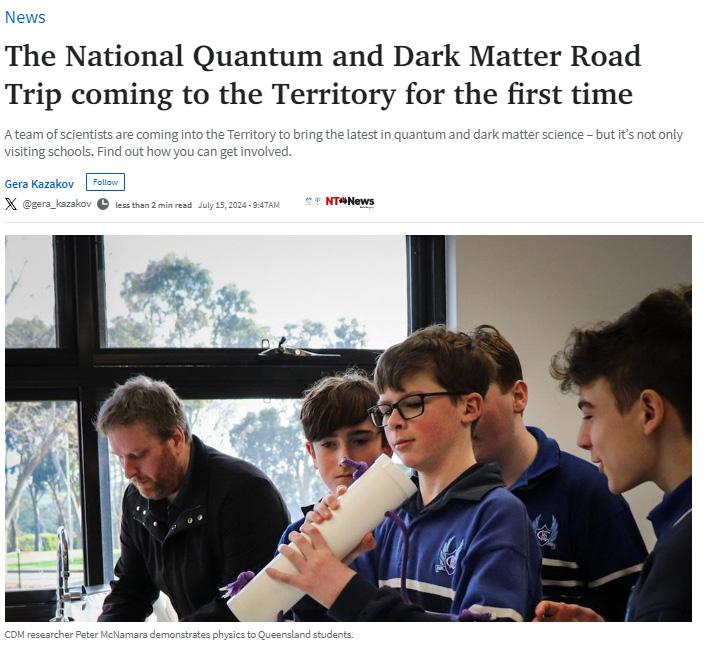
Promotion of our world leading Centre-led
research
In 2025 we promoted the Centre’s research and achievements in the media, social media, Centre website and Dark Matters newsletter.
The Meet the Researcher feature on the Centre’s website and across social media channels enabled members to talk about their pathway towards dark matter science and their current research.
We celebrated the achievements of Centre members via our website, newsletter and social media accounts.
One example was the Centre’s partnership with The University of Melbourne to promote Theory research on neutron stars, which appeared in the university’s Pursuit magazine, on the Faculty of Science website and in online science publications, as well as on our website, social media channels and website.
During our mid-term review, a video was produced to explain the research happening across the Centre’s nodes.
The Centre’s research was also celebrated during public talks throughout the year and during the National Quantum & Dark Matter Road Trip. Highlights included a lecture in Ballarat by Elisabetta Barberio (pictured) that attracted local media and an audience of about 200 people interested in hearing about the Centre’s research, and SABRE South in particular.
We attended the Stawell Easter Extravaganza, where our researchers spoke with community members about the SABRE South experiment, building excitement and a sense of community participation in the research.
These activities recognise the work that our researchers are doing, highlighting their success among a national and international audience or researchers and the wider public.
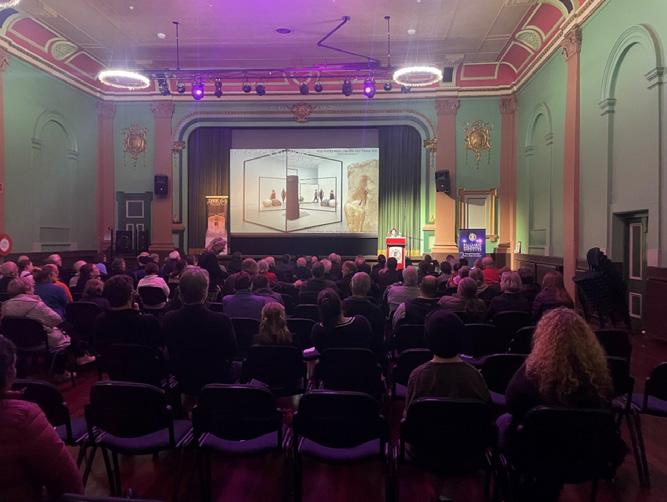
Student and ECR development opportunities
The Centre aims to develop the communication skills of students, ECRs and researchers by offering opportunities to engage with the media.
In 2025, students who were interviewed on live radio included Mike Mews (ABC Wimmera and Einstein-a-Go-Go on 3RRR), Renee Key (Einstein-a-Go-Go) and Alex Ritter (Einstein-a-Go-Go). These students were coached on media skills and messaging and before their interviews. These interviews provided media experience and the opportunity to promote the students’ research.
Victoria Bashu also had the opportunity to talk about her research and gain media experience on the Canberra Talking program on 2CC radio, while Adam Ussing spoke to ABC Warrnambool about his experience as a regional student pursuing science research.
Students and ECRs were also provided opportunities and training in engaging with the media during the National Quantum & Dark Matter Road Trip. These interviews gave students media skills and experience, and enabled them to share their interest in science with communities across Australia.

Social media
The landscape of social media is constantly evolving and the Centre’s activities aim to tailor content to the specific groups that use each channel and maximise reach across all social media accounts.
The number of followers has increased across all channels, and Instagram in particular, which saw followers almost triple, from 373 in January to 953 in December.
There was a significant increase in page impressions (views) and engagement on LinkedIn, as the site itself has become more popular.
The Centre’s Facebook account was useful for promoting events and targeting specific communities, particularly in Stawell and during the National Quantum & Dark Matter Road Trip. Stawell residents are particularly active on this site and Facebook is a useful tool for engaging with this community.
Internal communications
The Dark Matters newsletter is distributed to Centre members every three months and features information about successes, opportunities and events throughout the Centre.
The newsletter not only provides information, but also helps build a sense of belonging within the Centre, especially in Cultural Snippet/ Hobbies and Talents, Meet the Researcher and travel recounts. Engagement with the newsletter was high across the Centre, with the December edition opened 243 times. Popular articles include details on Annual Workshop registrations, media articles featuring Centre members and news about recent events.
Researchers communicate informally across the nodes via SLACK, using different channels for research, outreach and ECR activities. The Centre uses the Atlassian collaboration software Confluence to coordinate meeting agendas, store and share documents and technical information.
A Centre-wide meeting is held each fortnight, in which a member or invited guest provides information about their research, or other relevant topics.
PhD student Alex Ritter on Einstein-a-Go-Go.
media highlights and stats
Zuzana Slavkovska (ANU) speaks on 7 news about the CDM Partner Schools program.

AAP article syndicated in over 80 outlets covering the National Quantum & Dark Matter Road Trip. Interviews with Ben McAllister (SUT) and teacher at Bulla Camp School in the NT.

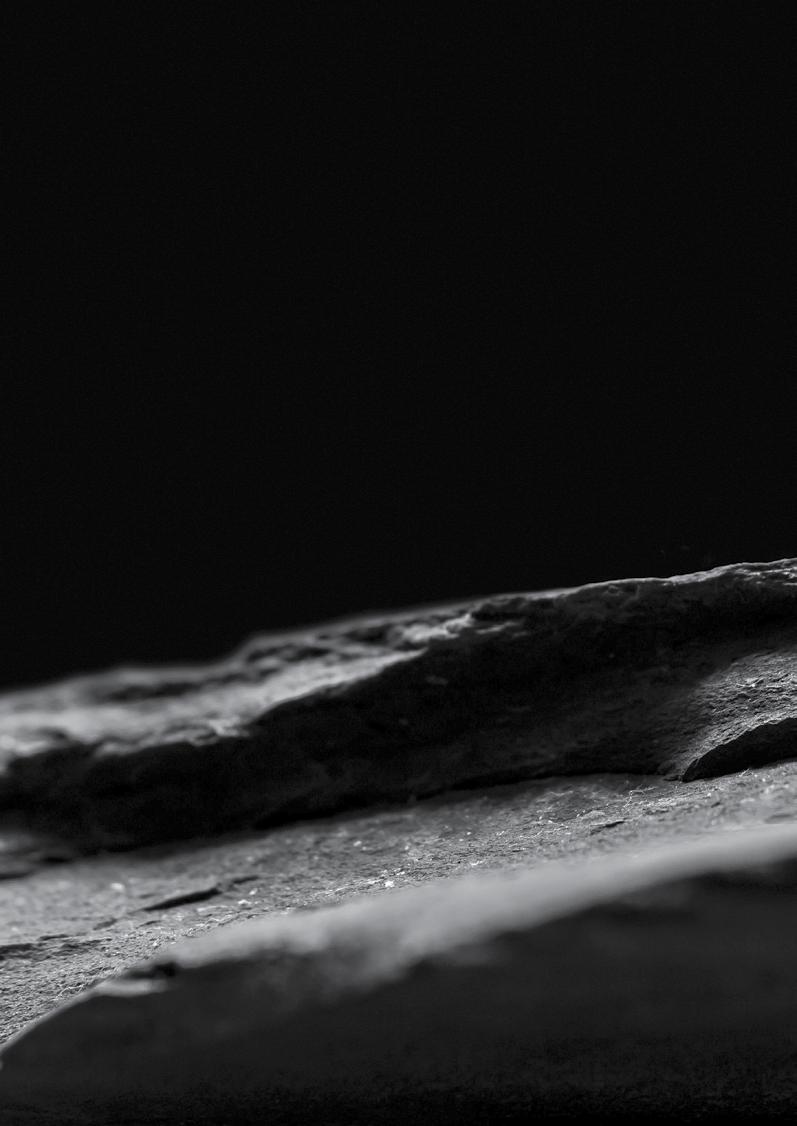
Facebook post reach
(2021)
(2022)
(2023)
(2024)
LinkedIn impressions
(2021)
(2022)
(2023)
(2024)
LinkedIn Followers 139 (2021) 503 (2022)
(2023) 1,099 (224)
AAP article about Elisabetta Barberio (UoM) syndicated across 99 outlets.



Paul Jackson (UoA) was named the top researcher in Australia in the field of High Energy & Nuclear Physics in The Australian’s Research magazine.
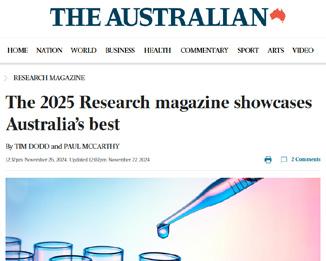
Emma Paterson (UWA) was interviewed by Innovation Nation TV about the twisted light discovery that arose from her PhD on dark matter.
outreach, education and engagement
The vision of the education and public outreach program of the Centre is to share the excitement and benefits of Australia’s hunt for dark matter to inspire and train a new generation of innovative thinkers. In 2024, there were many opportunities for in person outreach and education activities and Centre members were able to interact with over 110 schools, visit and particpate in conferences and participate in 28 public events.
Partner Schools
In 2024, the CDM Regional Partner Schools program expanded into NSW, with two new partner schools in Wagga Wagga and one in West Wyalong, in addition to our four partner schools in Victoria. The goal of this program is to cultivate long-term relationships with schools in areas traditionally underserved by science engagement programs.
In the first year of the partnership, CDM members lead activities with all Year 7 classes at the school, as well as with any senior Physics students. In the second year, the lessons expand to those students as Year 8s in addition to the new Year 7s. This pattern continues with the goal of creating a longitudinal impact on student decisions to remain engaged with science and technology through their final secondary years and into tertiary education. The topics covered in these lessons not only include Dark Matter-related Physics topics such as gravitation, galaxies, and the Standard Model, but also broader understandings such as Scientific Inquiry, Experimental Investigations, and the evolution of Scientific Understanding.
In 2024, CDM expanded the activities with the regional schools to include muon detection activities for Physics students in Years 11 and 12. As part of the newly launched ‘Muon Detective’ initiative, CDM is providing EduMod muon detectors and pilotng new lessons for students to work with authentic data as part of their Physics learning. This initiative will be expanded in 2025 to support studentled research projects in conjunction with US-based high school students, fostering international science colaboration from the secondary school level.
Additionally, CDM offers additional engagement activities such as a student arts competition and science quiz games to better understand how they relate to the content they are learning. The Centre has been collaborating with the Faculty of Education at the University of Melbourne to assess the impact of these programs on regional student attitudes towards science and whether they change over time.

ANU physicist Zuzana Slavkovska talks to Kooringal High School students.
Case Study - Working with Rural Schools
One of the main aims of science outreach is to increase engagement and participation in science particularly from underrepresented groups. Like in many countries, participation in science in Australia is complex. Trends and issues with participation are not the same across all science areas and there are also stark differences in participation across different societal groups. In Australia this is also the case for rurality. Rural areas in Australia are more likely to be low socioeconomic status (SES) compared with urban areas. and rural schools also tend to be smaller and less resourced leading to fewer curriculum offerings and lower education outcomes, including for science.
Science education researchers and Centre Associate Investigators, Victoria Millar, Maurice Toscano and Jan van Driel are working with Jackie Bondell and the Centre’s outreach program to understand the influence that science outreach may have on how rural students identify with science. The concept of science identity is seen as a reliable predictor for both future professional and civic engagement in science of the kind that science outreach aspires to achieve. It does so by capturing both students’ individual and communal identification with science and scientists, and the degree to which they and others see science as ‘fit for them’.
Early research with both students and teachers at three of the rural schools that are involved with the Centre’s outreach program indicates that the way students relate to and talk about science changes as a result of the outreach program. The interactions between the local community, the location of the laboratory and the scientists involved in the Centre’s outreach program all influence the way in which students talk about themselves in relation to science and their future. This research will continue over the next few years to understand whether the outreach program also has an influence over the longer term.
Girls In STEM
In 2024, the Centre continued to prioritise initiatives that support and inspire girls to pursue STEM, delivering a range of engaging and curriculum-aligned activities across Queensland and New South Wales. We were once again invited to participate in #STEMLIKEAPATSGIRL, an annual event hosted by St Patrick’s College in Townsville for girls from Years 4–9 across Far North Queensland. Students explored science, technology, and maths through interactive workshops, including our ever-popular Dark Matter Mystery Boxes, which encourage thinking about how we study the unseen.
In conjunction with the XVIth Quark Confinement and Hadron Spectrum Conference, we also led a Dark Matter Masterclass for two all-girls secondary schools in Cairns. This full-day program introduced students to dark matter science and Australia’s contributions to the field, while also building skills in scientific communication, data analysis, and inquiry-based learning.
Additionally, Theresa Fruth (UoS) co-organised Physics Unboxed in July. This day-long event welcomed over 120 Year 9 and 10 girls to campus for hands-on activities and workshops designed to demystify physics and encourage continued study into senior secondary years and beyond.
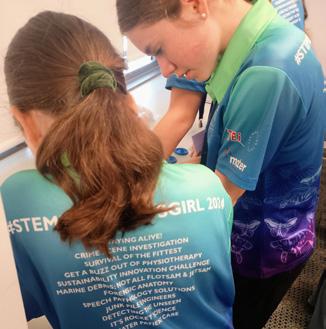
STEM Like a Pats Girl, Townsville.
International Outreach Connections
In April, CDM’s Senior Education and Outreach Manager Jackie Bondell travelled to Europe to represent the Centre at various meetings and site visits to further rebuild collaborations among groups doing outreach in particle physics.
The first stop was in Madrid at CIEMAT for the International Particle Physics Outreach Group (IPPOG) meeting. Jackie is the Australian representative to the organisation. IPPOG’s ‘principal aim is to maximise the impact of education and outreach efforts related to particle physics.’ At the meeting, Jackie presented two talks.
The first talk was an overview of the Centre’s major outreach initiatives, such as the National Science Week Road Trip, the Regional Schools Program, various node-based programs, and the new Muon Detectives education program.
The second talk focused specifically on the Regional Partner Schools Program, discussing the development of the educational activities, the collaboration with the UniMelb Faculty of Science, the expansion of the program to new states, and the goal to use the program to get more CDM scientists in front of students in regional and rural schools.
IPPOG members were very impressed with the efforts CDM invests in engaging regional students to help support the pipeline of students into STEM careers. Additionally, the meeting provided opportunities to collaborate with representatives from other programs, such as the US-based Global Cosmics (muon detection) program and the CERN-led Physics Masterclass initiative.
After this meeting, Jackie travelled to CERN to visit with CDM member Joni Pham and tour many of the experiments on site.
As part of the visit, Jackie was given a tour of the new Science Gateway Centre, the CERN education and outreach facility, and met with the education team leaders to discuss options for collaboration. A highlight of this visit was when Jackie joined teachers and students visiting from a high school in Greece for one of the lab tours.The students were very keen to learn more about CDM’s science programs!
Finally, Jackie visited outreach teams at Gran Sasso National Lab. After visiting the lab, Jackie and the team took time to share information on their respective outreach programs.
Both groups have strong missions to create opportunities to connect with students from backgrounds traditionally underserved in access to science and discussed ways to collaborate in engaging girls in science through school visits and arts programs.
These visits highlighted the common challenges in science outreach and shone a light on ways in which groups doing outreach globally can come together to have an impact that is greater than the sum of its parts.
Upcoming international projects in 2025 include the High altitude Engineering Research in Astrophysics (HERA) project and Astro Accel: Modern Physics in JPL Education. HERA will connect secondary students in Australia with the US to co-design a research project incorporating using muon detectors in conjunction with high-altitude balloons. The students have research mentors at nearby universities to support the project as well as Australian based Centre members.
Astro Accel is a collaborative project seeded and funded through the Astro Accel collaboration, for which Jackie is an associate member. The idea is to bring together lessons in contemporary topics such as Dark Matter and Gravitational Waves developed in Australia to a broader audience through the JPL/CalTech and LIGO US networks by refining the lessons to US standards and piloting and assessing them with select US schools.
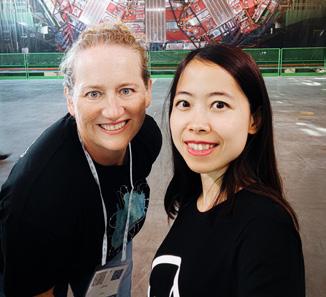
Jackie Bondell and Joni Pham at CERN.
Teacher Professional Development
In 2024, Jackie Bondell led a series of teacher professional development sessions through the Centre, aimed at supporting educators in bringing contemporary physics research into the classroom. These workshops focused on dark matter, muon detection, and scientific inquiry, equipping teachers with curriculum-aligned tools and pedagogical strategies to engage students with complex scientific concepts. Many sessions were delivered in partnership with regional and rural schools as part of the Dark Matter Partner Schools program and featured hands-on resources including dark matter art, mystery boxes, quark models, and gravity well activities. Workshops were held at both regional and metropolitan events in Victoria, in collaboration with the Science Teachers’ Association of Victoria, as well as at state-level conferences in New South Wales, South Australia, and Queensland.
Jackie also contributed to national and international teacher training efforts through her participation in CONASTA, the National Science Teachers’ Conference, and as an invited participant in the LIGO International Physics and Astronomy Educator Program, where she shared best practices for integrating frontier physics into secondary classrooms. Additionally, she led an ATLAS Masterclass for physics teachers in New South Wales on behalf of CDM and IPPOG—an initiative that will continue in 2025. These programs empower educators across Australia and internationally to foster curiosity and confidence in students through research-connected science learning.

Public lectures and physics in the pub events
In addition to public lectures and physics in the pub events that formed part events during National Science Week and as part of the National Quantum and Dark Matter Road Trip (detailed further below), Centre members also gave a number of public talks across the country.
• Nicole Bell – The Hidden Universe: Neutrinos and Dark Matter for the AIP in Hobart
• Ciaran O’Hare - Could understanding dark matter save the world? at Raising the Bar, Sydney
• Ben McAllister – Talks Dark Matter at Astronomyfest for IIT Kanpur, India (AstroVenture ‘24)
• Anthony Thomas - Colliding Black Holes, Cloudy Bags and Dark Matter at the Adelaide Club Science Luncheon
• Physics in the Pub – WA edition - Cosmic Heartbeats, Absent Aliens and Dark Matter Drugs: Physics in the Pub – Jeremy Bourhill represented CDM who also co-sponsored the event
Dark Matter Day
The Centre celebrated Dark Matter Day contributing to an online symposium in conjunction with CERN and ESO, with science teachers to support the introduction of dark matter education into the curriculum.
The Centre also posted videos of our members talking about their research. The posts illustrated the divere research happening across the Centre and showcased its researchers across different nodes.
Thank you to all Centre members who took part, and the videos can be viewed on the Centre website
ATLAS Masterclass for physics teachers in NSW.
Emily Filmer finds the humour in dark matter
Being part of Future Science Talks: Comedy Edition in the Adelaide Fringe this year was an excellent opportunity to make Dark Matter humorous!
The program consisted of 18 researchers from institutes around Adelaide, all giving a 10-minute presentation of their work to a general audience, through comedy. We were mentored by David Crisante, of the Sydney Comedy School, and Seaton Kay-Smith, freelance comedian, for three months in the lead up.
We had both group workshops and one-on-one sessions to help us understand how best to construct jokes, present with confidence, and work with an audience very different to what we’re used to - I’ve certainly never had to pause for laughter during a conference talk!
It was absolutely thrilling to present to a sold-out crowd and have them respond to my talk with such amusement!
This program was an invaluable experience. Not only was I able to develop my presentation skills and confidence for a new kind of audience, but I learnt how to condense my research into the most interesting and accessible key points. As it turns out, the Large Hadron Collider is a lot like throwing two piñatas together, and Dark Matter is a lot like the lollies that end up under the couch - maybe we’ll find them in a few years’ time, but they’re missing for now!

PhD student provides technical input to State Theatre company of South Australia
Matthew Fewell (UoA) had an outreach opportunity with the State Theatre company of South Australia to provide some technical advice on a play called ‘The Children’, presented at the Dunstan Playhouse in February 2024. We were responding to a request for scientific and technical input to a play on an accident at a nuclear power plant. I spent the morning with the production’s director, stage managers, dramaturge and members of the cast. They asked lots of questions, ranging from the physics basis for nuclear energy through engineering choices about the design and siting of nuclear power plants and plant management during a crisis to our own views on nuclear power. They also asked us about our personal journeys into science and from there into subatomic physics. I was impressed with the perspicacity of their questions and the depth that they were willing to go into the technical details. The cast members in particular were keen to explore the mindsets of nuclear engineers and power-plant operators. I suppose it’s all about playing their parts convincingly. It was a most enjoyable morning.
Stawell Easter Extravaganza
Centre members Kyle Leaver (UoA), Peter McNamara (ANU) and Anita Vecchies (UoM) travelled to regional Victoria to participate in the Stawell Easter Extravaganza.
The physicists and Chief Operating Officer operated a stall at the event, held over the weekend of the Stawell Gift, and spoke to members of the community and visitors to the region about physics, SUPL and SABRE South.
Science demonstrations were available to introduce children to physics concepts, and a muon detector was on hand to show why it is necessary to locate the SABRE South experiment 1km underground. Visitors to the stall were interested to hear updates on the underground lab located in Stawell Gold Mines, including the muon detectors that have been transported into the laboratory.
The event was an opportunity to share the excitment of our search for dark matter with the community, and to highlight the diversity and potential of science to young regional Victorians.

dark matter art
High School Creative Competition
In our annual high school competition, students used what they learnt from the web and visits to their schools by the Centre to create unique and original creative works representing their interpretation of dark matter. Competition winners received a certificate and gift voucher from the Centre.
Y 10-12 category winner –
Michael, Bunbury Catholic College
The Shape of Dark Matter
Imagine a sea where no oceans flow, A lattice of filaments stretching below— Veins made of shadow, unseen but tight, Weaving the galaxies, guiding their flight.
If dark matter glimmered beneath our stare, You’d see webs of twilight suspended in air— Like neural paths in a cosmic brain, Where clusters ignite, then vanish again.
At its heart, no solid or gas or flame, But particles dancing without a name. WIMPs waltz slowly through halos wide, While axions hum on a spectral tide.
Its form? A fog, not black nor bright, Neither consuming, nor birthing light. It ripples and bends as gravity calls, Shaping the universe in ghostly walls.
In every vast void, it drifts and it steeps, But gathers in halos where matter sleeps. Galaxies cradle in arms unseen, Drawn by this scaffold both taut and serene.
If you could touch it, it’d slip through your hand, Like dust too fine to feel or command— Each grain a relic from time’s first spark, Anchoring worlds in silence and dark.
So perhaps it’s the glue between then and now, A tether to futures we can’t yet allow— The gravity’s ink that scripts every star, Binding all things, wherever they are.
Inspiration: This poem draws inspiration from current dark matter hypotheses, such as WIMPs and axions, imagining it as an invisible web that structures the universe. It seeks to paint a vivid picture of dark matter not as a mystery, but as a tangible, ghostly presence shaping galaxies and linking past, present, and future.
Asia TOPA 2025 – Artist residency
In mid-2024, the Centre supported a visit and artist residency of Taiwanese performance artist Su Wenchi. Wenchi first visited the University of Melbourne in 2023, meeting with Centre members and returned to Australia with YiLab, an experimental group of new media and performance artists working on integrating new technology with the performing arts, and seeking to present new performing formats.
This artist residency coordinated by the Arts Centre in Melbourne included a visit to the Centre’s dark matter lab at the University of Melbourne, discussions with Centre researchers and a visit to the Stawell Underground Physics Laboratory. It will culminate in a VR experience titled Sensing Dark Matter, merging art and physics, inviting viewers to explore a speculative universe where dark matter and its gravitational effects become perceptible.
Sensing Dark Matter will be presented at the Science Gallery Melbourne as part of Asia TOPA (a triennial festival of Asia Pacific performance) in early 2025. The work has been commissioned by the Taipei Performing Arts Center, WestK Hong Kong, Asia TOPA, Arts Centre Melbourne and the Centre.
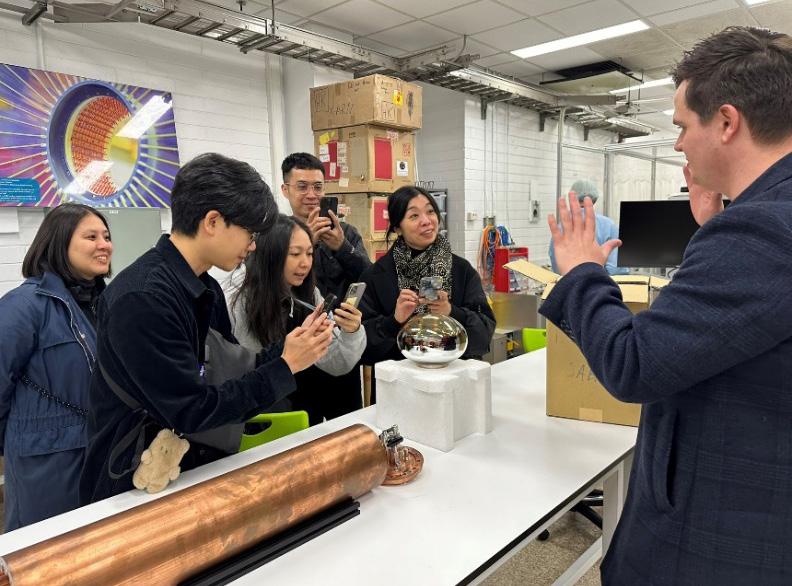
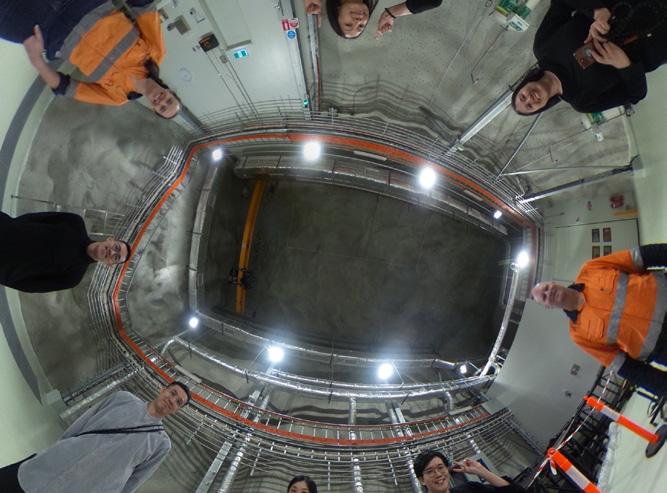
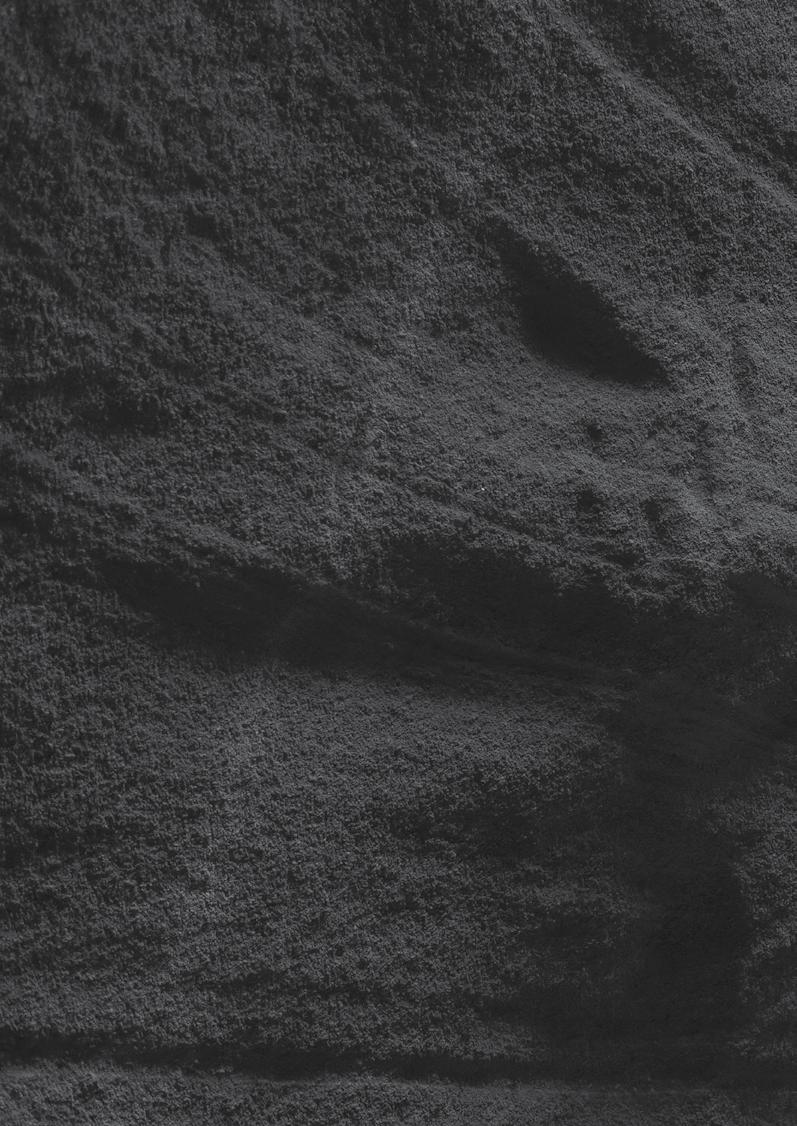
case study
Combining arts and science: Fostering a cross-disciplinary dialogue
I am a Naarm/Melbourne-based photographic artist and educator currently working on a project that traverses photography, science, sci-fi and consciousness, with a focus on the search for dark matter at its core.
After attending a public lecture on dark matter by Professor Elisabetta Barberio at the University of Melbourne in 2016, I became fascinated by this area of scientific research. My interest was initially sparked by the site of the Stawell Underground Physics Laboratory (SUPL), located deep within the subterranean depths of an active gold mine in Western Victoria, almost directly underneath my childhood home.
Fast forward to 2024, and I’ve had the unique opportunity to create work at both the ARC Centre of Excellence for Dark Matter Particle Physics at the University of Melbourne and SUPL. There, I’ve responded to the SABRE South experiment through various forms of photographic image-making, conceptual thinking, crossdisciplinary collaborations and ongoing dialogue with the scientific community.
In April and June of 2024, I made three visits to the ARC Centre of Excellence for Dark Matter Particle Physics research lab at the University of Melbourne, facilitated by Anita Vecchies, Jackie Bondell and Dr William Melbourne. Armed with various film cameras, custom-made backdrops, props and lighting equipment, I photographed various components and materials used in the construction of the SABRE South equipment, scientific instruments, and the surrounding laboratory environment.
I was later invited to participate in a trial program by the Facility and Laboratory Manager Kim Mintern-Lane at SUPL, with three artists connected to the area: Alasdair Niven, Khal Lawton and Mat Watson. During our two site visits underground, we worked alongside each other developing works in direct response to the lab environment.
From here, I will continue to work on the images captured in SUPL and the Dark Matter Centre, in my studio and darkroom, to further explore and experiment with film-based image-making techniques. This hands-on engagement has already sparked new creative and conceptual insights, and I now plan to reconnect with dark matter researchers and academics in the field to explore potential collaborations.
By combining artistic practice with scientific inquiry, I am working towards the publication of a photo book and exhibition that delves deeper into the mysteries of dark matter and consciousness, fostering a cross-disciplinary dialogue that bridges art and science in unexpected ways.

Photo credit: Ali McCann)
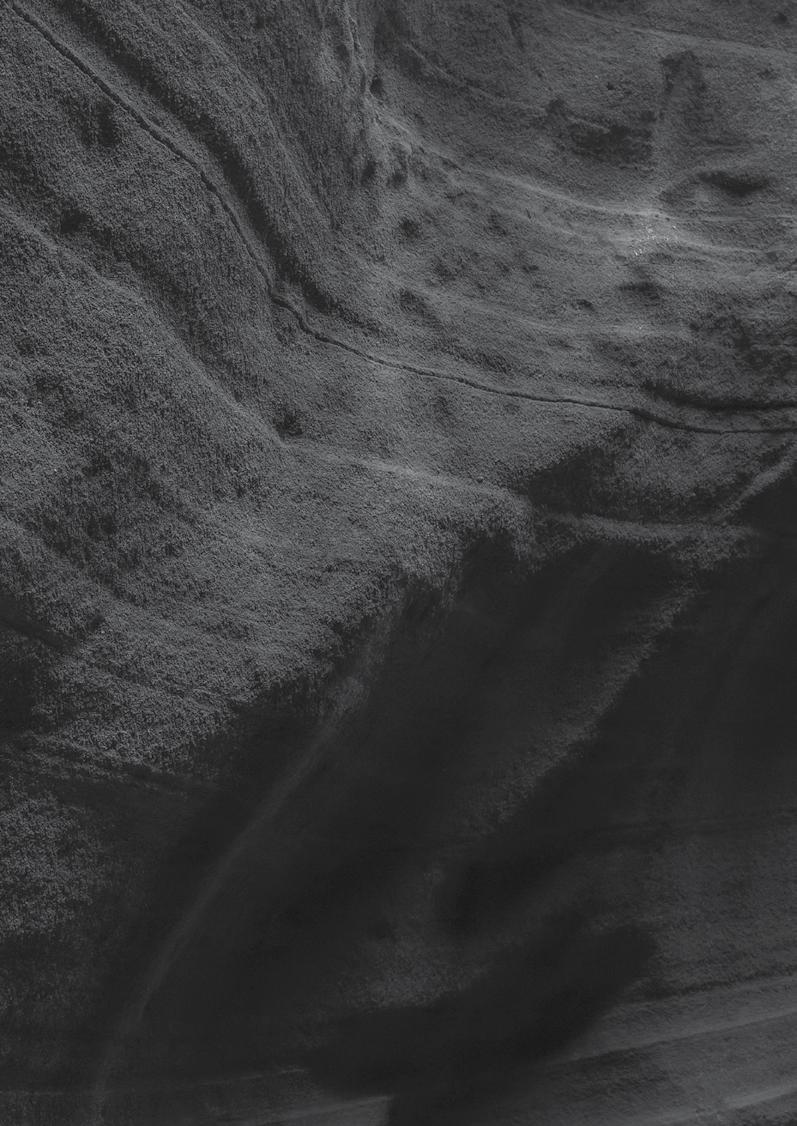

national science week
Centre members again participated in a range of activities to promote science to students and the wider community during and around National Science Week 2024. These included a Public Talk by Elisabetta Barberio hosted by Meri-Bek libraries and supported by the Inspiring Victoria program, Dark Matter in the Pub events and the annual National Quantum & Dark Matter Road Trip. Centre researchers at all of these events engaged with schools and the community to educate, inspire and to spread the word about dark matter.
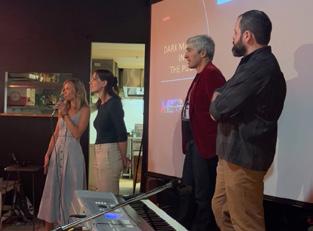
Dark Matter in the Pub is an entertaining science outreach event that aims to bring together scientists and the wider community to explore the fascinating and mysterious topic of dark matter. It was organised by the ANU and UoS nodes, and took place on two consecutive evenings during the National Science Week.
The first event held in a small pub in Canberra in 2022 was a great success. In 2024, the event was moved to bigger pubs hosting larger audiences, and in two Australian cities.
In a series of short, interactive, and entertaining presentations, Centre scientists Ellen Sirks, Theresa Fruth, Ciaran O’Hare, Laura Manenti, Ben McAllister and lead organiser Zuzana Slavkovska aimed to draw the nation’s attention towards dark matter research by presenting different aspects of their research into dark matter.
They were hosted by science communicator Phil Dooley, who performed live music with lyrics motivated by science. As a part of the event, a pub quiz was organised to engage the participants in the sciences. There were also several interactive demonstrations that directly engaged the audience with science.
The event received positive feedback, and we hope more Centre nodes will be involved in future events, bringing Dark Matter in the Pub in more Australian cities. A highlight video is available in the video section of the CDM website
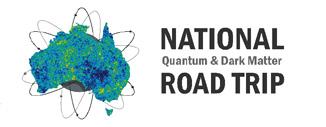
CDM and the ARC Centre of Excellence for Engineered Quantum Systems (EQUS) held another highly successful National Quantum & Dark Matter Road Trip in 2024, visiting the Northern Territory and Indigenous schools and communities for the first time.
A team of 13 EQUS and/or CDM members travelled 8,000km from Brisbane to Broome, visiting 18 schools and delivering 6 public events. An additional seven public events were held in metropolitan areas in WA, NSW, VIC, Tasmania, and online.
The CDM road trippers who joined different legs of the journey were: Ben McAllister (SUT), Emma Paterson (UWA), Haylea Purnell (UoA), Teehani Ralph (UWA) and Anita Vecchies (UoM). In addition, Will Campbell, Elisabetta Barberio, Laura Manenti, Theresa Fruth, Jade McKenzie and others participated in the pop-up events.
Some schools were large auditoriums full of moderate-to-keen high-school students, and other visits were a handful of children in remote communities.
One of the more remote schools was Bulla Camp School at Baines, more than 400km south of Darwin near the WA border and with just 11 primary school students. Principal Debbie Bailey was interviewed by Australian Associated Press and said that “We’re a long way from anything and we don’t have hotels and motels on our doorstep”. “Being willing to travel the distance and involve the students at the school, even if it’s only one student that it sparks interest in, it’s well worth it.”
Dark Matter in the Pub
Zuzuana, Ellen, Phil and Ciaran at the Dark Matter in the Pub event
National Quantum & Dark Matter Road Trip
The road trip received considerable media coverage, including five unique print and/or online media stories (syndicated across 90 titles), and 6 radio spots, helping to promote science to a wide audience across rural, regional and metropolitan areas of Australia as well as providing opportunities to our early career researchers.
Road trip stats
Thank you to all the road trippers, communities and schools who participated in the event for your enthusiasm and passion for sharing the excitement of science.

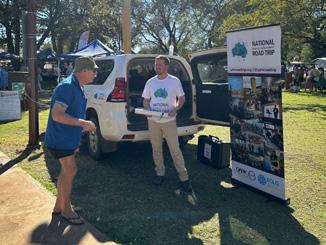

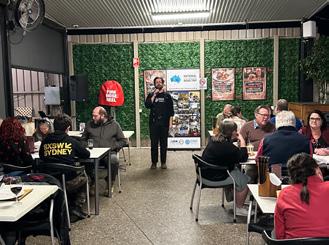

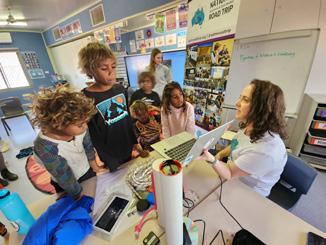
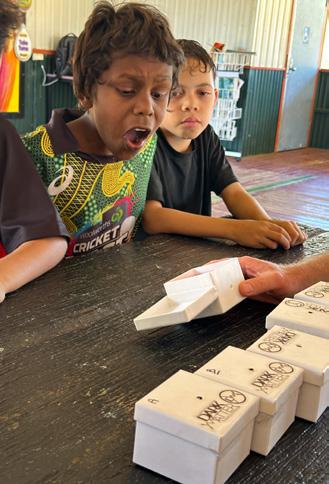




ECR report
Early-career researchers are the lifeblood of research, and the Centre is heavily invested in providing development and opportunities for ECRs. To facilitate this goal, the Centre elects representatives to form an ECR Committee each year.
In 2024 the ECR Committee consisted of Victoria Bahsu (Research Committee), Robert James (Research Committee) and Giorgio Busoni (Executive Committee).
The main deliverable of the ECR committee was a two-day workshop, held before the Centre Annual Workshop in Wollongong. The ECR committee set about planning this in June, with a focus on incorporating feedback given by the ECRs on the 2023 workshop. In addition, the committee has aimed to communicate information from both the Research Committee and the Executive Committee to the ECRs in an appropriate way.
The 2024 workshop provided a forum for ECRs to meet in person and share their research and ideas, and sought to provide opportunity for ECRs to enhance their scientific and professional skills. Specifically, we aimed to provide sessions relating to cultural diversity, communication skills, sustainability and future career paths, both in academia and industry. These topics were chosen after consulting with a number of ECRs across the Centre.
Eight ECRs from the Centre gave short talks on their research, providing valuable opportunities for them to hone their presentation skills and to forge new collaborations. These talks were very well received. In addition to this, we had a number of focus sessions across the two days led by external speakers.
Irene Bolognino (recently appointed academic staff member at The University of Adelaide) and Francesca Ungaro (former COEPP postdoc, now CEO of Atisfy) led a session discussing their experiences in their respective career tracks (continuing in academia and transitioning to industry, respectively). This session was highlighted as many people’s favourite in a post-workshop response survey. Additionally, Christopher Fluke of the University of Swinbourne delivered a session highlighting opportunities for collaboration between academia and industry.
External facilitators from Multicultural Australia - a leading organisation providing humanitarian settlement in Australia - led an extended interactive workshop on cultural diversity in the workplace. Throughout this session our ECRs had the opportunity to explore topics such as cultural identity and unconscious bias, in addition to sharing stories from our own experiences, highlighting the diverse range of cultural backgrounds we have in the Centre.
This session was very well received, with many participants appreciating the interactive nature of the session.
A number of Centre members (Jackie Bondell, Fleur Morrison, Theresa Fruth, Laura Manenti, Ciaran O’Hare, Robert James) collaborated to deliver a session exploring how information can be communicated in a range of different styles typically encountered during a scientific career, preparing ECRs for future grant applications, media interviews, conference presentations and more. Joshua Green, external visitor from the University of Oxford, delivered a session on sustainability in particle physics, highlighting his own efforts to improve sustainability with the LZ collaboration. This session was greatly enjoyed by ECRs, with many expressing a desire for the Centre to place a stronger emphasis on sustainability in future.
At the end of the workshop we held a closeout discussion session where we provided ECRs with an opportunity to share their hopes and ideas for future directions of the Centre. This information was passed to Centre leadership and is being actively incorporated into the Centre’s future plans. A particular desire was expressed for further opportunities for Centre ECRs to gather in-person throughout the year.
Two social events were held during the workshop, allowing ECRs to network and strengthen their bonds in a relaxed environment. Poolside drinks and canapés were enjoyed following the first day of the workshop, and following the second day ECRs got to participate in an escape room activity, with many sticking around afterwards for karaoke. ECRs greatly appreciated this opportunity to get to know each other better.
The vast majority of ECRs who responded to a post-workshop survey indicated that they were satisfied with the workshop. We also collected specific written feedback, which will be passed to the ECR committee tasked with planning the 2025 workshop to ensure continued improvement to the ECR experience.
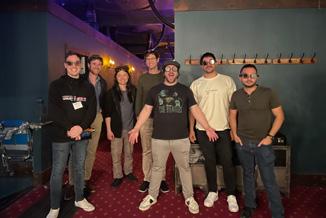


member profile

Robert Mostoghiu Paun
Collaboration is key for Swinburne University of Technology Postdoctoral Research Associate in Dark Matter Simulations Robert Mostoghiu Paun.
Dr Mostoghiu Paun says he is fascinated by the collaboration across various fields of physics required to identify the dark matter particle.
“Theorists develop new models, engineers design experiments, and astronomers provide observational data to establish constraints. This area of research is highly interdisciplinary, and I am excited to be part of such a collaborative effort.”
In 2024, Dr Mostoghiu Paun’s research focused on the properties of warm dark matter in cosmological simulations. ‘Warm dark matter’ refers to particle models with non-negligible thermal velocities and masses in the few keV range, allowing them to free-stream from primordial potential wells created during the inflationary era.
“This free-steaming results in a cutoff at scales where dark matter can gravitationally collapse, delaying structure formation compared to the (more popular) cold dark matter models,” he explains.
“To model dark matter in cosmological simulations, we use N-body methods, which are crucial for understanding structure formation and reproducing astronomical observations. However, these methods face challenges when applied to warm dark matter, leading to the formation of artificial gravitational halos influenced by the model’s cutoff scale, among other properties.”
Research has shown that these issues are inherent to N-body methods, and the only known solution involves abandoning them altogether and adopting different methods, which are significantly more complex and computationally intensive. As a result, most researchers refine their more traditional N-body code outputs to manage numerical challenges.
“My work so far has focused on improving N-body methods by enhancing initial conditions and optimising gravitational calculations. While we saw improved accuracy and reduced spurious structures in simplified scenarios, these gains did not fully translate to realistic cosmological simulations. Nonetheless, we were able to induce delays in structure formation by optimising gravitational interactions, akin to adjusting the cutoff scale of warm dark matter models. This result highlighted the need for caution when interpreting predictions involving varying warm dark matter masses.”
In 2025 Dr Mostoghiu Paun aims to publish his work in warm dark matter and collaborating across the Centre in projects including simulating the feedback effects from the evaporation of primordial black holes in cosmological simulations and studying their impact on galaxy formation.
mentoring committee report
The Centre’s mentoring committee, representing a cross section of people from the Centre, met twice across the year to plan events and coordinate with other committees within the Centre.
On the 20th of June, the Dark Matter Centre organised an online speed-networking event in collaboration with ASTRO 3D and the Astronomical Society of Australia. The session involved 26 participants who engaged in 174 matches, totalling 435 minutes of conversation. Over the course of an hour, each attendee had the opportunity to speak with an average of seven other academics. This dynamic lunchtime activity provided a fun and interactive way for Centre members to expand their professional networks, connecting with a diverse range of colleagues from various institutions and backgrounds across the country.
Mentorloop is an ongoing resource available to Centre members with mentors and mentees spanning 12 ARC Centres of Excellence. As part of the onboarding process for new Centre members, there is an overview of the mentoring support available including details about joining Mentorloop. The Centre has 41 members signed up to Mentorloop as a mentor, mentee or both and over 400 participants across all Centres of Excellence.
The Mentoring Committee ran a small group mentoring session at the Centre’s Annual Workshop in Wollongong. With 14 mentors and over 50 student and ECR mentees, the session was structured with a mentor per group and mentees split up into different groups depending on the stage of their studies/career. With some example questions provided, the mentees were free to ask whatever questions they wanted and thus covered a huge range of topics during the session. Of the post annual workshop survey respondents, a majority found the session useful and they liked being able to have a deeper discussion than the speed mentoring of the previous year. They also appreciated being with people they did not know and was less pressure than a one-on-one conversation. “The mentor’s suggestions are useful not only for physics, but also for life.”
Other mentoring and development opportunities arising from other activities such as the National Quantum & Dark Matter Road Trip and ECR committee members sitting on other Centre committees are mentioned in other sections of this report.
Finally, one of the actions arising from the recommendations of the Centre’s Mid-Term Review focused on identifying specific female researchers to support (including shadowing opportunities) and promotion within the Centre’s succession planning process. We also plan to run a leadership retreat for women and minorities to address unique career challenges and build a stronger network. This will also include mentoring and career support.


training and development
CDM is committed to the development of all of its members. In 2024, the Centre offered a range of formal and informal training activities, many with a strong focus on equity, diversity and inclusion. These included:
• Interwoven Imersion – Cultural Immersion workshop –Speaking in Colour (CDM annual workshop)
• Cultural Capability Training – Multicultural Australia (ECR workshop)
• CDM Computing Subgroup – mini-workshops
→ Kick-off workshop (over three days)
→ Monte Carlo methods
→ Machine learning: Deep Learning Architectures
→ Introduction to GEANT4
→ Developing detector simlulations
• Formal induction training at the Stawell Gold Mine to work in SUPL
• Career perspectives : academia (ECR workshop)
• Career perspectives: industry (ECR workshop)
• Communications activity: pitching science at different levels (ECR workshop)
• Lessons learnt from studying AI – Astronomy and Industry (ECR workshop)
• Coaching on media skills and messaging to students and ECRs who were interviewed on radio for different opportunities such as Einstein-a-Go-Go on 3RRR and during the National Quantum & Dark Matter Road Trip
CDM Vacation Studentships
Over the 2023/24 summer vacation period, CDM supported six vacation studentships across five nodes of the Centre. Students underwent a competitive application process and were selected to undertake a 4-8 week dark matter research project.
Subrahmanya Saicharan (Sai) Pemmaraju completed an 8 week studentship at ANU under the supervision of Dr Lindsey Bignell. He reflects on his studentship below. Sai commenced his PhD at UoM later in the year.
I had always had a keen interest in dark matter and was somewhat familiar with some of the projects that were being undertaken by the Centre on this front prior to undertaking my vacation studentship. My project was focused on initiating the development of track reconstruction algorithms for the directional dark matter detection experiment CYGNUS-Oz. In addition to Dr. Bignell, I was closely mentored by PhD students who were involved with the experiment, most notably Lachlan McKie, Victoria Bashu, and Ferdos Dastgiri. I began the project by refactoring some of the pre-existing implementations of the detector emulator code, which was responsible for simulating synthetic detector events as they drifted and approached a two-dimensional readout plane. I had attempted to refactor parts of this emulator code to enhance computational speed and to minimise execution time. I then proceeded to generate straight line electron tracks using this emulator code and then attempted to reconstruct the trajectories of these using Principal Component Analysis (PCA) techniques and other mathematical analyses. The final weeks of my project were devoted to optimising the speed and the execution time of the algorithm that I had developed to achieve this. The next step in this project would have been to test the algorithm I had developed on some Geant4 simulations to validate their performance, but I was unable to complete this due to time constraints. Nevertheless, the studentship was a phenomenal learning experience that furthered my interest in the area of cold dark matter and the various experiments that have been designed in order to decipher its nature, and I am very grateful to Dr. Bignell and the CYGNUSOz group at the ANU for being supportive and encouraging of me during the time I spent with them. In addition to the above, I am grateful to Petra Rickman, who was responsible for taking care of administrative matters pertaining to the studentship and ensured that I was well supported throughout the project.
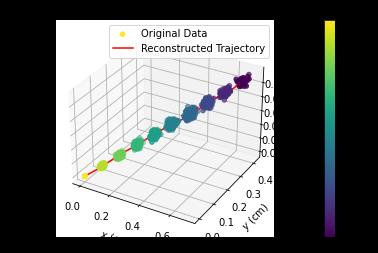

Above: Synthetic Data Generated using refactored code
Paige Taylor completed a studentship at Swinburne University under Dr. Ben McAllister, focusing on the design and optimisation of a resonant cavity for a novel re-entrant axion haloscope as a part of the ORGAN-Low project. The project aimed to detect lowmass axions up to 2.4 μeV, corresponding to a 500 MHz resonant frequency. Since the photon signal produced by a potential axion conversion would be extremely weak, the haloscope must be designed in a manner to maximise detection ability. This is achieved by optimising the scan rate, which is heavily dependent on the cavity’s geometry. The ORGAN-Low resonant cavity features a telescopic rod design that manipulates the cavity volume, allowing the resonant frequency to be tuned over a broad search range.
Paige’s work focused on scaling down the prototype’s CAD model and modifying its geometry to improve manufacturability and ease of assembly while also maintaining performance. These refinements helped reduce fabrication costs and ensured the project could progress to the development and testing stage.
Paige reflected: “I am incredibly glad I received this opportunity, as it not only strengthened my understanding of experimental axion dark matter detection but also allowed me to continue this work into my engineering honours at Swinburne. There, I focused on the testing and development of a second prototype, refining the design further to improve performance and feasibility. I am fortunate to have worked in a centre that not only significantly advances dark matter research but also values mentorship and collaboration, creating an encouraging space for students to contribute meaningfully.”
member profile

Graeme Flower
University of Western Australia postdoctoral researcher Grame Flower got his first taste of dark matter research during a vacation project.
Dr Flower was considering whether to pursue research in engineering or physics when he had the opportunity to design parts for a dark matter detector.
He chose physics for his honours year, which then led to a PhD and his role as a postdoctoral researcher.
Dr Flower is part of UWA’s Quantum and Dark Matter lab, where he enjoys the problem-solving and variety of his job.
“The search for dark matter is a huge and fascinating problem. So, being part of what modern physics is doing is really cool.

“I really enjoy doing experimental physics and working with cool equipment like the cryogenic fridges we have downstairs,” he says.
“Experimental physics is also interesting because you can do many things in one day; sometimes you’ll design things and work with CAD on engineering tasks. Other times you’ll be working on electronics or theory, or sometimes computer science and data processing.”
Dr Flower’s introduction to the Quantum and Dark Matter Lab at UWA during his vacationship led to an honours in physics, which he enjoyed.
Following his PhD, he now works as a postdoctoral researcher in the lab, trying to help solve the mystery of dark matter.
In particular, Dr Flower works on axion dark matter detection through the ORGAN experiment, which searches for axions via their conversion to microwaves in a strong magnetic field. He primarily works on the readout side of the experiment, implementing quantum limited Josephson parametric amplifiers into the readout chain where the ORGAN team completed a near quantum limited search for axions near 6GHz.
Going forward ORGAN plans to implement quantum limited amplification for experiments above 15GHz with kinetic inductance parametric amplifiers and investigating the possibility of beating the standard quantum limit with squeezing and single photon counting.
Dr Flower enjoys the opportunity to learn from his peers in the lab and across the Centre.
“It’s great to hang out with the other students and find out what they’re doing. With experiments in all different areas, we have people with many varied skills and interests. Some work with mechanics and the search for high-frequency gravitational waves; others work on high-precision clocks and oscillators, so it’s very diverse.”
events
Centre events offers members from across all nodes with the opportunity to collaborate to share information and skills that will assist students and researchers in their academic and industry careers. In 2024, there were many in person events and travel.
The Centre’s ECR and Annual Workshops were the main opportunity for the whole Centre and some international Centre members and guests to come together in person. Both are profiled in more detail in other sections.
There were also a nubmer of workshops, meetings and conferences organised by Centre members which are profiled below.
CDM also highlights days of significance on the scientific calendar in order to promote an understanding of dark matter and physics careers in the wider community, and to celebrate the work and achievements of members. These include National Science Week and Dark Matter Day, profiled in other sections of this report.
ISAC meeting
In early September, two members of our ISAC visited Melbourne for the Centre’s ISAC meeting. The Chair Dr Nigel Smith (TRIUMF) and Professor Tony Gherghetta (University of Minnesota) came in person to meet with members of the Centre’s Research and Executive Committees and visit SUPL. The meeting consisted of a half day of presentations and updates from the Centre’s research themes as well as Q&A. The committee then provided feedback to the Centre’s leadership (Exectutive, Research and ECR Committees).
Nigel reported that the ISAC was pleased to see the output from the mid-term review. They were very impressed with the progress across the Centre’s research themes. There was a strong emphasis on continuing to focus efforts on the delivery of SABRE. Aligned with the ARC’s report from the Centre’s mid-term review, there was also a focus on the sustainability and long-term viability of SUPL and the future of the community in general.
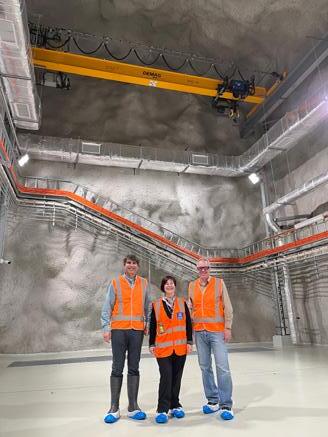
(L-R) Tony Gherghetta, Elisabetta Barberio, Nigel Smith
XLZD-Oz Workshop
Organisation of the XLZD-Oz workshop was led by Centre members Robert James (UoM) and Theresa Fruth (UoS) and supported by Ciaran O’Hare (Uos), Peter Cox (UoM) and Jayden Newstead (UoM). This workshop was entirely organised and run by ECRs and funded from a CDM Special Initiatives grant.
The XLZD-Oz 2024 workshop was successfully held at the University of Sydney over three days in November. Several Australian institutes had attendees in person (UoM, UoS, ANU, UoA, James Cook), and there was in person and remote participation from a number of international attendees (UK, US, Italy, China, France). The workshop featured talks covering topics such as the LZ and XENONnT systems and analysis pipelines; XZLD design considerations; XLZD siting and background considerations; the neutrino fog and XLZD neutrino detection channels; theory prospects for XLZD; and electron transport modelling. Useful discussions were also had between attendees, seeding ideas for future Australia-led XLZD projects.
SABRE South collaboration meeting
Centre members working on SABRE South met in Wollongong before the Centre’s Annual Workshop for a two-day collaboration meeting. Participants from five of the Centre’s nodes heard talks from academics, postdoctoral researchers and students updating them on the progress of each of the different work packages and systems of SABRE South. There were also talks from the project manager, SUPL facility and lab manager and CDM PI Aldo Ianni who attended online. It was a productive couple of days with opportunities for discussion and a social dinner.
There were many Centre researchers who helped organise, give talks, keynotes and plenary presentations at international conferences and workshops throughout the year. Some highlights are:
AIP Congress – Melbourne
Centre members were among organisers, chairs, speakers, poster presenters and delegates at the AIP 2024 Congress which took place at the Melbourne Convention and Exhibition Centre in December. CDM was also one of the main sponsors of the event with an exhibition booth that received lots of visits.
The congress program covered a wide range of physics topics as well as physics education. Over 20 Centre members (from students to senior academics) gave talks including Elisabetta Barberio and Mike Tobar who were plenary speakers and invited speakers Paul Jackson, Cedric Simenel, Andrew Stuchbery, Geoff Taylor and Phillip Urquijo.
Mike Tobar was presented with the Harrie Massey Medal during the event and was also elected as an AIP Fellow in 2024.

XLZD-Oz workshop attendees.
QCHSC-2024
The XVIth Quark Confinement and the Hadron Spectrum Conference, organised by the University of Adelaide and supported by sponsorship from the Centre, was held in Cairns over a week in August and was attended by many Centre staff and students. Chief Investigators Anthony Thomas, Martin White, Anthony Williams, Nicole Bell and Cedric Simenel were also part of the organising committees.
With over 260 Australian and international participants, this conferences has become an important forum for scientists working on strong interactions, stimulating exchanges among theorists and experimentalists as well as across related fields.
Jackie Bondell was a plenary speaker talking about the Centre’s Regional School Partnerships program as well as co-host of a Particle Physics Masterclass. Anthony Thomas was a panelist of a round table on the topic of QCD and New Physics in Extreme Astrophysical Environments – in Neutron Stars and their Mergers. Eleven other Centre members gave talks during the conference and a number of students presented posters.
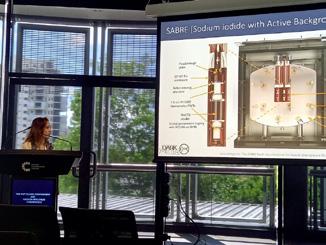
Centre members present at International Conference on Research Infrastructures
Elisabetta Barberio and Alan Duffy both presented at the International Conference on Research Infrastructures held in Brisbane. There were over 400 attendees from 50 nations with over 500 joining online. Also in attendance was Nigel Smith, chair of the CDM ISAC. It was a professional forum for the global research infrastructure community to discuss pressing topics of interest, trends and challenges facing research infrastructure around the world. Both Elisabetta and Alan spoke about the CELLAR facility and SABRE South experiment and their location in the Stawell Underground Physics Laboratory. Elisabetta participate on a panel moderated by Dr Izabela Rottman from the Max Planck Institute for Radio Astronomy and including Dr Zhiming Cai, Director of the Scientific Satellite Institute at the Chinese Academy of Sciences, Fabio Biancat Marchet Deputy Programme Manager at the European Extremely Large Telescope and Professor Phillip Diamond, Director General of the SKAO Observatory.
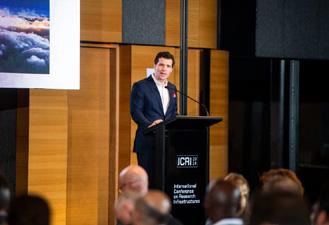
Irene Bologinino (UoA) presenting on SABRE South at the QCHSC-2024.
Photo credit: Joseph Byford
Visit from Elena Aprile
The Centre was pleased to host a visit by Columbia University Centennial Professor of Physics, Elena Aprile, in February. Professor Aprile pioneered the XENON project and has been its spokesperson since its inception in 2004. Under her leadership, the XENON Collaboration has developed four cutting-edge generations of liquid xenon experiments, all at the forefront of dark matter direct detection searches. Prof Aprile’s accolades include the Roma Prize (2023), the Julius Wess Prize (2022), the Enrico Fermi Prize (2021) and the Berkeley-Lancelot Prize (2019). During her visit to the Centre, Professor Aprile had the opportunity to meet many Centre members in Sydney and Melbourne and presented a colloquium and public talk at The University of Melbourne. Later in the year, Elena joined the Centre’s ISAC.
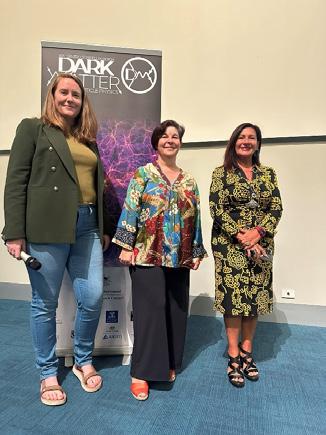
15th International Workshop on the Identification of Dark Matter 2024
The International Workshop on the Identification of Dark Matter is a conference that aims to draw a complete picture of the status of dark matter searches from the theoretical to the experimental point of view. It was held in L’Aquila, Italy in July and CIs Elisabetta Barberio and Greg Lane, AI Ciaran O’Hare and PIs Gianfranco Bertone, Tracy Slatyer and Neil Spooner were on the conference International Advisory Committee. Centre members spoke at the conference including Elisabetta Barberio, Renee Key and Ciaran O’Hare as well as PI Aldo Ianni and AI Laura Baudis and Centre students presented posters.
A selection of other keynote/plenary talks from Centre members in 2024 included:
• International Workshop on Standard Model and Beyond
→ Nicole Bell, plenary titled, Capture, Thermalization and Annihilation of Dark Matter in Neutron Stars
→ Peter Cox, plenary titled, Light Dark Matter Detection
→ Laura Manenti, plenary titled, Blazar-boosted dark matter: a cosmic accelerator for Sub-GeV dark matter particle detection
→ Michael Tobar, plenary titled, Precision Low-Energy Precision Experiments to Search for signs of Quantum Gravity and Dark Matter Particles
• The international conference on Neutron star Equation of State and Gravitational Waves (NEOSGrav2024) – Anthony Thomas, keynote titled, From Quarks to Nuclei and Neutron Stars
• International Symposium on Cosmology and Particle Astrophysics (CosPA 2024) – Raymond Volkas, plenary titled, Explaining the cosmological dark matter coincidence in asymmetric dark QCD
• 42nd International Conference on High Energy Physics (ICHEP 2024) – Raymond Volkas, plenary titled, Neutrino theory: open questions and future opportunities
Elene Aprile (far right) with Elisabetta Barberio and moderator Suzie Sheehy (far left) at Elena’s public lecture in Melbourne.
annual workshop

110 Centre members, partners from across Australia and internationally and guests attended the CDM’s third in-person Annual Workshop over three days in Wollongong, NSW in late November.
The EDI committee sought feedback from Centre members to help shape the workshop (as detailed earlier) and the program organising committee also incorporated feedback from previous years and suggestions collected from node visits and actions from the Mid-Term Review to refine the program. The event provided an opportunity to share ideas, information and inspiration, with talks covering the current landscape in dark matter research and what comes next in this dynamic field of research.
Other highlights were:
• a moving smoking ceremony to open the event (pictured above) by Layne Brown
• an engaging Welcome to Country given by Uncle Richard Davis
• a panel discussion on the future of dark matter research, with an emphasis on astro and quantum technology (featuring Elisabetta Barberio, Chamkaur Ghag, Laura Manenti and Darren Croton)
• 24 research talks and keynotes from Centre members featuring research across the Centre and visitors including Sue Barrell (SUPL Ltd), Nicolas Beaupère (IMT Atlantique), James Dent (Sam Houston State University), Luca Scotto Lavina (CNRS), Anatoly Rozenfeld (University of Wollongong), Aaron Vincent (Queen’s University)
• a poster session with 22 posters presented by Centre students and ECRs
• a small group mentoring session with themes relating to different cohorts of students and ECRs
• The workshop dinner where Centre awards were presented by Advisory Board member and SUPL Ltd Chair, Sue Barrell (details below)
• a talent show featuring cultural song and dance, music, comedy, a cake shaped like the SABRE South vessel and an incredible blindfolded chess game (detailed earlier in the EDI update)
• ECR committee update and highlights from ECRs in 2024
• Education and Outreach talks from Jackie Bondell and AI Victoria Millar
• Interwoven, a cultural weaving session run by Speaking in Colour
Thank you to Centre members and guests who helped make the workshop such a success.
Responses collected in a post workshop survey were extremely positive, satisfaction rates on the venue (incl accommodation), overall workshop and program structure were all over 90%.
When asked “What did you like about the annual workshop?” A highlight was the positive feedback on our efforts around diversity and inclusion:
“Meeting my colleagues in person and talking about work-related as well as non work-related topics. I enjoyed the openness, the emphasis on inclusion, safe space and special needs.”
“Simply great. It has been a great experience, and it also gave me plenty of ideas to organize similar activities in my country. In particular, the high care on making it so inclusive was amazing.”
“I always admire how the annual workshop appreciates diversity, adds to our knowledge of different cultures through various efforts.”
“I found it a very inclusive and open meeting, well-run and comprehensive in its coverage of the science of the centre.”
CDM Collaboration and Centre Values Award recipient

Jade is the Centre’s Database Administrator at the University of Melbourne who works across the professional-academic barrier on the Centre database and website as well as the SABRE South project. She works actively with students, postdocs and academics in the SABRE collaboration, often on projects that don’t receive much recognition such as planing the SABRE South collaboration meeting. She welcomes and includes new students and staff and goes above and beyond what is expected in her role. She is also the deputy chair of the Equity, Diversity and Inclusion Committee and drives and supports initiatives within the Centre to promote collboration and a sense of inclusion. This includes social scripts at the annual workshop, EDI suggestion forms and she collated feedback from the 2023 annual workshop neurodiversity session and presented ideas for building an inclusive workplace.
CDM Outreach and Impact Award recipient

Zuzana is a postdoctoral researcher at the Australian National University working on cosmogenic radiobackgrounds of the SABRE experiment. She is always willing to drive and support outreach and communication initiatives. She was the lead in the expansion of the Regional Schools program to NSW, leading classroom activities and was the media representative for the event. She is part of the Muon Detectives outreach project bringing muon detectors into our regional partner schools. Zuzana has also been part of the last two Canberra Physics in the Pub events during National Science Week and secured funding for the event in 2024. She volunteers and accepts opportunities to represent the Centre and its research in the best light, through numerous media interviews and is a role model for girls in science.
Jade McKenzie (UoM)
Zuzana Slavkovska (ANU)
CDM Outreach and Impact Award recipient
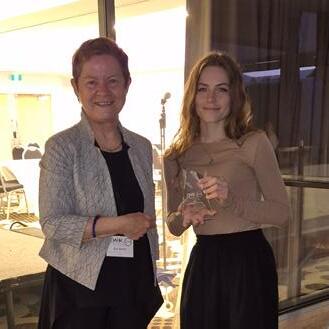
Emma Paterson (UWA)
Emma is a PhD student at the University of Western Australia working on in dark matter direct detection.
She was recognised for her engagement in promoting quantum physics and dark matter research to diverse audiences. She participated in the 2024 National Quantum & Dark Matter Road Trip from Alice Springs to Broome, directly engaging with remote students and appeared on the Kimberley Pilbara Saturday Breakfast radio show and Clear As Quantum Podcast to talk about the road trip. Emma is also actively engaging in research impact, working towards creating a startup called “Twisted,” which focuses on chiral separation technology, demonstrates their ability to translate research into potential real-world applications. She won the People’s Choice Award at StartUpWA’s Alchemy event pitch night, featured on Innovation Nation TV and presented the Twisted project at Quantum West, reaching researchers, government officials, industry professionals, and the general public.
Best Poster Award (Panel vote)
Kyle Leaver (UoA)
For poster titled “Neutron monitoring system for Stawell Underground Physics Laboratory”
Best Group Poster Award (Panel vote)
Victoria Bashu and team (ANU)
For poster titled “CYGNUS-Oz: Into the fog with nuclear recoil imaging: Gas impurities”
Best Poster Award (Centre member vote) –joint winners
Joshua Green (University of Oxford)
For poster titled “Optimisation of fast likelihood functions for dark matter and rare event searches”
Iman Shukat Ali (UoM)
For poster titled “Cosmic Ray Boosted Dark Matter Confronted by Constraints on New Light Mediators”
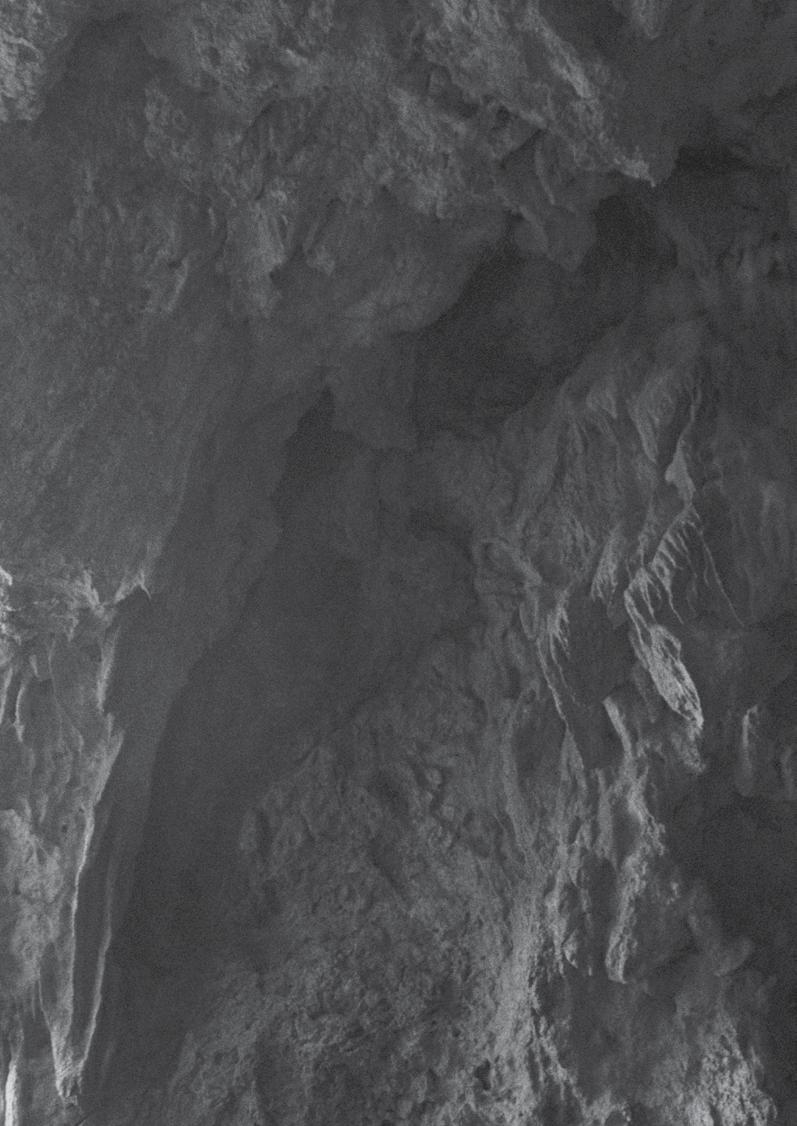
awards and honours
ARC Centre of Excellence for Dark Matter Particle Physics
Faculty of Science 2024 Dean’s Award for Excellence for Excellence in Team Research
awarded by The University of Melbourne in recognition of exceptional performance and a strong commitment to research in the Faculty of Science
Amrita Banerjee (SUT)
3rd place in Best Student Sparkler at ASA24
Awarded by the Astronomical Society of Australia

Elisabetta Barberio (UoM)
Italian Republic Order of Merit
(Cavaliere dell’Ordine al Merito della Repubblica Italiana)
awarded by the President of Italy and presented by the Italian consul-general Dr Hanna Pappalardo at a ceremony at the Consulate General of Italy in Melbourne. The award is Italy’s highest-ranking honour and recognises Elisabetta’s international contribution to physics research. Elisabetta grew up in Southern Italy and said “I’m delighted and deeply honoured to have received this recognition from Italy for my research in particle physics. Italy is a superpower in this globally significant field,”
Nicole Bell (UoM)
New member of the ARC College of Experts appointed by the Australian Research Council
Jeremy Bourhill (UWA)
School of Physics, Mathematics & Computing Award in Research Impact and Innovation awarded by the University of Western Australia
Emily Filmer (UoA)
Dean’s Commendation for Doctoral Research Excellence
Awarded by the University of Adelaide for exemplary dedication, innovation, and scholarly excellence in their respective fields of study
Maaz Hayat (UoM)
Laby PhD Travelling Scholarships awarded by The University of Melbourne
Paul Jackson (UoA)
Faculty Award for Excellence in HDR Supervisory Practice awarded by The University of Adelaide
Robert James (UoM)
UCL best postgraduate research in high energy physics awarded for the best PhD thesis of the year (2023-2024 submission) in high energy physics at UCL awarded by University College London
Robert James (UoM)
LZ Citizenship Award awarded by the LZ collaboration for going above and beyond to improve the LZ experience for colleagues, and for being an excellent citizen of the collaboration
Laura Manenti (UoS)
Italian Physics Society Award for Education awarded by the Italian Physical Society for her book on particle physics for children titled The Littlest Girl Goes Inside an Atom
Ben McAllister (SUT)
ARC Discovery Early Career Researcher Award (DECRA) awarded by the Australian Research Council
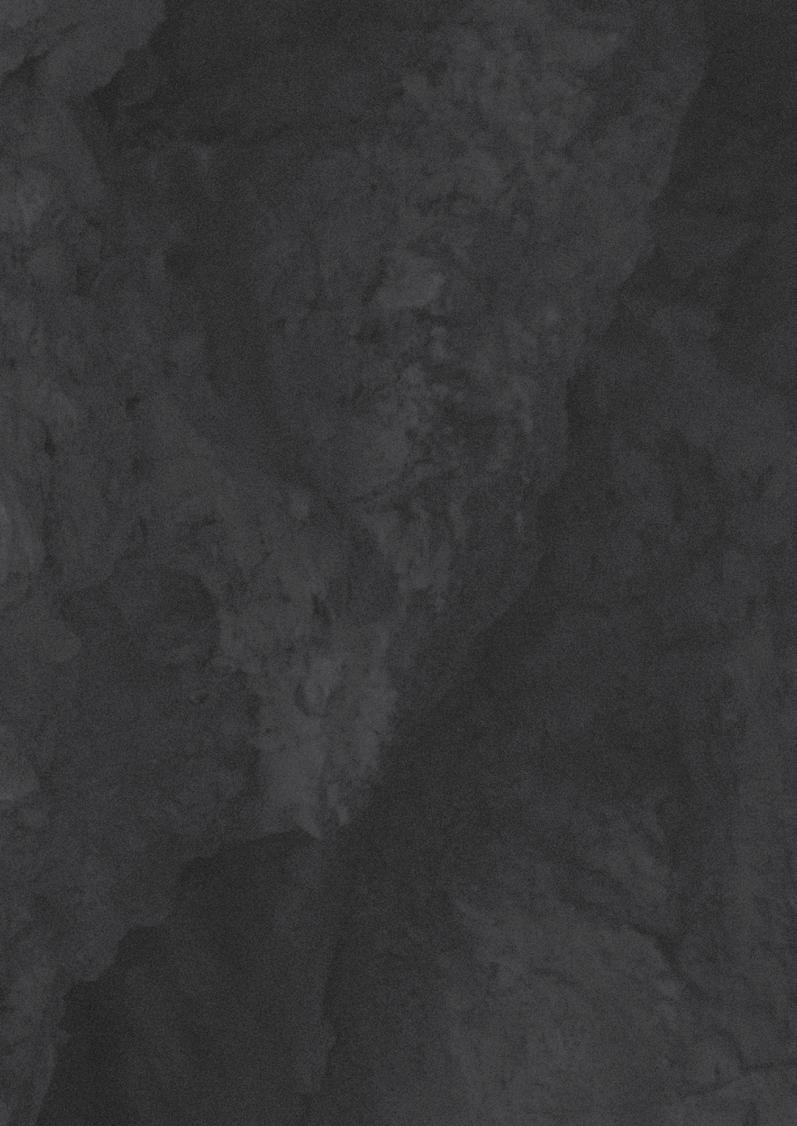
Lachlan Milligan (UoM)
Laby PhD Travelling Scholarships awarded by The University of Melbourne
Emma Paterson (UWA)
People’s Choice Winner at StartUpWA’s Night of Innovation: Alchemy awarded by StartUpWA
Emma Paterson (UWA)
Outstanding Youth Role Model awarded by Women in Technology WA (WiTWA)
Iman Shaukat Ali (UoM)
Jean Laby Women in Physics Travel Award awarded by the University of Melbourne
Cedric Simenel (ANU)
Dean’s Commendation for Excellence in Education 2024: Excellence in Supervision awarded by the Australian National University
Alexei Sopov (UoM)
Laby PhD Travelling Scholarships awarded by The University of Melbourne
Owen Stanley (UoM)
Laby PhD Travelling Scholarships awarded by The University of Melbourne
Geoff Taylor (UoM)
appointed Chair of the Scientific Advisory Committee at the Japanese High Energy Accelerator Research Organisation, KEK
The Scientific Advisory Committee at KEK focuses on the progress and outlook of the overall research program of KEK, including high energy physics, nuclear physics, material sciences and life sciences
Mike Tobar (UWA)
Harrie Massey Medal and Prize awarded by The Australian Institute of Physics
Mike Tobar (UWA)
Appointed to co-lead the Quantum Sensing Roadmap sub-committee
US Department of Energy (DOI) Office of Science. Mike was the only non-US participant, where he co-led the Quantum Sensing section that will shape the DOE’s future of quantum sensing in the USA.
Mike Tobar (UWA)
2024 Vice-Chancellor’s Award for Research Mentorship awarded by The University of Western Australia
Anthony Williams (UoA)
2024 Distinguished Alumni Award awarded by Flinders University for his distinguished research leadership in subatomic physics
Linkage Infrastructure, Equipment and Facilities Grants
Paul Jackson (UoA)
Enabling the future of the Australian collider physics program awarded by the Australian Research Council
Elisabetta Barberio (UoM)
Construction of the SABRE South full-scale dark matter detector awarded by the Australian Research Council
Lindsey Bignell (ANU)
A recoil imaging detector module for directional particle physics awarded by the Australian Research Council
student completions
Honours:
Jake Felix (UoA)
Zac Greenfield (UoS)
Michael Hatzon (UWA)
Kael Kemp (UoA)
Finn Edward Pelling (UoA)
Riya Raizada (UoS)
Amelie Read (UoS)
Paige Taylor (SUT)
Emily Waterman (UWA)
Rickson Wielian (ANU)
Masters:
Vshal Ayyagari (UoM)
Sen Sam Chhun (UoM)
Aphisit Nanphakdi (UoM)
Teehani Ralph (UWA)
Lucia Stockdale (UoM)
Michael Verde (UoM)
Ho Man Yim (UoM)
MPhil:
Nathanael Botten (UoA)
Joshua Gill (UoA)
PhD:
William Campbell (UWA)
Mitchell Dixon (SUT)
Emily Filmer (UoA)
Charles Grant (UoA)
Frederick Hiskens (UoM)
Liam Hockley (UoA)
Nicholas Leerdam (UoA)
Aaron Quiskamp (UWA)
Alex Ritter (UoM)
Tristan Ruggeri (UoA)
Michael Virgato (UoM)
Scott Williams (UoM)
Yiyi Zhong (ANU)
key performance indicators
9.
R. Abdel Khaleq, G. Busoni, C. Simenel, and A. E. Stuchbery, Impact of shell model interactions on nuclear responses to WIMP elastic scattering, Physical Review D, 109, 075036 https://doi.org/10.1103/physrevd.109.075036
G. Arcadi, G. Busoni, D. Cabo-Almeida, and N. Krishnan, Is there a scalar or pseudoscalar at 95 GeV?, Physical Review D, 110, 115028 (2024) https://doi.org/10.1103/physrevd.110.115028
C. G. Baker, W. P. Bowen, P. Cox, M. J. Dolan, M. Goryachev, and G. Harris, Optomechanical dark matter instrument for direct detection, Physical Review D, 110, 043005 (2024) https://doi.org/10.1103/physrevd.110.043005
N.F. Bell, G. Busoni, S. Robles and M. Virgato, Heavy dark matter in white dwarfs: multiple-scattering capture and thermalization, Journal of Cosmology and Astroparticle Physics, 07, 051 (2024) https://doi.org/10.1088/1475-7516/2024/07/051
N.F. Bell, G. Busoni, S. Robles and M. Virgato, Thermalization and annihilation of dark matter in neutron stars, Journal of Cosmology and Astroparticle Physics, 04, 006 (2024) https://doi.org/10.1088/1475-7516/2024/04/006
N. F. Bell, P. Cox, M. J. Dolan, J. L. Newstead, and A. C. Ritter, Exploring light dark matter with the Migdal effect in hydrogendoped liquid xenon, Physical Review D, 109, L091902 (2024) https://doi.org/10.1103/physrevd.109.l091902
N.F. Bell, J.L. Newstead, and I.S. Ali, Cosmic-ray boosted dark matter confronted by constraints on new light mediators, Physical Review D, 109, 063034 (2024) https://doi.org/10.1103/PhysRevD.109.063034
J. Bourhill, G. Cochet, J. Haumant, V. Vlaminck, A. Manchec, M.E. Tobar, and V. Castel, Metalized 3-D Printed Plastic Resonator Demonstrating Superconductivity Below 4 K, IEEE Transactions on Components, Packaging and Manufacturing Technology, Volume 14, Issue 11 (2024) https://doi.org/10.1109/tcpmt.2024.3487264
G. Bourcin, A. Gardin, J. Bourhill, V. Vlaminck, and V. Castel, Level attraction in a quasiclosed cavity: Antiresonance in magnonic devices, Physical Review Applied, 22, 064036 (2024) https://doi.org/10.1103/PhysRevApplied.22.064036
B. Carew, A. R. Caddell, T. N. Maity, and C. A. J. O’Hare, Neutrino fog for dark matter-electron scattering experiments, Physical Review D, 109, 083016 (2024) https://doi.org/10.1103/physrevd.109.083016
E. Carragher, K. Goh, W. Su, M. White, and A. G. Williams, Extending global fits of 4D Composite Higgs Models with partially composite leptons, Journal of High Energy Physics, 08, 185 (2024) https://doi.org/10.1007/jhep08(2024)185
S. Chakrabarty, J. R. Gleason, Y. Han, A. T. Hipp, M. Solano, P. Sikivie, N. S. Sullivan, D. B. Tanner, M. Goryachev, E. Hartman, B. T. McAllister, A. Quiskamp, C. Thomson, M. E. Tobar, M. H. Awida, A. S. Chou, M. Hollister, S. Knirck, A. Sonnenschein, W. Wester, T. Braine, M. Guzzetti, C. Hanretty, G. Leum, L. J Rosenberg, G. Rybka, J. Sinnis, John Clarke, I. Siddiqi, R. Khatiwada, G. Carosi, N. Du, N. Robertson, L. D. Duffy, C. Boutan, N. S. Oblath, M. S. Taubman, J. Yang, E. Lentz, E. J. Daw, M. G. Perry, C. Bartram, J. H. Buckley, C. Gaikwad, J. Hoffman, K. W. Murch, and T. Nitta, Low frequency, 100–600 MHz, searches with axion cavity haloscopes, Physical Review D, 109, 042004 (2024) http://dx.doi.org/10.1103/physrevd.109.042004
R.Y. Chiao, N.A. Inan, M. Scheibner, J. Sharping, D.A. Singleton, and M.E. Tobar, Gravitational Aharonov-Bohm effect, Physical Review D, 109, 064073 (2024) https://doi.org/10.1103/PhysRevD.109.064073
R. Y. Chiao, N. A. Inan, D. A. Singleton, and M. E. Tobar, Temporal Pound–Rebka experiment as gravitational Aharonov–Bohm effect, International Journal of Modern Physics D, Vol 33, No 15, 244021 (2024) https://doi.org/10.1142/s0218271824410219
R. S. Chivukula, J. A. Gill, K. A. Mohan, D. Sengupta, E. H. Simmon, and X. Wang, Scattering amplitudes of massive spin-2 Kaluza-Klein states with matter, Physical Review D, 109, 015033 (2024) https://doi.org/10.1103/physrevd.109.015033
R. S. Chivukula, J. A. Gill, K. A. Mohan, D. Sengupta, E. H. Simmon, and X. Wang, Symmetries, spin-2 scattering amplitudes, and equivalence theorems in warped five-dimensional gravitational theories, Physical Review D, 109 075016 (2024) https://doi.org/10.1103/physrevd.109.075016
P. Cox, M. J. Dolan, M. Hayat, A. Thamm, and R. R. Volkas, Classification of three-family flavoured DFSZ axion models that have no domain wall problem, Journal of High Energy Physics, Volume 2024, article number 11 (2024) https://doi.org/10.1007/jhep02(2024)011
P. Cox, M.J. Dolan, and J. Wood, Absorption of fermionic dark matter via the scalar portal, Physical Review D, 109, 095013 (2024) https://doi.org/10.1103/physrevd.109.095013
M. Deshpande, J. Hamann, D. Sengupta, M. White, A. G. Williams, and Y. Y. Y. Wong, Revisiting cosmological constraints on supersymmetric SuperWIMPs, The European Physical Journal C, Volume 84, article number 667 (2024) https://doi.org/10.1140/epjc/ s10052-024-12992-3
M. J. Dolan, F. J. Hiskens, and R. R. Volkas, Constraining dark photons with self-consistent simulations of globular cluster stars, Journal of Cosmology and Astroparticle Physics, 05, 099 (2024) https://doi.org/10.1088/1475-7516/2024/05/099
B. Dutta, W. C. Huang, D. Kim, J. L. Newstead, J. C. Park, and I. S. Ali, Prospects for Light Dark Matter Searches at Large-Volume Neutrino Detectors, Physical Review Letters, 133, 161801 (2024) https://doi.org/10.1103/physrevlett.133.161801
A. Gardin, G. Bourcin, J. Bourhill, V. Vlaminck, C. Person, C. Fumeaux, G. C. Tettamanzi, and V. Castel, Engineering synthetic gauge fields through the coupling phases in cavity magnonics, Physical Review Applied, 21, 064033 (2024) https://doi.org/10.1103/PhysRevApplied.21.064033
P.A.M. Guichon, J.R. Stone, and A.W. Thomas, Hartree-Fock formulation of the QMC model at finite temperature, Physical Review D, 109, 083035 (2024) https://doi.org/10.1103/physrevd.109.083035
E. Hartman, M. E. Tobar, B. T. McAllister, J. Bourhill, and M. Goryachev, Precision multi-mode microwave spectroscopy of paramagnetic and rare-earth ion spin defects in single crystal calcium tungstate, Applied Physics Letters, 125, 164001 (2024) http://dx.doi.org/10.1063/5.0224102
M.T. Hatzon, E.N. Ivanov, J.F. Bourhill, M. Goryachev, and M.E. Tobar, Microwave-cavity-mode optimization by background antiresonance tuning, Physical Review Applied, 22, 014081 (2024) https://doi.org/10.1103/physrevapplied.22.014081
X.-G. He, X.-D. Ma, M. A. Schmidt, G. Valencia, and R. R. Volkas, Scalar dark matter explanation of the excess in the Belle II B+ → K++ invisible measurement, Journal of High Energy Physics, Volume 2024, article number 168 (2024) https://doi.org/10.1007/jhep07(2024)168
N. T. Hunt-Smith, C. Cocuzza, W. Melnitchouk, N. Sato, A. W. Thomas, and M. J. White, New Data-Driven Constraints on the Sign of Gluon Polarization in the Proton, Physical Review Letters, 133, 161901 (2024) https://doi.org/10.1103/physrevlett.133.161901
J. Leong, P.T.P. Hutauruk, and A.W. Thomas, Neutrino mean free path in neutron stars in the presence of hyperons, Physical Review C, 110, 025503 (2024) https://doi.org/10.1103/physrevc.110.025503
B. M. Loizos, X. G. Wang, A. W. Thomas, M. J. White, and A.G. Williams, Constraints on the dark sector from electroweak precision observables, Journal of Physics G: Nuclear and Particle Physics, 51 075002 (2024) https://doi.org/10.1088/1361-6471/ad4efd
J. Leong, A. W. Thomas, and P.A.M. Guichon, Excluded volume effects on cold neutron star phenomenology, Nuclear Physics A, 1050 122928 (2024) https://doi.org/10.1016/j.nuclphysa.2024.122928
C. Lisotti, C. A. J. O’Hare, E. Baracchini, V. U. Bashu, L. J. Bignell, F. Dastgiri, M. Ghrear, G. J. Lane, L. J. McKie, P. C. McNamara, and S. Torelli, CYGνS: detecting solar neutrinos with directional gas time projection chambers, The European Physical Journal C, 84, 1021 (2024) https://doi.org/10.1140/epjc/s10052-024-13392-3
B.T. McAllister, A.P. Quiskamp, and M.E. Tobar, Tunable rectangular resonant cavities for axion haloscopes, Physical Review D, 109, 015013 (2024) https://doi.org/10.1103/PhysRevD.109.015013
B.T. McAllister, Z.C. Zhao, J.F. Bourhill, M. Goryachev, D. Creedon, B.C. Johnson, and M.E. Tobar, Conductivity freeze-out in isotopically pure Si-28 at millikelvin temperatures, Physical Review Applied, 21, 064002 (2024) http://dx.doi.org/10.1103/physrevapplied.21.064002
J. Mould, T. H. Jarrett, H. Courtois, A. Bosma, N. Deg, A. Dupuy, L. Staveley-Smith, E. N. Taylor, J. English, S. H. A. Rajohnson, R. Kraan-Korteweg, D. Forbes, H. Dénes, K. Lee-Waddell, A. Shen, O. I. Wong, B. Holwerda, B. Koribalski, D. Leahy, P. E. M. Piña, and N. Yu, WALLABY pilot survey: the Tully–Fisher relation in the NGC 4808, Vela, and NGC 5044 fields, Monthly Notices of the Royal Astronomical Society, Volume 533, Issue 1 (2024) http://dx.doi.org/10.1093/mnras/stae1522
S. Owa, D. B. Leinweber, A. W. Thomas, and X. G. Wang, Chiral analysis of the nucleon mass and sigma commutator, Physical Review D, 109, 116022 (2024) https://doi.org/10.1103/physrevd.109.116022
S. Owa, D. B. Leinweber, A. W. Thomas, X. G. Wang, S. Parashar, W. M. Campbell, J. Bourhill, E. Ivanov, M. Goryachev, and M. E. Tobar, Upconversion of phonon modes into microwave photons in a lithium niobate bulk acoustic wave resonator coupled to a microwave cavity, APL Photonics, 9, 111304 (2024) https://doi.org/10.1063/5.0233800
A. Quiskamp, B. T. McAllister, P. Altin, E. N. Ivanov, M. Goryachev, and M. E. Tobar, Exclusion of Axionlike-Particle Cogenesis Dark Matter in a Mass Window above 100 μ eV, Physical Review Letters, 132, 031601 (2024) http://dx.doi.org/10.1103/physrevlett.132.031601
E. L. Sirks, D. Harvey , R. Massey , K. A. Oman , A. Robertson , C. Frenk , S. Everett , A. S. Gill , D. Lagattuta , and J. McCleary, Hydrodynamical simulations of merging galaxy clusters: giant dark matter particle colliders, powered by gravity, Monthly Notices of the Royal Astronomical Society, 530, 3 (2024) https://doi.org/10.1093/mnras/stae1012
A. C. Ritter and R. R. Volkas, Explaining the cosmological dark matter coincidence in asymmetric dark QCD, Physical Review D, 110, 015032 (2024) https://doi.org/10.1103/physrevd.110.015032
M. E. Tobar, M. T. Hatzon, G. R. Flower, and M. Goryachev, Scalar gravitational Aharonov–Bohm effect: Generalization of the gravitational redshift, Applied Physics Letters, 125, 094002 (2024) https://doi.org/10.1063/5.0226310
A. J. Ussing, R. A. M. Paun, D. Croton, C. Boehm, A. Duffy, and C. Power, Using dust to constrain dark matter models, Monthly Notices of the Royal Astronomical Society, Volume 534, Issue 3 (2024) https://doi.org/10.1093/mnras/stae2262
X. G. Wang, N. T. Hunt-Smith, W. Melnitchouk, N. Sato, and A. W. Thomas, Constraints on the U(1)B-L model from global QCD analysis, Physical Review D, 111, 015019 (2024) https://doi.org/10.1103/physrevd.111.015019
X.-G. Wang and A. W. Thomas, Challenges in the extraction of physics beyond the Standard Model from electron scattering, Journal of Physics G: Nuclear and Particle Physics, Volume 52, Number 1 (2024) https://doi.org/10.1088/1361-6471/ad91d1
C. D. White and M. J. White, Magic states of top quarks, Physical Review D, 110, 116016 (2024) https://doi.org/10.1103/physrevd.110.116016
ADMX Collaboration
ADMX Collaboration authors from the ARC Centre of Excellence for Dark Matter Particle Physics are Gray Rybka, Maxim Goryachev, Ben McAllister, Aaron Quiskamp and Michael Tobar.
Nonvirialized axion search sensitive to Doppler effects in the Milky Way halo, Physical Review D, 109, 083014 (2024) http://dx.doi.org/10.1103/physrevd.109.083014
DARWIN Collaboration
DARWIN Collaboration authors from the ARC Centre of Excellence for Dark Matter Particle Physics are Elisabetta Barberio, Laura Baudis, Marina Bazyk, Nicole Bell, Celine Boehm, Sara Diglio, Jayden Newstead, Lorenzo Principe, Marc Schumann, Luca Scotto Lavina, Owen Stanley, Philip Urquijo and Yajing Xing.
Cosmogenic background simulations for neutrinoless double beta decay with the DARWIN observatory at various underground sites, The European Physical Journal C, 84, 88 (2024) https://doi.org/10.1140/epjc/s10052-023-12298-w
Euclid Collaboration
The Euclid Collaboration author from the ARC Centre of Excellence for Dark Matter Particle Physics is Vanshika Kansal (SUT). Vanshika actively contributed to both Level 2 and Level 3 data processing. At level 3, she improved the data products and generated dark matter maps. She also contributed to the legacy science program and the work was integrated into a software package for the Euclid environment.
Euclid preparation: XLIII. Measuring detailed galaxy morphologies for Euclid with machine learning, Astronomy & Astrophysics, 689, A274 (2024) https://doi.org/10.1051/0004-6361/202449609
Euclid preparation: XXXIX. The effect of baryons on the halo mass function, Astronomy & Astrophysics, 685, A109 (2024) https://doi.org/10.1051/0004-6361/202348388
Euclid preparation: LIII. LensMC, weak lensing cosmic shear measurement with forward modelling and Markov Chain Monte Carlo sampling, Astronomy & Astrophysics, 691, A319 (2024) https://doi.org/10.1051/0004-6361/202450617
Euclid preparation: XLVII. Improving cosmological constraints using a new multi-tracer method with the spectroscopic and photometric samples, Astronomy & Astrophysics, 690, A30 (2024) http://dx.doi.org/10.1051/0004-6361/202450368
Euclid preparation: XL. Impact of magnification on spectroscopic galaxy clustering, Astronomy & Astrophysics, 685, A167 (2024) https://doi.org/10.1051/0004-6361/202348628
Euclid preparation: XLVI. The Near-IR Background Dipole Experiment with Euclid, Astronomy & Astrophysics, 689, A294 (2024) https://doi.org/10.1051/0004-6361/202449385
Euclid preparation: XXXVII. Galaxy colour selections with Euclid and ground photometry for cluster weak-lensing analyses, Astronomy & Astrophysics, 684, A139 (2024) https://doi.org/10.1051/0004-6361/202348743
Euclid preparation: XXXVIII. Spectroscopy of active galactic nuclei with NISP⋆ , Astronomy & Astrophysics, 685, A108 (2024) https://doi.org/10.1051/0004-6361/202348326
Euclid preparation: XLV. Optical emission-line predictions of intermediate-z galaxy populations in GAEA for the Euclid Deep and Wide Surveys, Astronomy & Astrophysics, 689, A276 (2024) https://doi.org/10.1051/0004-6361/202449500
Euclid preparation: LVII. Observational expectations for redshift z < 7 active galactic nuclei in the Euclid Wide and Deep surveys, Astronomy & Astrophysics, 693, A250 (2024) https://doi.org/10.1051/0004-6361/202450894
Euclid preparation: LVIII. Detecting extragalactic globular clusters in the Euclid survey, Astronomy & Astrophysics, 693, A251 (2024) https://doi.org/10.1051/0004-6361/202450851
LZ Collaboration
LZ Collaboration authors from the ARC Centre of Excellence for Dark Matter Particle Physics are Theresa Fruth and Robert James.
Probing the scalar WIMP-pion coupling with the first LUX-ZEPLIN data, Nature: Communications Physics, 7, 292 (2024) https://doi.org/10.1038/s42005-024-01774-8
The design, implementation, and performance of the LZ calibration systems, Journal of Instrumentation, 19 P08027 (2024) https://doi.org/10.1088/1748-0221/19/08/P08027
Two-neutrino double electron capture of 124Xe in the first LUXZEPLIN exposure, Journal of Physics G: Nuclear and Particle Physics, 52 015103 (2024) https://doi.org/10.1088/1361-6471/ad9039
Constraints On Covariant WIMP-Nucleon Effective Field Theory Interactions from the First Science Run of the LUX-ZEPLIN Experiment, Physical Review Letters, 133, 221801 (2024) https://doi.org/10.1103/PhysRevLett.133.221801
ATLAS Collaboration
ATLAS authors from the ARC Centre of Excellence for Dark Matter Particle Physics are Elisabetta Barberio, Caterina Doglioni , Emily Filmer, James Gallagher, Charles Grant, Matthew Green, Paul Jackson, Albert Kong, Hitarthi Pandya, Harish Potti, Tristan Ruggeri, Geoffrey Taylor, Edmund Ting, Phillip Urquijo, Martin WhiteA search for top-squark pair production, in final states containing a top quark, a charm quark and missing transverse momentum, using the 139 fb−1 of pp collision data collected by the ATLAS detector, Journal of High Energy Physics, 2024, 250 (2024) https://doi.org/10.1007/JHEP07(2024)250
ATLAS Run 2 searches for electroweak production of supersymmetric particles interpreted within the pMSSM, Journal of High Energy Physics, 2024, 106 (2024) https://doi.org/10.1007/JHEP05(2024)106
ATLAS searches for additional scalars and exotic Higgs boson decays with the LHC Run 2 dataset, Physics Reports, 1116, 2025, 184-1573 (published online in 2024) https://doi.org/10.1016/j.physrep.2024.09.002
Calibration of a soft secondary vertex tagger using proton-proton collisions at √�� =13 TeV with the ATLAS detector, Physical Review D, 110, 032015 (2024) https://doi.org/10.1103/PhysRevD.110.032015
Combination and summary of ATLAS dark matter searches interpreted in a 2HDM with a pseudo-scalar mediator using 139 fb−1 of √�� =13 TeV pp collision data, Science Bulletin, 69, 19 (2024) https://doi.org/10.1016/j.scib.2024.06.003
Combination of searches for Higgs boson decays into a photon and a massless dark photon using pp collisions at √�� =13 TeV with the ATLAS detector, Journal of High Energy Physics, 2024, 153 (2024) https://doi.org/10.1007/JHEP08(2024)153
Constraints on simplified dark matter models involving an s-channel mediator with the ATLAS detector in pp collisions at √�� =13 TeV, The European Physical Journal C, 84, 1102 (2024) https://doi.org/10.1140/epjc/s10052-024-13215-5
Differential cross-sections for events with missing transverse momentum and jets measured with the ATLAS detector in 13 TeV proton-proton collisions, Journal of High Energy Physics, 2024, 223 (2024) https://doi.org/10.1007/JHEP08(2024)223
Electron and photon efficiencies in LHC Run 2 with the ATLAS experiment, Journal of High Energy Physics, 2024, 162 (2024) https://doi.org/10.1007/JHEP05(2024)162
Electron and photon energy calibration with the ATLAS detector using LHC Run 2 data, Journal of Instrumentation, 19, P02009 (2024) https://doi.org/10.1088/1748-0221/19/02/P02009
Improving topological cluster reconstruction using calorimeter cell timing in ATLAS, The European Physical Journal C, 84, 455 (2024) https://doi.org/10.1140/epjc/s10052-024-12657-1
Jet radius dependence of dijet momentum balance and suppression in Pb+Pb collisions at 5.02 TeV with the ATLAS detector, Physical Review C, 110, 054912 (2024) https://doi.org/10.1103/PhysRevC.110.054912
Measurement of the Z boson invisible width at √�� =13 TeV with the ATLAS detector, Physical Letters B, 854, 138705 (2024) https://doi.org/10.1016/j.physletb.2024.138705
Search for dark mesons decaying to top and bottom quarks in proton-proton collisions at √�� =13 TeV with the ATLAS detector, Journal of High Energy Physics, 2024, 5 (2024) https://doi.org/10.1007/JHEP09(2024)005
Search for electroweak production of supersymmetric particles in final states with two τ-leptons in √�� =13 TeV pp collisions with the ATLAS detector, Journal of High Energy Physics, 2024, 150 (2024) https://doi.org/10.1007/JHEP05(2024)150
Search for light long-lived neutral particles from Higgs boson decays via vector-boson-fusion production from pp collisions at √s=13 TeV with the ATLAS detector, The European Physical Journal C, 84, 719 (2024) https://doi.org/10.1140/epjc/s10052-024-12902-7
Search for Light Long-Lived Particles in pp Collisions at √s=13 TeV Using Displaced Vertices in the ATLAS Inner Detector, Physical Review Letters, 133, 161803 (2024) https://doi.org/10.1103/PhysRevLett.133.161803
Search for Nearly Mass-Degenerate Higgsinos Using LowMomentum Mildly Displaced Tracks in pp Collisions at √s=13 TeV with the ATLAS Detector, Physical Review Letters, 132, 221801 (2024) https://doi.org/10.1103/PhysRevLett.132.221801
Search for neutral long-lived particles that decay into displaced jets in the ATLAS calorimeter in association with leptons or jets using pp collisions at √�� =13 TeV, Journal of High Energy Physics, 2024, 36 (2024) https://doi.org/10.1007/JHEP11(2024)036
Search for new particles in events with a hadronically decaying W or Z boson and large missing transverse momentum at √s=13 TeV using the ATLAS detector, Journal of High Energy Physics, 2024, 126 (2024) https://doi.org/10.1007/JHEP11(2024)126
Search for new particles in final states with a boosted top quark and missing transverse momentum in proton-proton collisions at √�� =13 TeV with the ATLAS detector, Journal of High Energy Physics, 2024, 263 (2024) https://doi.org/10.1007/JHEP05(2024)263
Search for new phenomena with top-quark pairs and large missing transverse momentum using 140 fb−1 of pp collision data at √�� =13 TeV with the ATLAS detector, Journal of High Energy Physics, 2024, 139 (2024) https://doi.org/10.1007/JHEP03(2024)139
Search for non-resonant Higgs boson pair production in the 2b+2ℓ+ E T miss final state in pp collisions at √�� =13 TeV with the ATLAS detector, Journal of High Energy Physics, 2024, 37 (2024) https://doi.org/10.1007/JHEP02(2024)037
Search for non-resonant production of semi-visible jets using Run 2 data in ATLAS, Physics Letters B, 848, 138324 (2024) https://doi.org/10.1016/j.physletb.2023.138324
Search for pair production of higgsinos in events with two Higgs bosons and missing transverse momentum in √�� =13 TeV pp collisions at the ATLAS experiment, Physical Review D, 109, 112011 (2024) https://doi.org/10.1103/PhysRevD.109.112011
Search for resonant production of dark quarks in the dijet final state with the ATLAS detector, Journal of High Energy Physics, 2024, 128 (2024) https://doi.org/10.1007/JHEP02(2024)128
Search for supersymmetry using vector boson fusion signatures and missing transverse momentum in pp collisions at √s=13 TeV with the ATLAS detector, Journal of High Energy Physics, 2024, 116 (2024) https://doi.org/10.1007/JHEP12(2024)116
Simultaneous energy and mass calibration of large-radius jets with the ATLAS detector using a deep neural network, Machine Learning: Science and Technology, 5, 035051 (2024) https://doi.org/10.1088/2632-2153/ad611e
Statistical Combination of ATLAS Run 2 Searches for Charginos and Neutralinos at the LHC, Physical Review Letters, 133, 031802 (2024) https://doi.org/10.1103/PhysRevLett.133.031802
The ATLAS trigger system for LHC Run 3 and trigger performance in 2022, Journal of Instrumentation, 19, P06029 (2024) https://doi.org/10.1088/1748-0221/19/06/P06029
Refereed Conference Proceedings
RY Chiao, NA Inan, M Scheibner, J Sharping, DA Singleton and ME Tobar, Time-dependent Aharonov-Bohm effect for electromagnetic and gravitational scalar potentials, Journal of Physics: Conference Series, 2889, 012062 (2024) https://doi.org/10.1088/1742-6596/2889/1/012062
P.C. McNamara on behalf of the SABRE South Collaboration, The SABRE South Experiment at the Stawell Underground Physics Laboratory, Proceedings of Science, EPS-HEP2023 (2024) https://doi.org/10.22323/1.449.0114
C. O'Hare, Cosmology of axion dark matter, Proceedings of Science, PoS (COSMICWISPers) 040 (2024) https://doi.org/10.22323/1.454.0040
new ‘big science’ book features centre researchers
Centre researchers have contributed to a new book titled Big Science, Innovation, and Societal Contributions: The Organisations and Collaborations in Big Science Experiments which was launched at CERN in June.
The book explores the organisations and collaborations involved in ‘Big Science’, including the innovation and desgin behind major scientific projects. It also connects Big Science and its societal impacts from a multidisciplinary perspective, drawing on physics and astrophysics scholars to explain the reasoning behind their work, and how such knowledge can be applied to everyday life.
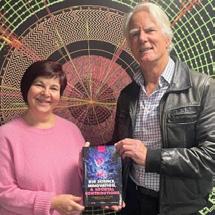
Elisabetta Barberio co-wrote a chapter on ‘The Evolution of Astrophysics Towards Big Science: Insights from the Innovation Landscape’. Geoff Taylor writes about ‘Future of Big Science Projects in Particle Physics- Asian Perspectives’, while Alan Duffy addresses ‘The Evolution of Astrophysics Towards Big Science: Insights from the Innovation Landscape,’. Christine Thong’s chapter explores ‘Knowledge Diffusion by Design: Transforming Big Science Applications.’
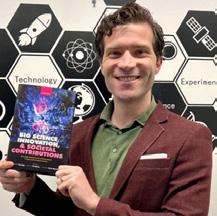
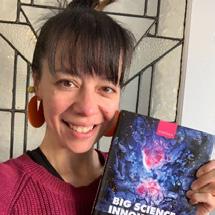
Elisabetta Barberio, Geoff Taylor, Alan Duffy and Christine Thong with copies of the Big Science book.
financial report
Statement of Income and Expenditure for Year ended 31 December 2024, preceding calendar year and estimated budget for 2025
* 2021 - University of Melbourne support for SABRE, 2022 $20,000 National Science Week Grant (UoM_CDM Road Trip), $1,250 National Science Week Grant (ANU_Dark Matter in the Pub), 2023 - $20,000 National Science Week Grant (UOM_CDM Road Trip), $80,000 University of Melbourne DVCR support for SABRE for expenditure in 2024, 2024 - $40,000 University of Melbourne Science Faculty and School of Physics support for SABRE. Funds expended on SABRE along with $80k received in 2023. $2,250 National Science Week Grant (ANU_Dark Matter in the Pub)
^ ANU given $629,596 towards University contributions in 2022 for 2023-2026
# Carryforward includes $2,500,000 of ARC Grant to fund the first six months of 2027 due to Centre starting in August 2020.
In Kind Contributions
# PI Neil Spooner is an Honorary and his in kind time cannot be included in the contributions
www.centredarkmatter.org
@ARC_DMPP
@CDMPP.org
ARC Centre of Excellence for Dark Matter Particle Physics
@arc_cdmpp
